ISSN: 2612-4068
MACHINES
A new environmental certification for scrubber driers
Nuova certificazione ambientale per lavasciuga
TECHNOLOGY
Mobile robots and applications in cleaning industry
Mobile robots e applicazioni nel cleaning
IAQ
Indoor environments and cleaning effectiveness
Valutare l’efficacia di pulizia in ambiente indoor
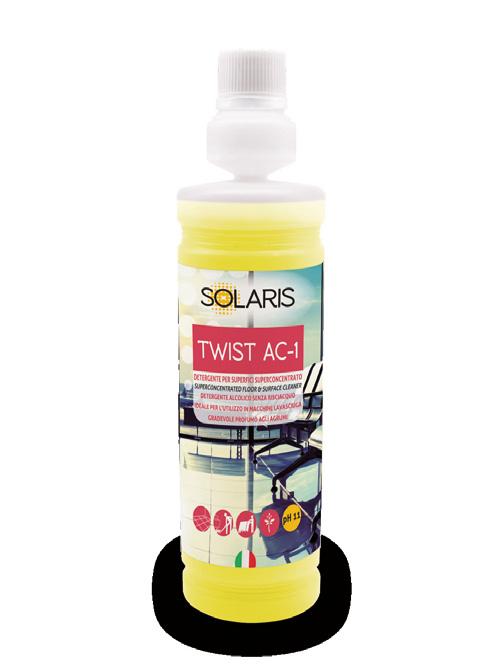



SUPPLEMENTO A DIMENSIONE PULITO MARZO 2024

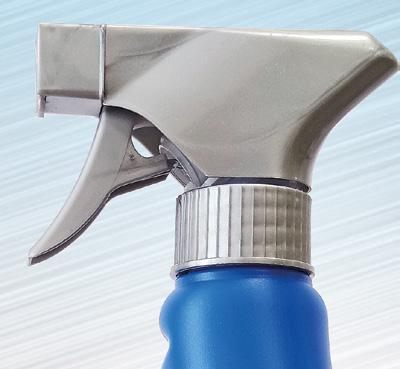
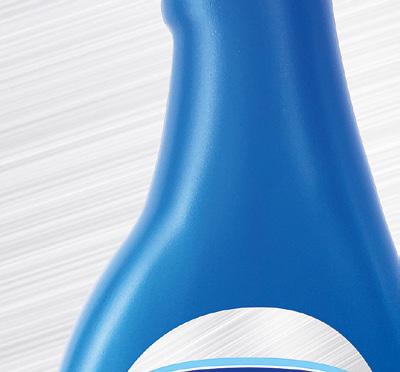
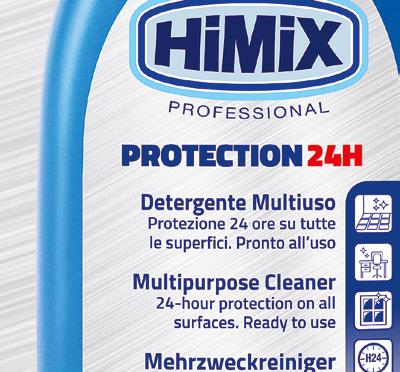









MK spa: agile co-design
MK spa, an Italian company focused on the development of innovative formulas for professional cleaning, has been committed for over 60 years to the research for safe, innovative and effective solutions for the cleaning and the hygiene of professional environments.
The entire supply chain is 100% Italian and every single production phase is internal to the company, guaranteeing a constantly monitored quality: from concept to formulation, from packaging to labelling.
The Research & Development laboratory, also internal to the company, is committed daily to the research and formulation of high-performance products, selecting raw materials of the highest quality and with low environmental impact. The final goal? Investing in innovation
to offer cutting-edge solutions that respect the planet.
MK AND THE PRIVATE LABEL SERVICE
MK spa strongly believes in a partnership based on service and collaborates with companies that want to create customized detergent ranges.
The Private Label service offered by MK involves close
collaboration with partners, building a relationship of trust based on constant dialogue and active listening to offer timely solutions and a tailor-made service that brings a concrete advantage to the business. Therefore, MK collaborates with its partners, supporting them in identifying formulary solutions suitable for their

needs, in the choice of the packaging and in the graphic development of labels as well as in the management of regulatory activities.
Choosing MK means having a reliable partner available, attentive to market needs and ready to support the success of the customer's brand through products entirely "Made in Italy".

MK spa: co-progettazione agile
MK spa, azienda italiana focalizzata sullo sviluppo di formule innovative per il cleaning professionale, si impegna da oltre 60 anni nella ricerca di soluzioni sempre più sicure, innovative ed efficaci per la pulizia e l’igiene degli ambienti professionali. L’intera filiera è 100% italiana e ogni singola fase produttiva è interna all’azienda, garantendo una qualità monitorata costantemente: dal concept alla formulazione, dal confezionamento all’etichettatura. Il laboratorio di Ricerca & Sviluppo, anch’esso interno all’azienda, si impegna quotidianamente nella ricerca e formulazione di prodotti altamente performanti, sele-
zionando materie prime di altissima qualità e a basso impatto ambientale. Obiettivo finale? Investire nell’innovazione per offrire soluzioni all’avanguardia nel rispetto del pianeta.
MK e il servizio di Private Label
MK spa crede fortemente in una partnership basata sul servizio e collabora con aziende che vogliono realizzare linee di detergenza personalizzate. Il servizio di Private Label offerto da MK prevede un’attività di collaborazione a stretto contatto con i partner costruendo una relazione di fiducia basata su un dialogo costante e su un ascolto at-
tivo per offrire soluzioni tempestive e un servizio su misura che porta un vantaggio concreto al business. Pertanto, MK collabora con i propri partner, supportandoli nell’identificazione di soluzioni formulistiche idonee alle loro esigenze, nella scelta del packaging e nello sviluppo grafico delle etichette oltre che nella gestione delle attività regolatorie. Scegliere MK significa avere a disposizione un partner affidabile, attento alle esigenze del mercato e pronto a supportare il successo del marchio del cliente attraverso prodotti interamente “Made in Italy”.
mkspa.com
sponsored content


Scopri il nostro mondo su mkspa.com SISTEMI DI DETERGENZA INNOVATIVI, PER UN MONDO PIÙ ACCOGLIENTE. INNOVATIVE CLEANING SYSTEMS, FOR A MORE WELCOMING WORLD.

Quine Srl Via G. Spadolini, 7 - 20141 Milano
www.quine.it | info@quine.it | Ph. +39 02 864105
Editor-In-Chief
Giorgio Albonetti
Editorial director
Ornella Zanetti | ornella.zanetti@quine.it
Technical director
Maurizio Pedrini
Editorial coordination
Chiara Scelsi - c.scelsi@lswr.it | Ph. +39 349 0099322
Editors Loredana Vitulano - l.vitulano@lswr.it Ph. +39 342 6618995
Cristina Cardinali - c.cardinali@lswr.it Ph.+39 347 4238879
Simone Ciapparelli - s.ciapparelli@lswr.it Ph. +39 344 0571950
Technical scientific consultants for the section
Environmental hygiene
Chiara Dassi - Graziano Dassi
Circulations and subscription service







Contents/Sommario
ON THE COVER / IN COPERTINA
Bettari Detergenti is a Brescia-based historical firm specialized in the production of detergents for the professional sector. The company caters mainly to the Ho.re.Ca, Laundry, Animal Husbandry and Food Industries, Environments and Car Washes sectors, offering a wide choice of Bettari boasts a highly technological and automated production process, which today allows it to remain competitive in the market while maintaining high quality standards. In addition, it is licensed to produce disinfectants (PMC-biocides) and cosmetics.
Ornella Foletti - o.foletti@lswr.it | Ph. +39 342 7968897

Advertising and development

dircom@quine.it
Filippo Viola - f.viola@lswr.it



Guido Rossi - g.rossi@lswr.it
Edoardo Rossi - e.rossi@lswr.it





Elena Brusadelli - e.brusadelli@lswr.it



Graphic design
Paolo Marchetti
Production manager


Antonio Iovene - a.iovene@lswr.it | Ph. +39 349 1811231
Printing Tipolitografia Pagani – Passirano (BS)
Prices and subscriptions
• Annual subscription: 49 euro
• Subscription outside Italy: 160 euro
• Back copies: 17 euro
• Cost of a copy: 1.30 euro abbonamenti.quine@lswr.it | Ph. +39 02 864105 www.quine.it






Bettari Detergenti è una realtà storica bresciana specializzata nella produzione di detergenti per il settore professionale. L’azienda si rivolge principalmente ai settori Ho.re.Ca, Lavanderia, Zootecnia e Industrie Alimentari, Ambienti e Autolavaggi. Bettari vanta un processo produttivo fortemente tecnologico e automatizzato, che oggi le permette di rimanere competitiva sul mercato mantenendo elevati standard qualitativi. Inoltre, è autorizzata alla produzione di disinfettanti (PMC-biocidi) e cosmetici.
COLLABORATORS/HANNO COLLABORATO
Michael A. Berry PhD, Cristina Cardinali, Giorgio Chiaranz, Simone Ciapparelli, Eugene C. Cole DrPH, Karin K. Foarde, Deborah L. Franke, Keith E. Leese PhD, Loredana Vitulano, Maurizio Pedrini, Giacomo Torrenzi, Greg S. Whiteley

www.dimensionepulito.it

Responsibility


Dimensione Pulito is a Monthly Recorded Periodic: Authorization of the Court of Milan No. 598 of 9.11.92 Quine is registered in the Operators Register of Communication n. 12191 of 29/10/2005. The publication or reprint of articles and images must be authorized in writing by the publisher. The articles published on Dimensione Pulito are under the responsibility of the authors. Published manuscripts and drawings will not be returned. INFORMATION PURSUANT TO GDPR 2016/679 Pursuant to art. 13 European Regulation for the Protection of Personal Data 679/2016 below GDPR, the data of all readers will be processed both manually and with IT tools and will be used for sending this and other publications and information and promotional material. The methods of treatment will comply with the provisions of art. 5-6-7 of the GDPR. Data may be disclosed to subjects with whom Quine Srl maintains contractual relationships necessary for sending copies of the magazine. The data controller is Quine Srl, Via G. Spadolini 7 - 20141 Milan, to which the reader can turn to request the update, integration, cancellation e any other operation referred to in articles 15-21 of the GDPR.
© Quine srl - Milan


SURVEY

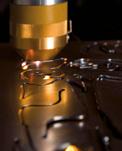
An economy of value for today and the future Un’economia di valore oggi e per il futuro

edited by Simone Ciapparelli
10 20 30
CERTIFICATIONS
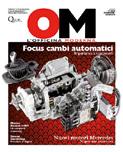

Made Green in Italy: environmental breakthrough for scrubber driers

Made Green in Italy: la svolta ambientale per le lavasciuga pavimenti
Maurizio Pedrini
ROBOTICS
Mobile robots and applications in cleaning industry
Mobile robot e applicazioni nel settore del cleaning
edited by Simone Ciapparelli

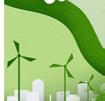


















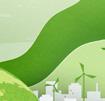












Monthly magazine pubished by
Testata Associata Distribution Quine srl Via G. Spadolini, 7 20141 Milano - Italia Tel. +39 02 864105 Fax. +39 02 70057190 LA GUIDA DA PORTARE SEMPRE CON SÉ PER CONOSCERE TUTTI TRUCCHI DEL MESTIERE LA DISTRIBUZIONE NEGLI IMPIANTI DI RISCALDAMENTO GUIDE dell’Installatore Professionale 7 YOUR INFORMATION PARTNER QUINE COLLABORA CON: www.quine.it Organo ufficiale AiCARR LA RIVISTA PER PROFESSIONISTI DELL’HVAC&R LA RIVISTA PER PROFESSIONISTI DEGLI IMPIANTI HVAC&R Organo Ufficiale AiCARR NORMATIVA Panoramica di inizio anno TAVOLA ROTONDA Conto Termico TEE. che punto siamo? DALLA TEORICA ALLA PRATICA EPB, LE NOVITÀ DELLE NUOVE NORME IMPIANTI AD ARIA PRIMARIA VS VAV FOCUS COMMISSIONING Analisi del processo case study FILTRAZIONE E QUALITÀ DELL’ARIA SOTTORAFFREDDAMENTO ADIABATICO PER LA #42 COMMISSIONING RISPARMIO ENERGETICO NEL TERZIARIO Organo ufficiale ANGAISA LA VOCE PIÙ AUTOREVOLE DEL SETTORE IDROTERMOSANITARIO #251 Bosch riparte CLASSIFICHE 2015 Produttori e distributori: ce la si può fare! FALANGA Quando la differenza TREND bagno che calza pennello www.bluerosso.it LA VOCE AUTOREVOLE DEL CANALE IDROTERMOSANITARIO PIÙ DINAMICA LA PIATTAFORMA ITALIANA DELLA PRODUZIONE MUSICALE E DELL’AUDIO PROFESSIONALE www.audiofader.com WEBSITE AGGIORNATO MAGAZINE MENSILE DIGITALE IVO GRASSO e MASSIVE ARTS Lo studio di modernoregistrazione SALVATORE ADDEO L’amore per l’SSL ALTERNATIVI principi programmazione AVID PRO TOOLS DOCK soluzione per tutti IL PUNTO DI RIFERIMENTO PER CHI OPERA NEL CAMPO DELLA PULIZIA INDUSTRIALE, SANIFICAZIONE E FACILITY MANAGEMENT www.pulizia-industriale.it DA 50 ANNI LA VOCE AUTOREVOLE DEL CLEANING www.casaeclima.com L’INFORMAZIONE EFFICIENTE, COMPLETA E IN TEMPO REALE OLTRE 200.000 UTENTI MESE Organo ufficiale FINCO LA RIVISTA CHE HA PORTATO LA PROGETTAZIONE SOSTENIBILE IN ITALIA MEDAGLIE D’ORO STORIA ITER PROGETTUALE DA NON SOTTOVALUTARE Passo obbligato grande opportunità A SCUOLA DI EFFICIENZA N. 64 Anno dicembre 2016 www.commercioelettrico.com Organo ufficiale FME IL BUSINESS MAGAZINE DEI DISTRIBUTORI E GROSSISTI DI MATERIALE ELETTRICO DAL 1952 IL PERIODICO D’INFORMAZIONE PER INGEGNERI E ARCHITETTI NEWSLETTER – L’AGGIORNAMENTO PROFESSIONALE VIA MAIL Ogni 15 giorni raggiunge oltre 42.000 iscritti R FOCUS SPECIALE Innovazione e cambiamento Un CNI eletto per dare risposte O miliardo per città In USA volano le infrastrutture Eucentre per ricostruire la sicurezza Ancora trattative consultazioni? I pareri degli Ordini dopo l’esito del referendum del dicembre Newsletter QUOTA RINNOVABILI EDIFICI obblighi e proroghe SCIA, operativo il modello unico Tutti rinvii SPECIALE MILLEPROROGHE Top 7 infrastrutturemegadel 2016 LA RIVISTA PER PROGETTARE LA SMART INDUSTRY Organo ufficiale Confapi INFORMAZIONE TECNICO SCIENTIFICA PER LE PMI www.rivistainnovare.it SUBFORNITURA E –------ma d u o---www.ammonitore.com MENSILE DI FORMAZIONE E AGGIORNAMENTO PER IL MECCATRONICO www.MTEDocs.it INFORMAZIONE TECNICHE PER L’AUTORIPARAZIONE MECCANICA&AUTOMAZIONE PERIODICO BUSINESS TO BUSINESS NEL MONDO DELL’INDUSTRIA MECCANICA E DELLE MACCHINE UTENSILI #4maggio 2016 STORIA DI COPERTINA CAD/CAM unico per settore Lamiera IN QUESTO NUMERO INTERVISTA da quarant’anni Generative design, come Sempre più centro www.meccanica-automazione.com IL PORTALE CHE TI GUIDA VERSO LA SMART INDUSTRY TUTTI VOLTI E LE AZIENDE www.terminidellameccanica.com IL TRADUTTORE MULTILINGUE DELLA MECCATRONICA URBAN & PARTNER MILANO (I) WRODAW (PL) GALLARATE (I) PIACENZA (I) TIRANA (AL) SARAGOZZA (ES) MILANO (I) Quine srl Via G. Spadolini, 7 20141 Milano - Italia Tel. +39 02 864105 Fax. +39 02 70057190 YOUR INFORMATION PARTNER QUINE COLLABORA CON: www.quine.it DELL’HVAC&R 42 Organo ufficiale ANGAISA LA VOCE PIÙ AUTOREVOLE DEL SETTORE IDROTERMOSANITARIO Poste italiane Target Magazine LO/CONV/020/2010 Omologazione DCOCI0168 #251 da… Bosch CLASSIFICHE 2015 Produttori e distributori: ce la si può fare! ANTONIO FALANGA Una passione sempre viva DISTRIBUZIONE Quando differenza TREND bagno che ti calza pennello FOCUS Un anno di logistica www.bluerosso.it LA VOCE AUTOREVOLE DEL CANALE IDROTERMOSANITARIO PIÙ DINAMICA LA PIATTAFORMA ITALIANA DELLA PRODUZIONE MUSICALE E DELL’AUDIO PROFESSIONALE www.audiofader.com WEBSITE AGGIORNATO QUOTIDIANAMENTE MAGAZINE MENSILE DIGITALE IVO GRASSO e MASSIVE ARTS Lo studio di modernoregistrazione SALVATORE ADDEO L’amore per l’SSL principi programmazione AVID PRO TOOLS DOCK la soluzione per tutti IL PUNTO DI RIFERIMENTO PER CHI OPERA NEL CAMPO DELLA PULIZIA INDUSTRIALE, SANIFICAZIONE E FACILITY MANAGEMENT www.pulizia-industriale.it DA 50 ANNI LA VOCE AUTOREVOLE DEL CLEANING www.casaeclima.com L’INFORMAZIONE EFFICIENTE, COMPLETA E IN TEMPO REALE OLTRE 200.000 UTENTI MESE Organo ufficiale FINCO LA RIVISTA CHE HA PORTATO LA PROGETTAZIONE SOSTENIBILE IN ITALIA SAIE INNOVATION 2016 FOTOVOLTAICO INTEGRATO UNA SCELTA Passo obbligato grande opportunità A SCUOLA DI EFFICIENZA 64 Anno dicembre 2016 www.commercioelettrico.com Organo ufficiale FME IL BUSINESS MAGAZINE DEI DISTRIBUTORI E GROSSISTI DI MATERIALE ELETTRICO IL PERIODICO D’INFORMAZIONE INGEGNERI E ARCHITETTI L’AGGIORNAMENTO PROFESSIONALE VIA MAIL raggiunge oltre 42.000 iscritti FOCUS politico barcolla, alta l’attenzione sul governo degli ingegneri eletto per dare risposte In USA volano le infrastrutture Eucentre per ricostruire la sicurezza Ancora trattative e consultazioni? Newsletter Programma Corsi di Aggiornamento Professionale RINNOVABILI EDIFICI obblighi e proroghe → pag.37 → pag.3 modellooperativo unico Tutti rinvii SPECIALE MILLEPROROGHE Top infrastrutturemegadel 2016 LA RIVISTA PER PROGETTARE LA SMART INDUSTRY Organo ufficiale Confapi INFORMAZIONE TECNICO SCIENTIFICA PER LE PMI www.rivistainnovare.it MENSILE PER LA SUBFORNITURA E LA PRODUZIONE INDUSTRIALE –-----------–------c n e p m d t---www.ammonitore.com MENSILE DI FORMAZIONE E AGGIORNAMENTO PER IL MECCATRONICO www.MTEDocs.it INFORMAZIONE TECNICHE PER L’AUTORIPARAZIONE MECCANICA&AUTOMAZIONE PERIODICO BUSINESS TO BUSINESS NEL MONDO DELL’INDUSTRIA MECCANICA E DELLE MACCHINE UTENSILI #4maggio 2016 STORIA DI COPERTINA CAD/CAM unico per settore Lamiera IN QUESTO da quarant’anni Generative design, come cambierà mondo SPECIALE Sempre più centro dello sviluppo Macchine misura www.meccanica-automazione.com IL PORTALE CHE TI GUIDA VERSO LA SMART INDUSTRY TUTTI I VOLTI E LE AZIENDE DELLA MECCATRONICA URBAN & PARTNER MILANO (I) WRODAW (PL) GALLARATE (I) PIACENZA (I) TIRANA (AL) 1. Dealers 2. Service companies 3. Food industry 4. Healthcare 5. Public bodies 6. Public businesses 7. Hotellerie 8. Professional laundries 9. Pest management and environmental services 10. Large distribution
10 20
to
2024 www.dimensionepulito.it 30
MADE IN ITALY Supplement
Dimensione Pulito No 2 March





HORECA
Hotel manager: training to build a key figure
Il direttore d’albergo: la formazione di una figura chiave
Maurizio Pedrini
INDOOR AIR QUALITY
Indoor environment and assessment of cleaning effectiveness
Valutazione dell'efficacia di pulizia in ambiente indoor
CIRI (Cleaning Industry Research Institute)
ENVIRONMENT
Green economy, where do we stand?
Green economy, a che punto siamo?
edited by Simone Ciapparelli
PEST CONTROL
Integrated management of murine populations in Genoa
Gestione integrata delle popolazioni murine a Genova
Giorgio Chiaranz
INDEX OF ADVERTISERS/INDICE INSERZIONISTI
4CleanPro 3, 82
Adiatek 38, 39
Bettari Front cover, 83
Comac 18, 19
Essecinque 87
Falpi 84, 85
Filmop 27
Fimap 28, 29
Ghibli & Wirbel 88, 89
Hygenia 8, 86
Ica Tissue 90, 91
India 92, 93
LABOUR MARKET
World Employment and Social Outlook: trends of 2024
Prospettive occupazionali 2024 nel mondo
edited by Giacomo Torrenzi









6, 98
Inside back cover, 99
Polychim 40, 41
100, 101
Rubino Chem Inside cover, 102
48, 49
CONTENTS/SOMMARIO 42 55 62 68
IPC
Kroll
MK
MP-HT 81 Orma
Paperdi
Industrie Celtex 50, 51, 52, 53, 54
Tools 94, 95
Back cover
4, 5
96, 97
Paredes
RCM
TTS
74 74 55
An economy of value for today and the future
Each year, the report "Italy in 10 selfies" tells us some of this country’s strong points which are little-known or underestimated, outlining the features of an economy that is more people-friendly and therefore more feasible
edited by Simone Ciapparelli
The data published in the report from which this article is taken highlights how, thanks to a process of qualitative reconversion of the national production system, fueled by ties with communities and territories, innovation, sustainability and beauty, the value of Italian productions and their competitiveness in exports increased. This applies in many fields, from those recounted in these pages to technologies for space where Italy is third in the world in terms of spe-
cialization index and first in Europe in those related to Earth observation, to technologies to reduce the use of matter and energy in production, to cosmetics. Fifty-five percent of the world's make-up is produced in Italy. Italy's largest steel mill, Arvedi, is the first steel mill in the world certified to have zero net carbon dioxide emissions. And the largest factory for the production of photovoltaic modules in Europe will be built in Italy by Enel. Talents that help to understand the resilience of the
national economy, which is often better than that of other countries, talents from which Italy can start to address not only its ancient ills but the challenges it faces. Starting with the climate crisis. The "Italy in 10 Selfies" report is produced by the Symbola Foundation in collaboration with Unioncamere and Assocamerestero, under the patronage of the Ministry of Foreign Affairs, the Ministry of Environment and Energy Security and the Ministry of Business and Made in Italy.

10 MARCH 2024
SURVEY
01 LEADER IN THE CIRCULAR ECONOMY
Italy is the European country with the highest recycling rate out of the total amount of special and municipal waste produced (83.4 percent), which is higher than the European average (53.8 percent) and that of Germany (70 percent), France (64.5 percent) and Spain (65.3 percent). Italy is second, after France, in terms of second matter use rate - share of second matter in total matter used - at 21.6 percent (+55 percent compared to 2012), compared to a European average of 12.8 percent. In used mineral oil recovery, the regeneration rate reached 98% in Italy in 2021 (in Europe 61%), and in steel there is a recycling production rate of 82% in 2020 (55.7% for EU28, 62% on a global scale). Thanks to the use of second material as a substitute for raw material, 23 million tons of oil equivalent and 63 million tons of CO2 equivalent are avoided each year in Italy.
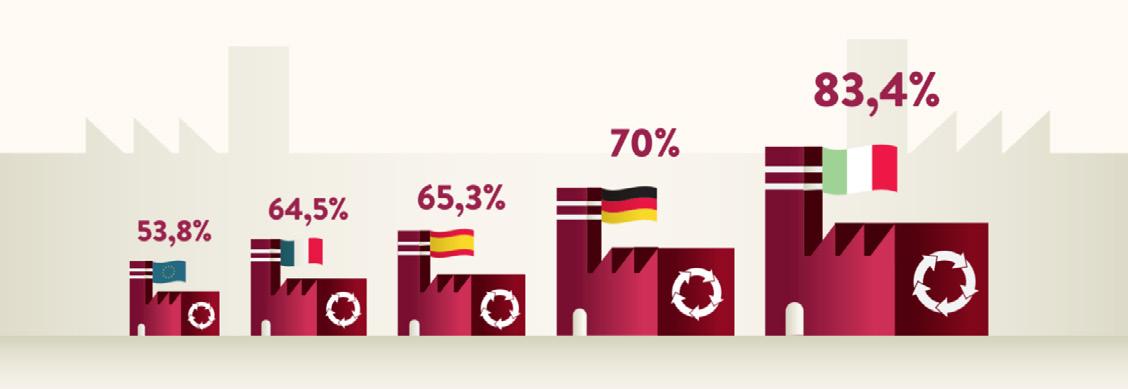
02 GREEN BUSINESSES INCREASE
With a score of 274 points out of 300, Italy ranks first in Europe in the index of efficiency in using resources. A composite indicator that highlights the ability to produce goods while reducing the use of raw materials, water, energy and the intensity of GHG emissions. A figure higher than the EU average (147 points) and that of Germany (167), France (162) and Spain (131). Italy between 2012 and 2021 increased productivity in the use of raw materials from 161 points to 269, compared with an EU average of 151. In Italy, more than 1 in 3 non-farm enterprises (531,170) have made eco-investments in the last five years. These enterprises are growing more, exporting more, and generate more employment.
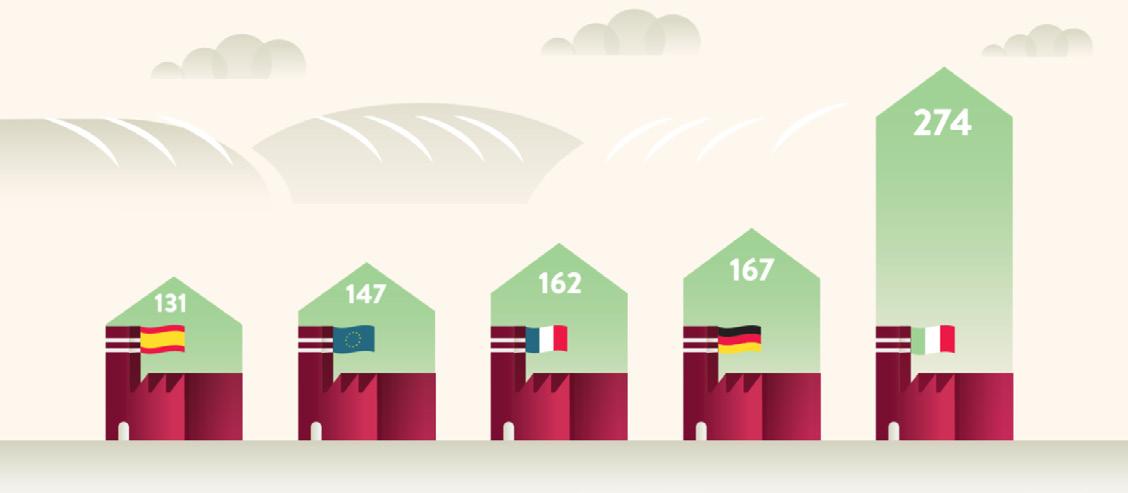

11 MARCH 2024
03 THE WORLD'S LARGEST OPERATOR IN THE RENEWABLES IS ITALIAN
Enel is the world's largest private renewable operator with 53.4 GW of managed capacity in 2021 from wind, solar, geothermal and hydroelectric plants located in Europe, the Americas, Africa, Asia and Oceania. For 2022, the closing estimate is 59 GW, representing 67 percent of total generation. As of December 31, 2022, Enel's market capitalization stood at 51.1 billion in value. Enel's ongoing commitment to sustainability is evidenced by recognition among the leaders in major ESG ratings, such as the Dow Jones Sustainability World Index and the MSCI World ESG Leaders. Enel is building in Catania, Italy the largest photovoltaic module production plant in Europe, which when fully operational will have a production capacity of 3GW per year, more than the entire Europe produces today.
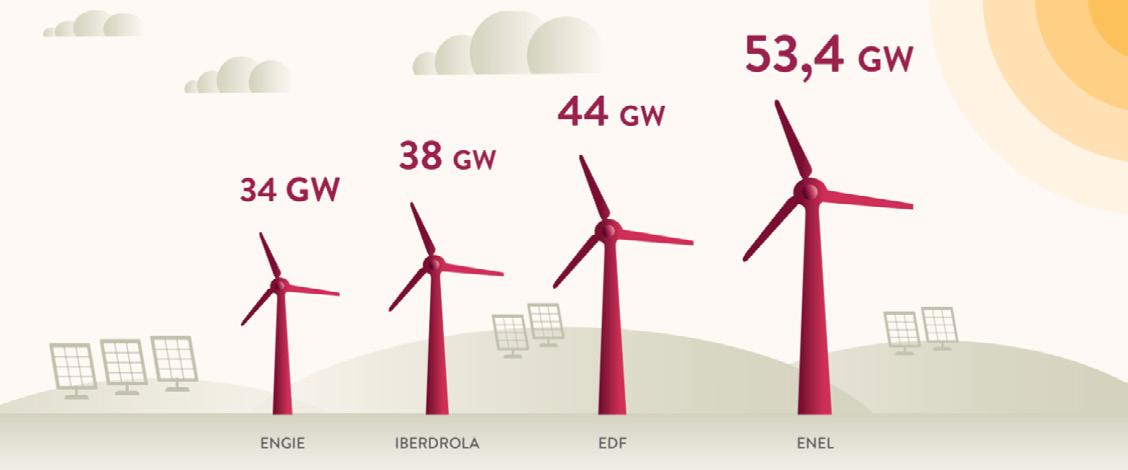
04 DESIGN AND BEAUTY KEYS TO MADE IN ITALY
Italy ranks first in Europe by turnover in the Design sector with €4.15 billion (19.9 percent of the EU total), followed by Germany (€3.96 billion), France (€2.22 billion), the Netherlands (€2.19 billion) and Sweden (€1.95 billion). It confirms its supremacy among the large EU countries in the number of companies, 36,131 realities (16.2%), spread throughout the country to build a real infrastructure of Made in Italy. One in 5 workers active in the sector in Europe is Italian (54,284 workers or 19.1% of the EU total). The world's largest event dedicated to design, the Salone del Mobile in Milan, is Italian. Design and beauty are a key to Made in Italy.


12 MARCH 2024
SURVEY
05 ITALIAN SHIPBUILDING FIRST IN THE WORLD BY COMMERCIAL BALANCE
Italy ranks first in the world in terms of trade balance in the shipbuilding sector with a value of $3.1bn (+$1bn over 2020), followed by the Netherlands ($1.5bn), Germany ($1.3 bn), Poland ($0.9 bn) and Britain ($0.7 bn). First position also for balance in recreational or sport boats and yachts with inboard engines, with a value of $3.04 bn, followed by the Netherlands ($1.46 bn). Regarding the superyacht category, Italy as of December 31 2022 recorded orders accounting for 49.3 percent of the world total (593 in absolute value), up 13 percent compared to the previous year.

06 LEADERSHIP IN WINE PRODUCTION AND CERTIFIED PRODUCTIONS
Italy confirmed its world leadership in wine production in 2021 (50.2 mln hl), ahead of France (37.6) and Spain (35.3), a result also achieved thanks to its 526 PDOs and PGIs, which account for 55 percent of production. The year 2021 was a record year for Italian wine exports with a turnover of 7.1 billion euros (+12.4 percent over 2020), accounting for 14 percent of agrifood exports. In Italy there are 109,423 hectares (2019) of organic area devoted to vines, 98% of which are vines for wine grapes. We are first in Europe and the world in the number of PDO, PGI, TSG certified products: 881 geographical indications, including 526 Wines, 320 Foods and 35 Spirits.
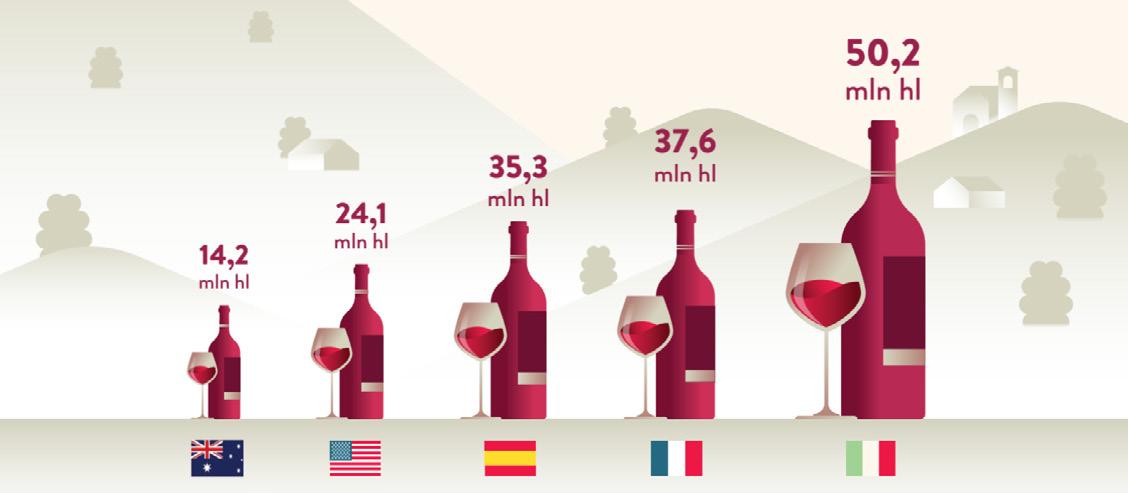

13 MARCH 2024
07 WORLD LEADER IN THE EXPORT OF DEVICES FOR HOT BEVERAGE PREPARATION AND FOOD COOKING
Italy ranks first in the world in export value of professional appliances and devices for the preparation of hot drinks or for cooking or heating food ($1.2 billion), followed by Germany ($974 mln), the United States ($650 mln), Switzerland ($627 mln) and China ($520 mln). This category includes professional coffee machines, a sector in which Italy boasts a production value of €500 million, 75 percent of which goes to exports (€375 million). There are more than 1,000 Italian companies active in the roasting world.
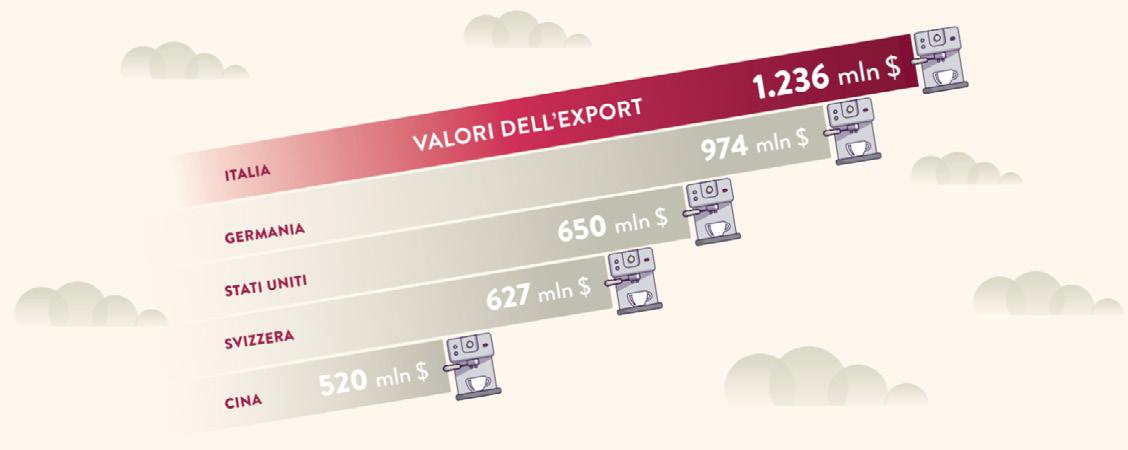
08 ULTRAVIOLET AND INFRARED TECHNOLOGIES IN THE MEDICAL FIELD
Italy, with €195.3 mln, is the world's leading exporter of ultraviolet or infrared equipment for medical/surgical use, followed by the United States (€123.3 mln), the Republic Dominican Republic (€42.9 mln), Malaysia (€42.7 mln) and Germany (€31.2 mln). This leadership strengthened during the pandemic by registering a change between 2019 and 2021 of +44.0%, coming to represent 31.8 percent of world exports of this category of medical-surgical equipment. More generally, Italy is second in Europe in the medical devices sector by number of employees (118,837), behind Germany (235,000), ahead of Great Britain (106,500), France (88,000) and Switzerland (63,000). Our country employs 15.1 percent of the employed in the sector on the continent.
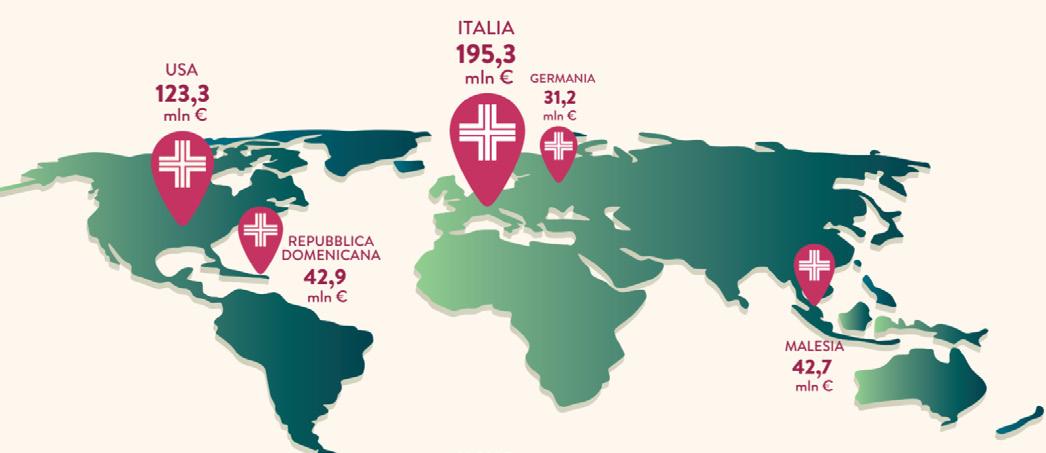

14 MARCH 2024
SURVEY
Source: Fondazione Symbola, “L’italia in 10 selfie”. Dati 2023
UN'ECONOMIA DI VALORE OGGI E
PER IL FUTURO
Ogni anno, il rapporto "L'Italia in 10 selfie" racconta alcuni punti di forza della Penisola che sono poco conosciuti o sottovalutati, delineando i tratti di un'economia più a misura d'uomo e quindi più realizzabile
a cura di Simone Ciapparelli
Idati pubblicati nel report dal quale è tratto questo articolo evidenziano come proprio grazie ad un processo di riconversione qualitativa del sistema produttivo nazionale, alimentato da legami con le comunità e i territori, innovazione, sostenibilità, bellezza sia aumentato il valore delle produzioni italiane e la loro competitività nell’export. Vale in molti campi, da quelli raccontati in queste pagine alle tecnologie per lo spazio dove l’Italia è terza al mondo per indice di specializzazione e prima in Europa in quelle legate all’osservazione della Terra, alle tecnologie per ridurre l’impiego di materia ed energia nelle produzioni, alla cosmetica. Il 55% del make-up mondiale è prodotto in Italia. La maggiore acciaieria italiana, Arvedi, è la prima acciaieria al mondo certificata a zero emissioni nette di anidride carbonica. E sorgerà in Italia ad opera di Enel la più grande fabbrica per la produzione di moduli fotovoltaici d’Europa. Talenti che aiutano a capi-

re la buona tenuta dell’economia nazionale, spesso migliore di quella di altri paesi, talenti da cui l'Italia può partire per affrontare non solo i suoi mali antichi ma le sfide che abbiamo davanti. A cominciare dalla crisi climatica. Il report “Italia in 10 selfie” è realizzato da
01 LEADER NELL’ECONOMIA CIRCOLARE
Fondazione Symbola in collaborazione con Unioncamere ed Assocamerestero, con il patrocinio del Ministero degli Affari esteri, del Ministero dell’Ambiente e della Sicurezza Energetica e del Ministero delle Imprese e del Made in Italy.
L’Italia è il Paese europeo con il più alto tasso di riciclo sul totale dei rifiuti speciali e urbani prodotti (83,4%), un valore superiore alla media europea (53,8%) e a quello di Germania (70%), Francia (64,5%) e Spagna (65,3%). L'Italia è seconda, dopo la Francia, per tasso d’uso di materia seconda - quota di materia seconda su totale materia impiegata - pari al 21,6% (+55% rispetto al 2012), a fronte di una media europea del 12,8%. Nel recupero dell’olio minerale usato, il tasso di rigenerazione ha raggiunto in Italia il 98% nel 2021 (in Europa 61%) e nell’acciaio si registra un tasso di produzione da riciclo pari all’82% nel 2020 (55,7% per UE28, 62% su scala mondo). Grazie all’impiego di materia seconda in sostituzione di materia prima, ogni anno vengono evitate in Italia 23 milioni di tonnellate equivalenti di petrolio e 63 milioni di tonnellate equivalenti di CO 2


15 MARCH 2024 RICERCA

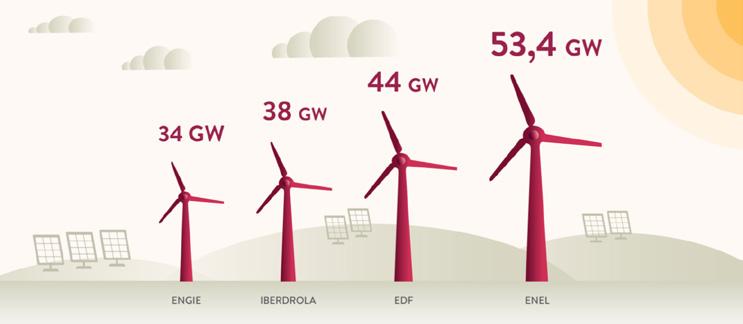

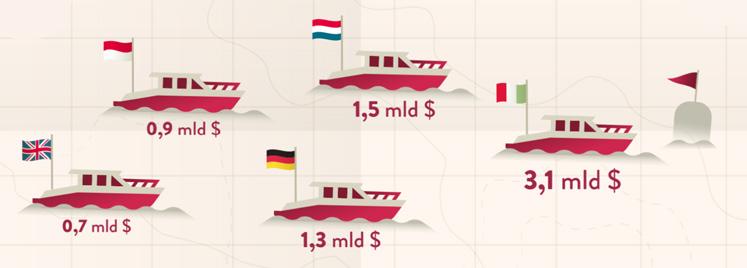
02 AUMENTANO
LE IMPRESE GREEN
Con un punteggio di 274 punti su 300, l’Italia è prima in Europa per indice di efficienza nell’impiego delle risorse. Un indicatore composito che evidenzia la capacità di produrre beni riducendo l’impiego di materie prime, acqua, energia e l’intensità delle emissioni di gas ad effetto serra. Un dato superiore alla media UE (147 punti) e a quello di Germania (167), Francia (162) e Spagna (131). L’Italia tra 2012 e 2021 ha aumentato la produttività nell’uso di materie prime da 161 punti a 269, contro una media UE di 151. In Italia più di una impresa extra-agricola su 3 (531.170 unità) ha effettuato eco-investimenti negli ultimi cinque anni. Queste imprese crescono di più, esportano di più, generano più occupazione.
03 È ITALIANO
IL PIÙ GRANDE
OPERATORE AL MONDO
NELLE RINNOVABILI
Enel è il più grande operatore privato al mondo nel settore delle rinnovabili con 53,4 GW di capacità gestita nel 2021 proveniente da impianti eolici, solari, geotermici e idroelettrici localizzati in Europa, Americhe, Africa, Asia e Oceania. Per il 2022, la stima di chiusura è pari a 59 GW, che rappresenta il 67% della produzione totale. Al 31 dicembre 2022, la capitalizzazione di mercato di Enel si è attestata a 51,1 miliardi di valore. Il costante impegno di Enel in tema di sostenibilità è testimoniato dal riconoscimento tra i leader nei principali rating ESG, come il Dow Jones Sustainability World Index e il MSCI World ESG Leaders. Enel sta costruendo a Catania il più grande impianto di produzione di moduli fotovoltaici d’Europa che a regime avrà una capacità produttiva di 3GW all’anno, più di quanto oggi produce l’intera Europa.
04 DESIGN E BELLEZZA
CHIAVI DEL MADE IN ITALY
L’Italia è prima in Europa per fatturato nel settore del Design con € 4,15 miliardi (19,9% sul totale UE), seguita da Germania (€ 3,96 mld), Francia (€2,22 mld), Paesi Bassi (€2,19 mld) e Svezia (€1,95 mld). Si conferma il primato tra i grandi Paesi UE per numero di imprese, 36.131 realtà (16,2%), diffuse sul territorio nazionale a costruire una vera e propria infrastruttura del Made in Italy. Un addetto su 5 attivo in Europa nel settore è italiano (54.284 lavoratori pari al 19,1% del totale UE). È italiano il più grande evento al mondo dedicato al design, il Salone del Mobile di Milano, arrivato quest’anno alla sua 61° edizione. Design e bellezza sono una chiave del Made in Italy.
05 CANTIERISTICA
NAUTICA ITALIANA AL TOP
L’Italia è prima al mondo per saldo della bilancia commerciale nel settore della cantieristica nautica con un valore pari a $3,1 miliardi (+$1 mld sul 2020), seguita da Paesi Bassi ($1,5 mld), Germania ($1,3 mld), Polonia ($0,9 mld) e Gran

16 MARCH 2024
RICERCA
Bretagna ($0,7 mld). Prima posizione anche per saldo nelle barche e yacht da diporto o da sport con motore entrobordo, con un valore di $3,04 miliardi, seguita dai Paesi Bassi ($1,46 mld). Per quanto riguarda la categoria dei superyacht, l’Italia al 31 dicembre 2022 ha registrato ordini pari al 49,3% del totale mondiale (593 in valore assoluto), +13% rispetto all’anno precedente.
06 LEADERSHIP NELLA
PRODUZIONE DI VINO E PRODOTTI CERTIFICATI
L’Italia conferma nel 2021 la leadership mondiale nella produzione di vino (50,2 mln hl), precedendo Francia (37,6) e Spagna (35,3), risultato ottenuto anche grazie alle sue 526 DOP e IGP che rappresentano il 55% della produzione. Il 2021 è stato un anno record per l’export del vino italiano con un fatturato di 7,1 miliardi di euro (+12,4% sul 2020), pari al 14% dell’export agroalimentare. In Italia sono 109.423 gli ettari (2019) di superficie biologica destinati alla vite, di cui il 98% per viti per uva da vino. Siamo primi in Europa e nel mondo per numero di prodotti certificati DOP, IGP, STG: 881 indicazioni geografiche, di cui 526 Vini, 320 Cibi e 35 Bevande Spiritose.
07 DISPOSITIVI PER LA PREPARAZIONE DI BEVANDE CALDE E COTTURA ALIMENTI
L’Italia è prima al mondo per valore dell’export di apparecchi e dispositivi professionali per la preparazione di bevande calde o per la cottura o il riscaldamento degli alimenti ($1,2 mld), seguita da Germania ($974 mln), Stati Uniti ($ 650 mln), Svizzera ($627 mln) e Cina ($ 520 mln). Di questa categoria fanno parte le macchine da caffè professionali, un settore in cui l’Italia vanta un valore della produzione pari a € 500 milioni, di cui il 75% destinato all’export (€ 375 milioni). Sono oltre 1.000 le imprese italiane attive nel mondo delle torrefazioni.
08 ULTRAVIOLETTI E INFRAROSSI IN AMBITO MEDICO
L’Italia con €195,3 mln è il primo esportatore al mondo di apparecchi a raggi ultravioletti o infrarossi per utilizzo medico-chirurgico, seguita da Stati Uniti (€123,3 mln), Repubblica Dominicana (€42,9 mln), Malesia (€42,7 mln) e Germania (€31,2 mln). Questo primato si è rafforzato durante la pandemia registrando una variazione tra 2019 e 2021 del +44,0%, arrivando a rappresentare il 31,8% delle esportazioni mondiali di questa categoria di apparecchi medico-chirurgici. Più in generale l’Italia è seconda in Europa nel comparto dei dispositivi medici per numero di occupati (118.837), dietro la Germania (235.000), davanti a Gran Bretagna (106.500), Francia (88.000) e Svizzera (63.000). Lavora nel nostro Paese il 15,1% degli occupati del settore nel continente.
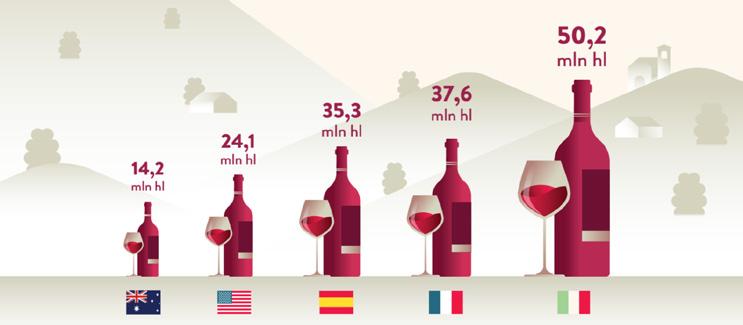
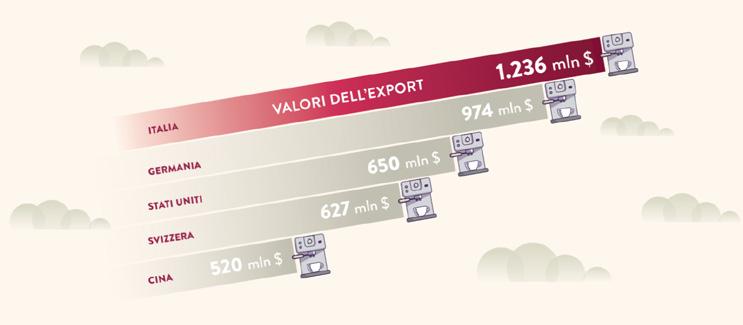
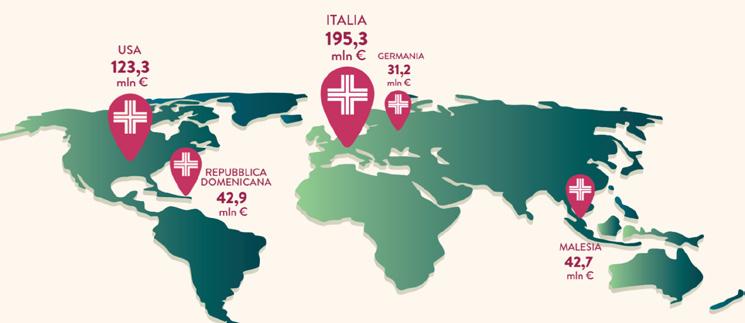
Ulteriori punti di forza: moda e prodotti sportivi
L’Italia è il primo esportatore in UE e il secondo al mondo, dopo la Cina (€347 mld), di prodotti del Tessile, Moda e Accessorio (TMA), con un valore dell’export pari a € 66,6 miliardi, prima di Vietnam (€52,8 mld), India (€47,8 mld) e Germania (€47,5 mld). Nel 2021 il Paese ha registrato un saldo attivo di 33,2 miliardi di euro. Quello della Moda è il secondo settore per contributo alla bilancia commerciale italiana, con una propensione all’export attorno al 75% del fatturato. Nel comparto TMA l’Italia è il primo Paese UE, sia per valore aggiunto che per numero di occupati. Infatti, il 26,3% degli addetti europei del comparto è italiano (uno su quattro), seguono Portogallo (9,7%), Polonia (9,3%), Romania (8,8%) e Germania (8,1%). L’Italia è protagonista nello sportsystem europeo, unica tra i grandi Paesi europei con saldo positivo della bilancia commerciale di prodotti sportivi con €894,1 milioni. Il valore dell’export italiano è pari a €3.264 milioni (quarta in Europa), di cui circa un quarto legato alle calzature sportive, un 20% alle attrezzature per ginnastica, atletica e nuoto, e un 15,8% relativo ad attrezzature per barche e sport acquatici.
Fonte: Fondazione Symbola, “L’italia in 10 selfie”. Dati 2023

17 MARCH 2024
Comac: 50 years of innovations in professional floor cleaning

Comac celebrates its 50th anniversary this year, a great achievement that highlights many years of excellence and innovation in the professional cleaning sector. Since 1974, Comac
has been able to face many challenges, from the changing of market to the evolution of sales techniques, establishing a strong and solid link with customers and suppliers.
The waste of resources and the reduction of the environmental impact of cleaning operations are key topics of the company’s activity. The machines included in the range, in fact, respect the
environment and involve the user in responsible use of resources, offering an immersive experience and unmatched simplicity.
Today more than ever, the continuous research and the introduction of increasingly innovative technologies make Comac machines suitable for use in different sectors in order to meet even the most specific needs. The company’s history is characterized by a great dedication to quality and innovation.
Over the years, large investments have been made in research and development, which have allowed Comac to design SELF.Y, the company’s great proposal for autonomous cleaning, designed to be a collaborative and intelligent cleaning partner that combines performance and productivity to take cleaning operations to the next level. SELF.Y
Comac: cinquant’anni di innovazioni nella pulizia professionale dei pavimenti
Comac celebra quest’anno il suo cinquantesimo anniversario, un grande traguardo che mette in risalto i numerosi anni di eccellenza e innovazione nel settore della pulizia professionale. Dal 1974 Comac è stata capace di affrontare molte sfide, dal cambiamento del mercato, all’evoluzione delle tecniche di vendita, instaurando un legame forte e solido con clienti e fornitori. Lo spreco delle risorse e la riduzione dell’impatto ambientale delle operazioni di pulizia sono
argomenti cardine dell’attività dell’azienda. Le macchine presentate in gamma, infatti, rispettano l’ambiente e coinvolgono l’utilizzatore a un uso responsabile delle risorse, offrendo un’esperienza d’uso immersiva e una semplicità senza eguali. Oggi più che mai la continua ricerca e l’introduzione di tecnologie sempre più innovative rendono le macchine Comac indicate per un utilizzo in diversi settori al fine di soddisfare anche le necessità più specifiche.
La storia dell’azienda è caratterizzata da una grande dedizione a qualità e innovazione. Nel corso degli anni sono stati effettuati grandi investimenti in ricerca e sviluppo, che hanno permesso a Comac di progettare SELF.Y, la grande proposta dell’azienda per la pulizia autonoma, pensato per essere un compagno di pulizia collaborativo e intelligente, capace di combinare prestazioni e produttività per innalzare il livello degli interventi. SELF.Y sa adattarsi al meglio a
sponsored content

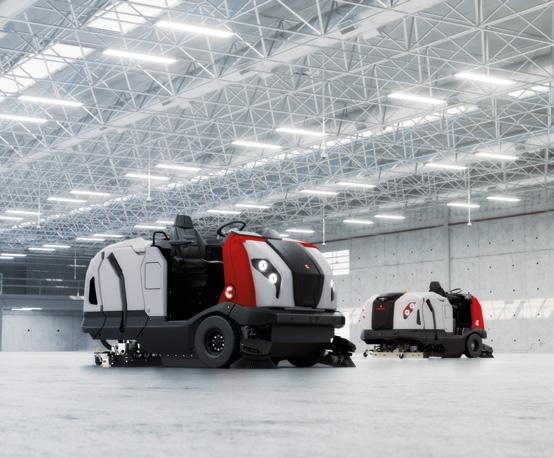
knows how to adapt best to every situation and integrate perfectly into the team dedicated to the maintenance of the environments, detecting people and obstacles that are on his track to offer effective and effortless cleaning. Easy to configure, even by less experienced operators, thanks to the convenient interactive display, SELF.Y never stops learning and with its innovative technologies it is able to adapt in real time to the surrounding environment. Perfect combination of performance SELF.Y works in
complete autonomy and safety, taking cleaning operations to a higher level. To maintain the high quality standards of the company and continue to meet the changing needs of the market, Comac has designed Combimac, a new combined machine, which is born from the union on a single frame of all the knowledge of Comac regarding scrubbing machines and sweepers. Able to combine the characteristics of a floor scrubber with those of industrial sweepers, Combimac offers high performance in
ogni situazione e integrarsi perfettamente nel team dedicato alla manutenzione degli ambienti, rilevando persone e ostacoli che si trovano sulla sua pista di lavoro per offrire una pulizia efficace e senza sforzo. Semplice da configurare, anche da parte degli operatori meno esperti, grazie al comodo display interattivo, SELF.Y non smette mai di imparare e con le sue innovative tecnologie riesce ad adattarsi in tempo reale all’ambiente che lo circonda. Perfetta combinazione di rendimento e performance, SELF.Y lavora in completa autonomia e sicurezza, portando le operazioni di pulizia
terms of cleaning efficiency and ergonomics, increasing productivity. Designed to meet the demands of different sectors, Combimac is equipped with a separate double action system consisting of a sweeping structure equipped with two side brushes which convey dirt and solid debris to the central part of the machine and
a scrubbing system made up of four disc brushes. These new projects are just an example of Comac’s ongoing commitment to innovation, but they also represent a constant affirmation of the company’s desire to evolve and continue to grow over the years, responding to the needs of cleaning professionals.

a un livello superiore.
Per mantenere gli elevati standard qualitativi aziendali, e continuare a soddisfare le mutevoli esigenze del mercato, è stata progettata anche Combimac, una nuova macchina combinata, che nasce dall’unione su un unico telaio di tutte le conoscenze di Comac in merito a lavasciuga pavimenti e spazzatrici. Capace di fondere in un solo modello le caratteristiche delle lavasciuga pavimenti con quelle delle spazzatrici, Combimac offre elevate prestazioni in termini di pulizia, efficienza ed ergonomia raddoppiando la produttività. Pensata
per soddisfare le richieste di diversi settori, Combimac è dotata di un sistema a doppia azione separata composto da una struttura spazzante capace di convogliare nella parte centrale sporco e detriti solidi, e un apparato lavante composto da quattro spazzole a disco. Questi nuovi progetti sono solo un esempio del continuo impegno di Comac verso l’innovazione, ma rappresentano anche un’affermazione costante del desiderio dell’azienda di evolversi e continuare a crescere negli anni rispondendo alle esigenze dei professionisti del pulito.
comac.it
SELF.Y, a professional floor scrubbing robot
Combimac, a new combined machine

Made Green in Italy Environmental breakthrough for scrubber driers
Manufacturing companies in the sector will be able to start the certification process according to the Made Green in Italy scheme of MASE, Ministry of Environment and Energy Security, and drafted by Afidamp. The new label was presented during an attended webinar
Maurizio Pedrini journalist and technical director of Dimensione Pulito
Green imprinting officially enters the production of scrubber-dryers with its own valuable imprinting. In fact, thanks to the special new CPR Rule drafted by AFIDAMP (Association of Italian Manufacturers and Distributors of Machinery, Products and Tools for Professional Cleaning and Environmental Hygiene), the many, important Made in Italy companies at the top of the world in the production of these irreplaceable machines for cleaning and sanitizing surfaces, will be able to start the certification process following the Made in Italy scheme of MASE, Min-

istry of Environment and Energy Security. The scheme was introduced to first assess and communicate the environmental footprint of products in the supply chain. Based on the PEF (Product Enviromental Footprint) methodology, which complies with the European Commission's Recommendation 2020/2279/EU, it interprets a precise indication basically placed at the foundation of policies in favor of improving the resource efficiency of the environmental impact of products and their life cycle. Made Green in Italy mark is the first voluntary environmental certification that can be obtained for
machines in the professional cleaning sector, allowing for an objective and, above all, measurable assessment of the environmental footprint of scrubbers throughout their entire life cycle.
A step forward for businesses
We are, in short, in front of an epoch-making step forward that allows for the introduction of a precise orientation in business production: that of associating Italian quality manufacturing with the message of the environment and sustainability seen, not only, as tools for enhancing the territory and the environment but also as a device
20 MARCH 2024
CERTIFICATIONS



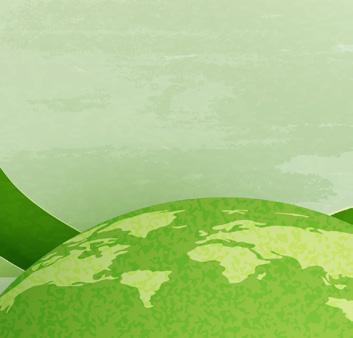


to be used to differentiate oneself on the market, truly developing the circular economy. The webinar, which was strongly attended by both manufacturing and distribution companies, members and non-members, as well as service companies, had the merit of clearly illustrating the enormous development potential that lies ahead for companies engaged in the manufacture of scrubber-dryers. Matteo Malorgio, from the Ministry of Environment and Energy Security, explained that through the MGI scheme, the Ministry wants to direct the initiatives of the Italian production system toward the use of the environmental footprint as a lever for improving environmental performance and enhancing the value of Made in Italy, in order to promote the competitiveness of Italian products in the context of the growing national and international demand for products with high
environmental qualification.
The opportunities for manufacturers
During the webinar, the potential of the new scheme and the scenario of opportunities ahead for producers were explained. In fact, MGI is the only certification based on the European PEF methodology implemented by a national government, which has chosen to fully transpose the European calculation rules, on which, however, it has grafted additional and more ambitious national environmental quality requirements that can distinguish Italian production. This is the only certification that integrates requirements that require companies adhering to the scheme to communicate the environmental footprint of products to their customers and consumers (typical of Type 3 Labels, standardized by ISO
14025), with requirements that allow access to the scheme only to excellent products, able to exceed performance thresholds and, in particular, to be better than the average representative product in its category (typical of Type 1 Labels, standardized by ISO 14024). During the webinar Nicola Fabbri, senior consultant ERGO Srl, a spinoff company of the Scuola Superiore Sant'Anna of Pisa, explained companies which attended the webinar all the steps necessary to obtain the certification, highlighting those who can obtain the Made Green in Italy label. "The environmental footprint assessment study," Fabbri explained, "expresses, through a numerical value, the environmental indicators related to the three main impact categories identified by the relevant CPR. This value is compared with the value of the benchmark defined within the same CPRs."

21 MARCH 2024

Management of environmental aspects
Certification, made possible through the formulation of the Scrubber Product Category Rule by AFIDAMP and its Machinery Working Group, enables companies that obtain it to offer guarantees on how they manage their environmental aspects and maintain regulatory compliance over time, precisely because the companies themselves commit to undergo periodic independent third-party audits, to invest resources in the continuous improvement of environmental performance and, therefore, in the reduction and prevention of pollution, also to meet performance requirements that evolve over time, becoming progressively more ambitious and taking charge of environmental protection at the production and social levels. In essence, the Regulations thus provide for a classification of products into three

performance classes: performance better than the benchmark; performance equal to the benchmark; and performance worse than the benchmark. Products with environmental performance equal to or better than the benchmark are eligible for the MGI label (referred to as Class A and B products). Class B products can obtain use of the logo, but must include an improvement plan to be implemented over the three-year period of the use concession. The new CPR thus lays the groundwork not only for creating important new commercial levers for Italian companies in the sector, but also for adopting conscious environmental choices and increasing the weight of Italian companies in European institutional contexts, thanks in part to the efforts that MASE is pursuing in creating qualifying pathways for the Italian business environment and Made in Italy.
The efforts of the AFIDAMP regulatory working group
"The work carried out by AFIDAMP to arrive at this result," said Alessandro Panico, AFIDAMP Regulator and Secretary of the CEI 59/61J Subcommittee, "has been articulated and complex, but we are proud to have created a Rule that has identified shared values based on European standards. This has been possible thanks to the synergistic work of our technical secretariat, member companies with the wise direction of ERGO, and will allow companies to present themselves with a certification of great value on the Italian market and also on international ones." Panico also anticipated important agreements between AFIDAMP and some certification bodies in order to make the economic commitment less burdensome for member companies.
22 MARCH 2024
CERTIFICATIONS
A comprehensive environmental management system
At the
end of the meeting,
we collected the opinion of Nicola Fabbri, senior consultant ERGO Srl, a spin-off company of the Scuola Superiore Sant'Anna of Pisa
Maurizio Pedrini
How satisfied are you with the work done with AFIDAMP?
We have worked very well: the Product Category Rule for the Made Green in Italy label represents an innovation that introduces not only an advanced type of environmental certification, but also an element of environmental performance against a benchmark, thus incentivizing the producer market to identify best practices. This aspect is truly innovative, as it associates the idea of the Made in Italy brand representing one of the great worldwide excellences of our country with the idea of being green, which entails the idea of being green in practice by improving performance well above the average of companies in a certain sector.
 Nicola Fabbri, Senior consultant ERGO Srl
Nicola Fabbri, Senior consultant ERGO Srl
Are there any other relevant aspects to highlight?
Definitely worth mentioning is the opportunity for many companies that have taken part in the Rule's definition work to start thinking about a truly comprehensive environmental management system, because today the company is required not only to simply certify the system, but also to integrate precise sustainability parameters, comply with international regulations, and set aligned targets, both European-specifically within the EU framework-and the so-called Global Compact, i.e., a sustainable global economy that respects human and labor rights, but also environmental protection and the fight against corruption.
So are we facing an unprecedented kind of company approach, which needs to evolve radically?
Certainly, because the company itself absolutely has to think about how to build an environmental accounting. So it should be emphasized, in the clearest terms, that it is not enough just to have the Made in Green in Italy certification or label, or the sustainability report: rather, what is needed is an integration of all these elements in which, even the company-this at least represents the ultimate goal-in its bill
of materials, can directly introduce the elements of environmental impact itself. For example, associating water consumption or CO2 emissions, with the manufactured machine or the product itself.
Is a qualitative leap beyond traditional certification required, then? Yes, in that you are really going to say that an impact analysis has been built on that product, and on that one is also able to make a kind of unprecedented eco-design, with alternative choices of materials that not only allow one to considerably reduce the impact generated, but also to introduce indicators that allow for improvement. I'm thinking, for example, of the use of plastic, in that I don't necessarily have to use less of it in the product, it's enough for me even to use recycled plastic. Sometimes, in fact, it is better to use 100 percent recycled plastic than a kilo of regular plastic. These indicators are introduced precisely through the work process that we have carried out with AFIDAMP.

23 MARCH 2024
MADE GREEN IN ITALY: LA SVOLTA AMBIENTALE PER LE LAVASCIUGA PAVIMENTI
Le aziende produttrici di settore potranno avviare il processo di certificazione secondo lo schema Made Green in Italy del MASE, Ministero dell’ambiente e della Sicurezza Energetica, e redatto da Afidamp. Il nuovo marchio è stato presentato durante un partecipato webinar
Maurizio Pedrini giornalista e direttore tecnico di Dimensione Pulito
L'impronta green entra a far parte ufficialmente, con il proprio prezioso imprinting, nella produzione delle lavasciuga pavimenti. Infatti, grazie alla nuova apposita Regola RCP redatta da AFIDAMP (Associazione dei Fabbricanti e Distributori Italiani di Macchine, Prodotti e Attrezzi per la Pulizia Professionale e l'Igiene degli ambienti), le tante, importanti aziende del Made in Italy al vertice mondiale nella produzione di queste insostituibili macchine per la pulizia e l’igienizzazione delle superfici, potranno avviare il processo di certificazione seguendo lo schema made
in Italy del MASE, Ministero dell’Ambiente e della Sicurezza Energetica. Lo schema è stato introdotto per valutare e comunicare anzitutto l’impronta ambientale dei prodotti della filiera. Basato sulla metodologia PEF (Product Enviromental Footprint), conforme alla raccomandazione 2020/2279/UE della Commissione Europea, interpreta una precisa indicazione posta sostanzialmente a fondamento delle politiche a favore del miglioramento della resource efficiency dell’impatto ambientale dei prodotti e del ciclo di vita degli stessi. La nuova Regola stilata da AFIDAMP è stata presentata con un assai partecipato live webinar dal titolo Certificazione Made Green in Italy per Lavasciugapavimenti alla presenza di un pubblico numeroso e molto interessato. Va detto subito che la nuova Regola di Categoria di Prodotto, già validata dal Ministero dell’Ambiente e pubblicata sul sito, permetterà alle aziende produttrici di macchine Lavasciugapavimenti di



avviare il processo di certificazione secondo lo schema Made Green in Italy. Grazie alla RCP di Afidamp, il marchio Made Green in Italy è la prima certificazione volontaria ambientale che può essere ottenuta per macchine del settore cleaning professionale, che permette di valutare in modo oggettivo e, soprattutto, misurabile l’impronta ambientale delle lavasciugapavimenti lungo l’intero ciclo di vita.
Un passo avanti per le aziende Siamo, insomma, di fronte ad un passo avanti di portata epocale che consente di introdurre un preciso orientamento nella produzione aziendale: quello di associare alla fabbricazione di qualità italiana il messaggio ambientale e della sostenibilità visti, non solo, come strumenti di valorizzazione del territorio e dell’ambiente ma anche come dispositivo da utilizzare per differenziarsi sul mercato, sviluppando davvero l’economia circolare. Il webinar, che ha visto la partecipazione convinta sia delle aziende produttive e distributive, associate e non, sia delle imprese di servizi, ha avuto il merito di illustrare chiaramente le enormi potenzialità di sviluppo che si prospettano per le aziende impegnate nella fabbricazione delle lavasciuga pavimenti. Matteo Malorgio, del Ministero dell’Ambiente e della Sicurezza Energetica, ha spiegato che, attraverso lo schema MGI, il Ministero vuole orientare le iniziative del sistema produttivo italiano verso l’impiego dell’impronta ambientale come leva per il miglioramento delle prestazioni ambientali e la valorizzazione del Made in Italy, al fine di promuovere la competitività dei prodotti italiani nel contesto della crescente domanda, nazionale ed internazionale, di prodotti ad elevata qualificazione ambientale.
Le opportunità per i produttori Durante il webinar, sono state spiegate le potenzialità del nuovo schema e lo scenario di opportunità che si prospetta per i produttori. MGI è infatti l’unica certificazione basata sulla metodologia europea PEF attuata da un governo nazionale, che ha scelto di recepire pienamente le regole di calcolo europee, su cui ha però innestato ulteriori e più ambiziosi re -
24 MARCH 2024
CERTIFICAZIONI

quisiti nazionali di qualità ambientale, in grado di distinguere la produzione italiana. Si tratta dell’unica certificazione che integra requisiti che richiedono alle imprese aderenti allo schema di comunicare l’impronta ambientale dei prodotti ai propri clienti e consumatori (tipici dei Label di tipo 3, normati dalla ISO 14025), con requisiti che consentono l’accesso allo schema ai soli prodotti eccellenti, in grado di superare soglie di performance e, in particolare, di essere migliori del prodotto rappresentativo medio della propria categoria (tipici dei Label di tipo 1, normati dalla ISO 14024). Nel corso del webinar Nicola Fabbri, Senior consultant ERGO Srl, società spin off della Scuola Superiore Sant’Anna di Pisa, ha illustrato alle aziende presenti tutti i passaggi necessari per ottenere la certificazione, evidenziando chi può ottenere il marchio Made Green in Italy. “Lo studio di valutazione dell'impronta ambientale - ha spiegato Fabbri - esprime, attraverso un valore numerico, gli indicatori ambientali relativi alle tre principali categorie di impatto individuate dalla relativa RCP. Tale valore viene confrontato con il valore del benchmark definito all'interno delle stesse RCP”.
Gestione degli aspetti ambientali
La certificazione, resa possibile grazie alla for-
mulazione della Regola di Categoria Prodotto Lavasciugapavimenti da parte di AFIDAMP e del suo gruppo di lavoro macchine, consente alle aziende che la ottengono di offrire garanzie sul modo di gestire i propri aspetti ambientali e mantenere nel tempo la conformità normativa, proprio perché le aziende stesse si impegnano a sottoporsi a verifiche periodiche di parte terza indipendente, a investire risorse nel miglioramento continuo delle prestazioni ambientali e, quindi, nella riduzione e prevenzione dell’inquinamento, anche per rispondere a requisiti di performance che evolvono nel tempo, divenendo progressivamente più ambiziosi e facendosi carico della tutela dell’ambiente a livello produttivo e sociale. In sostanza, il Regolamento prevede quindi una classificazione dei prodotti in tre classi di prestazione: prestazioni migliori rispetto al benchmark; prestazioni uguali al benchmark e prestazioni peggiori rispetto al benchmark. Possono ottenere il marchio MGI i prodotti che presentano prestazioni ambientali pari o superiori al benchmark di riferimento (indicati come prodotti di classe A e B). I prodotti di classe B possono ottenere l’uso del logo, ma devono prevedere un piano di miglioramento da implementare nell’arco dei tre anni di validità della concessione d’uso.
La nuova RCP mette quindi le basi non solo per creare nuove leve commerciali importanti per le aziende italiane del comparto, ma anche per adottare scelte ambientali consapevoli e per far crescere il peso delle aziende italiane nei contesti istituzionali europei, grazie anche all’impegno che il MASE sta portando avanti nella realizzazione di percorsi qualificanti per il contesto imprenditoriale italiano e il Made in Italy.
L’impegno del gruppo di lavoro regolatorio di AFIDAMP
“Il lavoro realizzato da AFIDAMP per arrivare a questo risultato - ha detto Alessandro Panico, Regolatorio AFIDAMP e Segretario del Sottocomitato CEI 59/61J - è stato articolato e complesso, ma siamo orgogliosi di avere creato una Regola che ha individuato dei valori condivisi basati su norme europee. Questo è stato possibile grazie al lavoro sinergico della nostra segreteria tecnica, delle aziende associate con la sapiente direzione di ERGO e consentirà alle aziende di presentarsi con una certificazione di grande valore sul mercato italiano e anche su quelli internazionali”. Panico ha anche anticipato importanti accordi tra AFIDAMP e alcuni enti di certificazione al fine di rendere meno gravoso l’impegno economico per le aziende associate.

25 MARCH 2024
UN SISTEMA DI GESTIONE AMBIENTALE COMPLETO
Al termine dell’incontro, abbiamo raccolto il parere di Nicola Fabbri, Senior consultant
ERGO Srl, società spin off della Scuola Superiore Sant’Anna di Pisa
Maurizio Pedrini
Quanto è soddisfatto del lavoro svolto con AFIDAMP?
Abbiamo lavorato molto bene: la Regola di categoria di prodotto per il marchio Made Green in Italy rappresenta un’innovazione che introduce non solo una certificazione ambientale di tipo avanzato, ma anche ma anche un elemento di prestazione ambientale rispetto ad un benchmark, incentivando così il mercato dei produttori a identificare le best practice. Questo aspetto è veramente innovativo, in quanto associa all’idea del marchio made in Italy che rappresenta una delle grandi eccellenze a livello mondiale del nostro Paese un’idea di green che comporta l’idea di esserlo concretamente migliorando le prestazioni ben oltre la media delle imprese di un certo settore.
Made Green in Italy è solo questo, o vi sono altri rilevanti aspetti da evidenziare? No, non è solo questo: è l’opportunità, per
molte aziende che hanno preso parte al lavoro di definizione della Regola, di cominciare a ragionare su un sistema di gestione ambientale davvero completo, perché oggi viene richiesta all’impresa non soltanto una semplice certificazione del sistema, ma anche l’integrazione di precisi parametri di sostenibilità, la conformità con normative internazionali, la definizione di target allineati, sia europei - specificamente in ambito UE - che del cosiddetto Global Compact, ovvero di un’economia globale sostenibile, rispettosa dei diritti umani e del lavoro, ma anche della salvaguardia dell’ambiente e della lotta alla corruzione.
Dunque, siamo di fronte ad un inedito tipo di approccio dell’azienda, che deve evolversi radicalmente?
Certamente, perché l’azienda stessa deve assolutamente ragionare su come costruirsi una contabilità ambientale. Quindi è bene sottolineare, a chiare lettere, che non bastano soltanto la certificazione o il marchio Made in Green in Italy, oppure il bilancio di sostenibilità: occorre bensì un’integrazione di tutti questi elementi in cui,
addirittura l’azienda - questo almeno rappresenta l’obiettivo finale - nella sua distinta base, possa introdurre direttamente essa stessa gli elementi di impatto ambientale. Per esempio, associare il consumo di acqua o l’emissione di CO2, alla macchina fabbricata o al prodotto stesso.
È richiesto, dunque, un salto di qualità che va ben oltre la tradizionale certificazione?
Sì, in quanto si va proprio a dire che su quel prodotto è stata costruita un’analisi di impatto e su questo si è anche in grado di realizzare una sorta di inedito eco-design, con scelte alternative di materiali che permettono non solo di ridurre in modo considerevole l’impatto generato, ma anche di introdurre indicatori che consentano il miglioramento. Penso, per esempio all’uso della plastica, in quanto non è detto che debba necessariamente usarne di meno nel prodotto, mi basta anche usare plastica riciclata. A volte, infatti, è meglio impiegare plastica riciclata al cento per cento, rispetto ad un chilo di plastica normale. Questi indicatori vengono introdotti proprio attraverso il processo di lavoro che abbiamo realizzando con AFIDAMP.


26 MARCH 2024
CERTIFICAZIONI
A concrete commitment for a better future
Alpha multi-purpose trolleys are designed to meet every cleaning need thanks to the modularity of the components that can be combined with countless accessories. Each trolley is freely customisable, allowing you to have everything you need for complete cleaning at your fingertips.
The Alpha line also stands out in terms of sustainability: the trolleys are partly made with components certified as Plastic Second Life by the Institute for the Promotion of Recycling Plasti-
cs (IPPR). This is an important decision that confirms Filmop’s commitment to finding solutions to minimise the environmental impact of products without compromising on high quality standards. Furthermore, some Alpha wheeled cabinets have obtained the EU Ecolabel certification, the environmental label that rewards the best eco-sustainable products, attesting to their sustainability throughout the entire life cycle. The certified system implemented by Filmop allows
the company to calculate Alpha trolleys’ carbon footprint. CO2e counting takes place at each stage of the products' life, from raw material supply to end-of-life disposal. Quantifying their impact has enabled Filmop to carry out specific steps aimed at offsetting emissions, such as joining major international environmental protection projects and access to clean energy in developing countries in 2023, which have enabled 800 tonnes of CO2 to be offset.
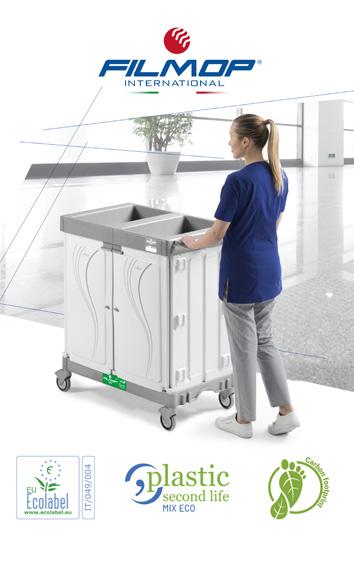
Green is a timeless classic for us. And also for our trolleys: thanks to the certified
Carbon Footprint Systematic Approach
we can quantify the CO2e related to each phase of their life cycle. Another milestone achieved.
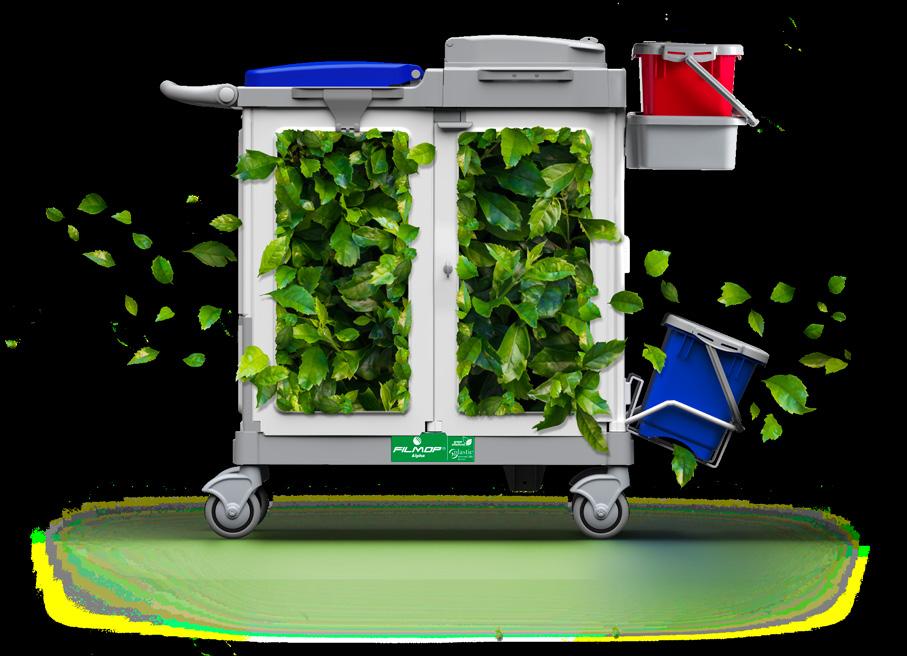
filmop.com sponsored content
www.filmop.com SEE MORE
Obiettivi di pulito sostenibile, la strada di Fimap Sustainable cleaning goals - Fimap’s
journey

Nel corso dell’ultimo anno Fimap ha raggiunto nuovi traguardi nella sua corsa verso la sostenibilità, che premiano sia l’azienda che il prodotto.
Dalla ISO 14064-1:2018, alla Medaglia d’Oro di EcoVadis, fino alla certificazione delle plastiche riciclate con ReMade in Italy, Fimap ha dimostrato di avere le idee chiare su come perseguire le direttive dell’Agenda 2030.
PLASTICHE RICICLATE CERTIFICATE
Collaborando con i fornitori Fimap ha dato vita ad un progetto di recupero della plastica di scarto per trasformarla da rifiuto in risorsa. Sono nate così le plastiche riciclate, poi certificate ReMade in Italy.
La certificazione fornisce un vantaggio competitivo nelle gare d’appalto, poiché soddisfa il requisito dei criteri premianti dei CAM per cui almeno il 15% del peso totale della plastica deve essere riciclata, favorendo il conseguimento del miglior punteggio tecnico possibile sui macchinari.
NUOVE TECNOLOGIE
PER L’AMBIENTE
In tutta la sua storia Fimap ha sempre cercato di superarsi proponendo soluzioni tecnologiche per la salvaguardia dell’ambiente e delle risorse. Le innovazioni di quest’anno riguardano l’acqua, con la tecnologia AQUÆ®, e l’aria, con la tecnologia Safe Air.
AQUÆ® punta ad eliminare il detergente. Attivando il cloro presente nella semplice acqua di rubinetto addolcita, si ottiene una soluzione pulente ed igienizzante ad effetto prolungato. In questo modo si evita tutto l’inquinamento generato dall’uso del detergente, dalla plastica per contenerlo, dal suo trasporto, fino ai tensioattivi
rilasciati nelle acque reflue. A rendere ancora più straordinaria questa tecnologia è la vastità di applicazione. È perfetta per la pulizia quotidiana e di manutenzione degli edifici, che nel settore del pulito professionale ricopre circa il 90% delle attività.
La tecnologia Safe Air è pensata invece per le spazzatrici, con l’obiettivo di migliorare la qualità dell’aria degli ambienti che si stanno pulendo, perché siano più sicuri per le persone che li frequentano. Una volta aspirata, l’aria passa attraverso più tipologie di filtro, che trattengono particelle di polvere sempre più piccole, fino a quelle da 0,3 µm, catturate dal filtro Hepa, che ha un’efficienza di filtrazione del 99,9%.
FFM - FIMAP FLEET
MANAGEMENT
CONTROLLO DELL’IMPATTO AMBIENTALE
Una componente che Fimap non ha mai sottovalutato è il controllo. FFM – Fimap Fleet Management è lo strumento più accurato per ottenere informazioni dettagliate sulle macchine che vanno dall’uso, ai consumi fino alla produzione di CO2 per intervento.
I dati sono la base essenziale per costruire strategie di miglioramento e, nel caso specifico della CO2, per avviare attività atte a compensarla e neutralizzarla.
CARBON FOOTPRINT DI PRODOTTO, CFP 14067:2018
SYSTEMATIC APPROACH
Nell’analisi del ciclo di vita della macchina, la fase di utilizzo è sempre stata quella più difficile da accertare, a causa delle numerose variabili. La sinergia tra tecnologie ambientali ed FFM ha permesso di recuperare questo tassello

e completare l’analisi con dati scientifici e verificabili. Questo ha portato al conseguimento della certificazione CFP – Carbon Footprint di Prodotto Systematic Approach per le lavasciuga pavimenti, con cui calcolare la quantità di CO2 prodotta dalla singola macchina per ora di lavoro e ottenere un dato certificato secondo la norma ISO 14067:2018.
CARBON FOOTPRINT DI ORGANIZZAZIONE 14064-1:2018
Le certificazioni permettono di comunicare all’esterno i progressi interni utilizzando un linguaggio condiviso. Gli stessi clienti sono sempre più interessati al valore ambientale del prodotto e dell’azienda, e cercano un riscontro tangibile nelle certificazioni. Esse mettono in relazione gli sforzi di enti, imprese, fornitori fino agli utenti finali, a raggiungere gli obiettivi dell’Agenda 2030. L’attenzione costante che Fimap ha dedicato a tali tematiche nel corso degli anni ha portato alla Medaglia d’Oro di EcoVadis, che premia le performance a livello aziendale e alla valutazione CFO – Carbon Footprint di Organizzazione, che certifica la rendicontazione dei gas serra secondo la norma ISO 14064-1:2018.
BILANCIO DI SOSTENIBILITÀ
Fimap ha deciso di offrire una visione d’insieme, compilando volontariamente il suo primo Bilancio di Sostenibilità che, mentre descrive i traguardi raggiunti, offre una proiezione degli obiettivi che la attendono nel prossimo futuro, dichiarando il proprio impegno a continuare a migliorare seguendo i propositi dell’Agenda 2030.
world A NEW GENERATION MACHINES COMMITTED TO ZERO EMISSIONS
ENVIRONMENT Sfoglia il bilancio di Sostenibilità


Over the past year, Fimap has reached a number of new milestones in its quest for sustainability, with both the company and the products achieving recognition. From ISO 14064-1:2018 certification to the EcoVadis Gold Medal and the ReMade in Italy recycled plastic certification, Fimap has demonstrated clear intentions with regard to how the company will pursue the directives set out in the 2030 Agenda.
CERTIFIED RECYCLED PLASTICS
Fimap has worked with its suppliers to implement a project designed to recover plastic waste and turn it into a valuable resource. This led to the creation of our recycled plastics, which have subsequently received ReMade in Italy certification.
NEW TECHNOLOGIES FOR THE ENVIRONMENT
Throughout its history, Fimap has always sought to go above and beyond, offering technological solutions designed to protect the environment and resources. This year, the company’s innovations are focused on water, with AQUÆ® technology, and air, with Safe Air technology. AQUÆ® aims to eliminate the use of detergents. A cleaning and sanitising solution with a long-lasting effect is obtained simply by activating the chlorine in softened tap water. This prevents all of the pollution
generated by the use of detergents, from the plastic used to contain it to its transportation and the surfactants released in waste water. The sheer breadth of application makes this technology even more extraordinary: it is perfect for the daily and maintenance cleaning of buildings, which constitutes around 90% of operations in the professional cleaning sector. Meanwhile, the Safe Air technology is designed for sweeping machines, with a view to improving the quality of the air in the spaces being cleaned, so that they are safer for the people who spend time in these environments. Once sucked into the system, the air passes through several types of filter, which retain increasingly small dust particles, right down to 0.3 µm: these are captured by the Hepa filter, which has a filtration efficiency of 99.9%.
FFM - FIMAP FLEET MANAGEMENT
ENVIRONMENTAL IMPACT CONTROL
One element that Fimap has never underestimated is control. The FFM - Fimap Fleet Management system is the most accurate tool for obtaining detailed information on the machines, from the way they are used to their consumption of resources and the CO2 produced by each operation. These data constitute an essential foundation for creating strategies for improvement, and in the specific case of CO2, to implement steps to offset and neutralise this.


CARBON FOOTPRINT OF THE PRODUCT CFP 14067:2018
SYSTEMATIC APPROACH
In the life cycle analysis, the use phase has always been the most difficult to ascertain, due to the wide range of variables. The synergy between environmental technologies and the FFM system has made it possible to recover this piece of the puzzle, completing the analysis with scientific, verifiable data. This has led to the achievement of CFP - Carbon Footprint of Product Systematic Approach certification for scrubbing machines, used to calculate the amount of CO2 produced by the individual machine per hour of work, obtaining a certified figure in line with ISO 14067:2018.
CARBON FOOTPRINT OF THE ORGANISATION, 14064-1:2018
Certifications enable internal progress to be communicated externally using a shared language. Customers are increasingly focused on the environmental value of a given product and company, and seek certifications as tangible evidence. These certifications link the efforts of bodies, companies, suppliers and end users, as they work together to achieve the goals of the 2030 Agenda.
Fimap’s unwavering focus on these issues over the years has led to the company being awarded the EcoVadis Gold Medal, which recognises the excellent performance across the company, as well as the CFO - Carbon Footprint of Organisation evaluation, which certifies greenhouse gas reporting in accordance with ISO 14064-1:2018.
SUSTAINABILITY REPORT
Fimap has decided to offer an overview of everything it has attained, voluntarily compiling its first Sustainability Report, which describes the company’s achievements and maps out the goals that await it in the near future, declaring its commitment to continue to improve by following the objectives of the 2030 Agenda.
world
www.fimap.com ENVIRONMENT ENVIRONMENTAL IMPACT MONITORING TO CLEAN WITHOUT DETERGENT IMPROVED AIR QUALITY CERTIFIED RECYCLED PLASTIC EFFICIENT ENERGY USE Watch the video AQUÆ® ISO 14064-1:2018 CARBON FOOTPRINT OF ORGANIZATION ISO 14067:2018 CARBON FOOTPRINT SYSTEMATIC APPROACH
Read the Sustainability Report Visit us at INTERCLEAN Amsterdam Netherlands - RAI Amsterdam 14/17 May 2024 Hall 1 Booth 01.421B
Mobile robots and applications in cleaning industry
Rapid advances in hardware and software are leading to a boom in mobile robots in a number of industry sectors. There are rapid developments in Autonomous Mobile Robots (AMRs), which are able to navigate and perform other functions autonomously
edited by Simone Ciapparelli
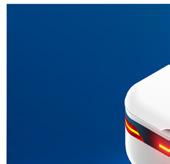
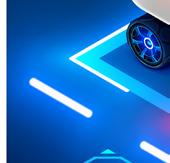






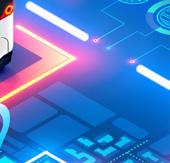



















30 MARCH 2024
ROBOTICS
Robot mobility is a game-changing set of technologies that are enabling new industry business models, improving efficiency and sustainability, and making work safer and more rewarding in a wide range of industry sectors. There are rapid developments in Autonomous Mobile Robots (AMRs), which are able to navigate and perform other functions autonomously. AMRs may consist of a mobile base; a mobile base with a robot arm or a complete mobile application with a tailored user interface. AMRs are changing how work is done in a variety of key industry sectors, such as logistics, healthcare, public environments and also cleaning.
They either replace, or are used in addition to, Automated Guided Vehicles (AGVs) which rely on guidepaths and other external markers to navigate and cannot map their own route. AMRs can map their environment (or update on a pre-supplied map) and locate their position within it. They can perceive and respond to obstacles – for example slowing down or stopping –and they can plan an alternative route to their destination. Most AMRs are used in indoor environments and are wheeled. Inspection robots in plants may be legged. While AGVs traditionally operate in
industrial settings where interaction is restricted to trained personnel, AMRs are already at work in both industrial settings and in applications where contact with the general public is either intended (such as information robots) or cannot be avoided (for example, delivery and cleaning robots in hospitals). In the retail and hospitality sector, complete mobile systems are most common – for example information and stocktaking robots.
In AMRs, autonomy relates principally to navigation. AMRs can navigate around factories and warehouses without having to follow fixed guidepaths, stopping when they encounter an obstacle, and re-planning their path on the fly.
Mobile robots need to be able to function effectively, and safely, in environments with a high degree of uncertainty. This has typically been achieved by developing models for appropriate responses to input from sensor data – such as stopping if an object is less than x cm away. Algorithms for robots that need to engage with an uncertain external environment are developing at a very rapid pace, allowing increasing levels of autonomy. At a ‘basic’ (but still, in fact, highly complex) level, mobile robots can navigate from A to B, replanning their route if an obstacle is encountered. Much research is currently going on to provide the robot with ‘semantic intelligence’ – i.e., an understanding of what it is seeing
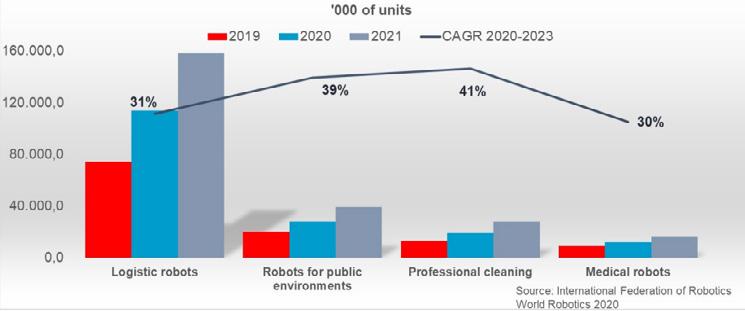
which in turn enables it to react appropriately.
The notion of increasing autonomy typically raises concerns relating to the safety of humans – or objects – in the path of, or in direct contact with, the mobile robot. If we don’t know what the robot is going to do – because it is able to determine its course of action on the fly, and with no human input – how do we know it is safe? It’s important to note here that an AMR application consists of a mix of algorithms, both deterministic (if x, do y), and probabilistic (what is most likely to be true based on the information I have and what is the most appropriate action to achieve my goal given this information) and a hierarchy is applied to determine which has precedence. Currently, programming and installation account for a significant part of the overall cost of robot adoption. The developments in functionality and robot learning techniques, combined with increasingly intuitive robot programming interfaces, will continue to lower the overall cost of robot installation and so drive adoption. Robot manufacturers and integrators are also likely to move to the ‘plug-and-play’ model that is already well established in computing. Manufacturers will provide a given level of functionality with the robot but will also provide an interface through which to easily add third party applications with minimal additional integration costs.
Fleet management
AMRs are typically connected to other AMRs from the same manufacturer through fleet management systems, through which their activities can be coordinated and monitored. Fleet management systems can be configured to control not only the mobile robots but also other machinery or hardware, enabling the robot to trigger activities such as starting a conveyor belt or machining tool. Fleet management software is developing rapidly,

31 MARCH 2024
Figure 1 - Service robots for professional use - major application areas
using advanced algorithms to determine the optimal set-up of the fleet, in addition to managing the movements of the machines within the fleet. Robots and other machines in the fleet can be connected either through the central fleet management system, or directly to each other.
Materials
The materials robots are made of affect their size, weight and exterior contours, all of which influence their suitability for different environments, including those where the robot is either intended to, or might, come into contact with humans. The mechanics and materials used to enable locomotion similarly must be adapted to the robot’s intended environment. Robot manufacturers are using newer, lightweight, flexible materials for the construction of robots that are intended to come into contact with humans from either a fixed or mobile base. Aluminum, which is light yet rigid, is often used in robots, but robot manufacturers are increasingly turning to carbon fiber composites which are lighter than aluminum without sacrificing rigidity. Robots that may come into contact with humans are generally made with rounded contours and may use a robot skin. Skins not only absorb force on contact, they can also be fitted with sensors to provide advanced tactile properties which are also needed in robot grippers made to handle delicate materials.
Cleaning robots
in healthcare sector
the cleaning and disinfection robot market size is rising rapidly. In fact, as reported by HowToRobot, Emergent Research estimated in 2020 that the global market size for cleaning robots was US$ 6.9 Bn. They projected a growth rate of 23.0% per year from 2020 to 2028. So, the market size will reach US$ 36.05 Bn by 2028. That is a fivefold increase in 8 years.
AMRs are increasingly used to transport linen and medications throughout hospitals. They navigate autonomously around hospitals, for example delivering medicines to nurse stations on the ward. AMRs are also used to assist doctors and nurses – for example a mobile robot base equipped with a robot arm can be programmed to take simple diagnostic measurements such as a patient’s temperature. Mobile bases equipped with computer screens can follow nurses or navigate autonomously to a patient’s bed to connect the patient with a doctor at a remote location. This not only allows for far more effective specialist consultations, it also enables medical interaction with patients who may be highly infectious.
Autonomous cleaning and disinfection robots are also widely used in hospitals. Mobile floor-cleaning robots are available from several manufacturers and the COVID-19 pandemic has rapidly accelerated their use in hospitals. Cleaning robots scrub, sweep and vacuum floors. Meanwhile, sales of disinfection robots boomed during the COVID-19 pandemic and over 30 new disinfection robot types from diverse manufacturers were registered in 2020. Most use high-frequency ultraviolet light (UV-C) but others spray disinfectant. Acquired infections are a significant and increasing problem in the global healthcare sector. Each year millions of patients are infected and thousands of patients die due to infections acquired during hospitalization. Mobile disinfection robots use UV light to kill germs and most can be operated easily by cleaning staff. Their use has spread from hospitals to public transport and other public environments such as shopping malls.
Floor cleaning the pandemic has made the public much more conscious of cleanliness. Floor hygiene is no longer a largely underestimated issue as it was before
the pandemic. Cleaning robots are a reliable solution for restaurants, hotels, and convention centers, not only because they help keep things cleaner and relieve the burden on staff. Robotic floor cleaners are labor-saving machines, but they cannot run entirely independently. An operator must still replace cleaning fluids and empty the dirty water container on mopping robots. A worker must empty the dustbin of vacuum cleaning robots. Someone must teach the floor plan to the bot. Usually, this involves an operator guiding the machine around the facility. Once the floorplan is learned, the robot can travel independently.
Bathroom
cleaning
there are cleaning solutions that offer a "touch-free" system. For example, a multifunction machine that starts with a power spray. The next step is a vacuum that removes the dirty water. Finally, the device uses a blower to dry things off. Undoubtedly this saves labor, and it saves workers from having to stoop over and scrub. But the device must still be used by a cleaning person. For a truly autonomous solution, there appears to be only one vendor at the time of this writing. The robot follows the three-step process described above. But it does so without the need of a human. So, it can use a power-sprayer, a vacuum, and a brush.
Street cleaning
in outdoor applications, most of the solutions are still in their beginning stages. Autonomous street cleaning robots are being evaluated, and pilot projects have shown promising results. New autonomous robots will soon be employed by the state of Malta for the scrubbing of promenades and public places across the island. As reported by the news agency Italpress, the fleet consists of 73 mostly electric vehicles, including fully automated sweeper and scrubbing robots, street sweepers and rough terrain

32 MARCH 2024
ROBOTICS
utility vehicles. There are two types of automated robots among the vehicles: one can scrub and will be used for street cleaning while the other sweeps and will be on promenades, pedestrian zones and public spaces. Narrow passageways, beaches and other restricted areas will be cleaned with the help of rough-terrain utility vehicles.
Robot impact on logistic
There is a rapidly-growing market for AMRs in logistics, attracting new robot manufacturers and logistics software providers. Sales of logistics robots boomed in 2019, with 75,000 units sold, a 42% increase over 2018. Sales of logistics robots accounted for 43% of total unit sales of professional service robots in 2019. Most logistics robots are designed for operation indoors. Designing robots for outdoor use is challenging as they must be able to stably navigate very variable surfaces and work in changing climate conditions such as rain and fog and sudden bursts of bright light. For the approximately 95% of logistics providers that
have not automated, two key motivations for AMR adoption are maximising the existing space and dealing with labor shortages. AMR vendors report that customers can process double the volume of goods within the same space using AMRs. As the logistics sector booms, most companies face labor shortages, problems ramping up staffing at peak periods, and high turnover. A number report that AMRs not only fill labor gaps, but also improve retention of existing staff who no longer have to carry heavy goods and tug carts.
Impact of mobile robots on work and life
Mobile robots bring advantages to employees in all of the industry sectors above. First and foremost are physical benefits. Factory workers no longer have to carry heavy loads and walk miles fetching and carrying but can focus on higher-value, more interesting tasks such as programming robots and supervising automated production. Logistics workers are safer – in the US,
for example, 614 workers lost their lives in forklift-related incidents and more than 7,000 nonfatal injuries leading to days away from work occurred every year. Nurses and care workers can give more time to their patients and are spared back-breaking lifting that, in the US, causes musculoskeletal disorders in nurses, aides and orderlies at a rate over five times higher than the average for all industries. Staff in retail and service sectors can focus on customer service. The positive impact of mobile robots on our daily lives is often evident. In other cases, the positive impact of mobile robots is less evident but equally critical – for example the convenience of clickand-collect ordering or the reduced risk of infection in hospitals.
Source
A Mobile Revolution How mobility is reshaping robotics, IFR (International Federation of Robotics) https://howtorobot.com/expert-insight/ cleaning-and-disinfection-robots https://www.italpress.com/malta-robotswill-soon-be-cleaning-public-spaces/
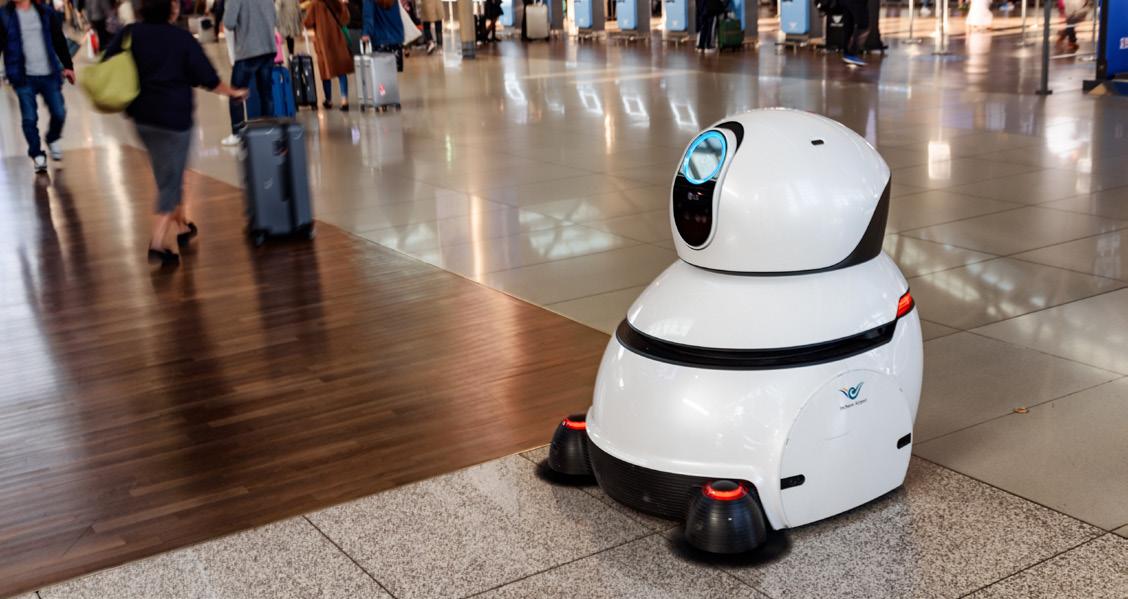

33 MARCH 2024
MOBILE ROBOT E APPLICAZIONI NEL SETTORE DEL CLEANING
I rapidi progressi in ambito hardware e software stanno portando alla rapida diffusione dei robot mobili in diversi settori industriali. In particolare i robot mobili autonomi (AMR), in grado di muoversi e svolgere altre funzioni in modo autonomo
La mobilità dei robot è una tecnologia che sta cambiando le carte in tavola, consentendo di realizzare nuovi modelli di business, migliorando l'efficienza e la sostenibilità e rendendo il lavoro più sicuro e gratificante in un'ampia gamma di settori industriali. I robot mobili autonomi (AMR), in grado di muoversi e svolgere altre funzioni in modo autonomo, sono in rapida evoluzione. Gli AMR possono essere costituiti da una base mobile, da una base mobile con un braccio robotico o da un'applicazione mobile completa con un'interfaccia utente personalizzata. Gli AMR stanno cambiando il modo in cui viene svolto il lavoro in una serie di settori chiave dell'industria, come la logistica, la sanità, gli ambienti pubblici e anche le pulizie.
Sostituiscono o sono utilizzati in aggiunta ai
veicoli a guida automatica (AGV), che si affidano a percorsi di guida e altri marcatori esterni per navigare e non possono mappare il proprio percorso. Gli AMR sono in grado di mappare l'ambiente circostante (o di aggiornarlo su una mappa preconfezionata) e di localizzare la propria posizione all'interno di esso. Possono percepire e reagire agli ostacoli, ad esempio rallentando o fermandosi, e possono pianificare un percorso alternativo per raggiungere la destinazione. La maggior parte degli AMR viene utilizzata in ambienti interni ed è dotata di ruote. I robot di ispezione negli impianti possono essere dotati di gambe.
Mentre gli AGV operano tradizionalmente in contesti industriali in cui l'interazione è limitata a personale addestrato, gli AMR sono già attivi sia in contesti industriali sia in applicazioni in cui il contatto con il pubblico è previsto (come i robot informativi) o non può essere evitato (ad esempio, i robot per le consegne e le pulizie negli ospedali). Nel settore della vendita al dettaglio e dell'ospitalità, i sistemi mobili
completi sono i più comuni, ad esempio i robot per le informazioni e le scorte.
Negli AMR, l'autonomia riguarda principalmente la navigazione. Gli AMR possono navigare all'interno di fabbriche e magazzini senza dover seguire percorsi guida fissi, fermandosi quando incontrano un ostacolo e ripianificando il loro percorso al volo.
I robot mobili devono essere in grado di funzionare in modo efficace e sicuro in ambienti con un alto grado di incertezza. Questo obiettivo è stato raggiunto sviluppando modelli di risposta appropriata agli input provenienti dai dati dei sensori, come ad esempio fermarsi se un oggetto si trova a meno di x cm di distanza. Gli algoritmi per i robot che devono confrontarsi con un ambiente esterno incerto si stanno sviluppando a un ritmo molto rapido, consentendo livelli crescenti di autonomia. A un livello "base" (ma di fatto ancora molto complesso), i robot mobili possono navigare da A a B, ripianificando il percorso se incontrano un ostacolo. Attualmente sono in corso molte ricerche per


34 MARCH 2024 ROBOTICA
a cura di Simone Ciapparelli
dotare il robot di una "intelligenza semantica", cioè di una comprensione di ciò che vede che gli consenta di reagire in modo appropriato. La nozione di crescente autonomia solleva di solito preoccupazioni relative alla sicurezza delle persone o degli oggetti che si trovano sul percorso o a diretto contatto con il robot mobile. Se non sappiamo cosa farà il robot - perché è in grado di determinare il suo corso d'azione al volo, senza alcun input umano - come facciamo a sapere che è sicuro? È importante notare che un'applicazione AMR consiste in un mix di algoritmi, sia deterministici, sia probabilistici (cosa è più probabile che sia vero in base alle informazioni che ho e qual è l'azione più appropriata per raggiungere il mio obiettivo in base a queste informazioni) e viene applicata una gerarchia per determinare quale ha la precedenza.
Attualmente, la programmazione e l'installazione rappresentano una parte significativa del costo complessivo dell'adozione dei robot. Gli sviluppi delle funzionalità e delle tecniche di apprendimento dei robot, uniti a interfacce di programmazione sempre più intuitive, continueranno a ridurre il costo complessivo dell'installazione dei robot e quindi a favorirne l'adozione. È probabile che i produttori e gli integratori di robot si orientino verso il modello "plug-and-play", già ben consolidato nell'informatica. I produttori forniranno un determinato livello di funzionalità con il robot, ma forniranno anche un'interfaccia attraverso la quale aggiungere facilmente applicazioni di terze parti con costi di integrazione aggiuntivi minimi.
Gestione della flotta
Gli AMR sono in genere collegati ad altri AMR dello stesso produttore attraverso sistemi di gestione della flotta, grazie ai quali le loro attività possono essere coordinate e monitorate. I sistemi di gestione della flotta possono essere configurati per controllare non solo i robot mobili, ma anche altri macchinari o hardware,
Figura 1 - Robot di servizio per uso professionale - principali aree di applicazione
consentendo al robot di attivare altri dispositivi. I software di gestione si stanno sviluppando rapidamente, utilizzando algoritmi avanzati per determinare la configurazione ottimale della flotta, oltre a gestire i movimenti delle macchine all'interno di essa. I robot e le altre macchine del parco macchine possono essere collegati attraverso il sistema centrale di gestione del parco macchine o direttamente tra loro.
Materiali
I materiali di cui sono fatti i robot influenzano le loro dimensioni, il peso e i contorni esterni, tutti elementi che ne condizionano l'idoneità a diversi ambienti, compresi quelli in cui il robot è destinato o potrebbe entrare in contatto con gli esseri umani. Anche la meccanica e i materiali utilizzati per la locomozione devono essere adattati all'ambiente in cui il robot è destinato. I produttori utilizzano materiali più recenti, leggeri e flessibili per la costruzione di robot destinati a entrare in contatto con l'uomo da una base fissa o mobile. L'alluminio, leggero ma rigido, è spesso utilizzato nei robot, ma i produttori di robot si stanno sempre più orientando verso materiali compositi in fibra di carbonio, più leggeri dell'alluminio senza sacrificare la rigidità. I robot che possono entrare in contatto con l'uomo sono generalmente realizzati con contorni arrotondati e possono utilizzare una pelle robotica. Le pelli non solo assorbono la forza al contatto, ma possono anche essere dotate di sensori per fornire proprietà tattili avanzate, necessarie anche nelle pinze dei robot per la manipolazione di materiali delicati.
Robot per la pulizia nella sanità
Le dimensioni del mercato dei robot per la pulizia e la disinfezione sono in rapida crescita. Infatti, come riportato da HowToRobot, si stima che nel 2020 la dimensione del mercato globale dei robot per la pulizia fosse di 6,9 miliardi di dollari. La ricerca ha previsto un tasso di crescita del 23,0% all'anno dal 2020 al 2028. Pertanto, le dimensioni del mercato raggiungeranno i 36,05 miliardi di dollari entro il 2028. Si tratta di un aumento di cinque volte in 8 anni. Gli AMR sono sempre più utilizzati per tra-
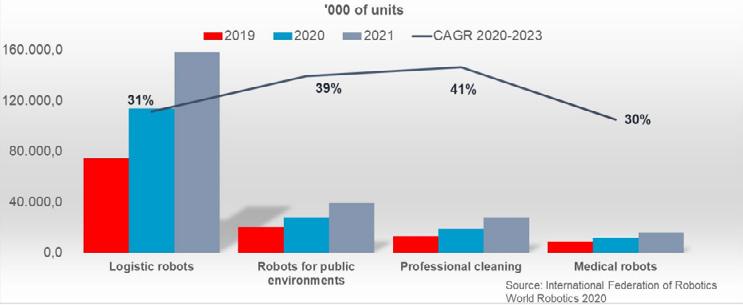
sportare biancheria e farmaci negli ospedali. Si muovono autonomamente all'interno degli ospedali, ad esempio consegnando i farmaci alle postazioni degli infermieri in reparto. Gli AMR sono utilizzati anche per assistere medici e infermieri: ad esempio, una base mobile dotata di un braccio robotico può essere programmata per effettuare semplici misurazioni diagnostiche, come la temperatura di un paziente. Le basi mobili dotate di schermi di computer possono seguire gli infermieri o navigare autonomamente fino al letto del paziente per metterlo in contatto con un medico in una posizione remota. Ciò non solo consente di effettuare consultazioni specialistiche molto più efficaci, ma anche di interagire con pazienti che possono essere altamente infettivi.
Anche i robot autonomi per la pulizia e la disinfezione sono ampiamente utilizzati negli ospedali. I robot mobili per la pulizia dei pavimenti sono disponibili presso diversi produttori e la pandemia COVID-19 ne ha rapidamente accelerato l'uso negli ospedali. I robot per la pulizia strofinano, spazzano e aspirano i pavimenti. Nel frattempo, le vendite di robot per la disinfezione sono aumentate durante la pandemia COVID-19 e nel 2020 sono stati registrati oltre 30 nuovi tipi di robot per la disinfezione. La maggior parte utilizza la luce ultravioletta (UV-C), ma altri operano attraverso l’uso di disinfettante. Le infezioni acquisite sono un problema significativo e crescente nel settore sanitario globale. Ogni anno milioni di pazienti vengono infettati e migliaia di pazienti muoiono a causa di infezioni contratte durante il ricovero.
Pulizia dei pavimenti
La pandemia ha reso il pubblico molto più consapevole della pulizia. L'igiene dei pavimenti non è più un problema sottovalutato come lo era prima della pandemia. I robot per la pulizia sono una soluzione affidabile per ristoranti, hotel e centri congressi, sono macchine che consentono di risparmiare tempo e fatica al personale umano, ma non possono funzionare in modo completamente autonomo. Un operatore deve comunque sostituire i liquidi di pulizia e svuotare il contenitore dell'acqua sporca. Il robot deve anche essere istruito sulla planimetria da un essere umano. Di solito, questo comporta che un operatore guidi la macchina all'interno della struttura. Una volta appresa la planimetria, il robot può spostarsi autonomamente.
Pulizia stradale
Per quanto riguarda le applicazioni all'aperto, la maggior parte delle soluzioni è ancora in fase iniziale. I robot autonomi per la pulizia delle strade sono in fase di valutazione e i progetti pilota hanno dato risultati promettenti. Nuovi robot autonomi saranno presto impiegati dallo Stato di Malta per la pulizia delle passeggiate e dei luoghi pubblici dell'isola.
Come riporta l'agenzia di stampa Italpress, la

35 MARCH 2024
flotta è composta da 73 veicoli per lo più elettrici, tra cui robot spazzini e lavapavimenti completamente automatizzati, spazzatrici stradali e veicoli utilitari per terreni accidentati. Tra i veicoli ci sono due tipi di robot automatizzati: uno è in grado di spazzare e sarà utilizzato per la pulizia delle strade, mentre l'altro spazza e sarà impiegato su passeggiate, zone pedonali e spazi pubblici. I passaggi stretti, le spiagge e altre aree ristrette saranno pulite con l'aiuto di veicoli utilitari.
Impatto dei robot sulla logistica Il mercato degli AMR nella logistica è in rapida crescita e attira nuovi produttori di robot e fornitori di software logistici. Le vendite di robot logistici hanno registrato un boom nel 2019, con 75.000 unità vendute, con un aumento del 42% rispetto al 2018. Le vendite di robot logistici hanno rappresentato il 43% delle vendite totali di unità di robot per servizi professionali nel 2019. La maggior parte dei robot logistici è progettata per funzionare in ambienti chiusi. La progettazione di robot per l'uso all'aperto è impegnativa, in quanto devono essere in grado di navigare in modo stabile su superfici molto variabili e di lavorare in condizioni climatiche mutevoli, come pioggia e nebbia, e in presenza di improvvise esplosioni di luce intensa. Per il
95% circa dei fornitori di servizi logistici che non hanno automatizzato, due motivazioni chiave per l'adozione degli AMR sono la massimizzazione dello spazio esistente e la gestione della carenza di manodopera. I fornitori di AMR riferiscono che i clienti possono trattare un volume doppio di merci nello stesso spazio utilizzando gli AMR. Con il boom del settore logistico, la maggior parte delle aziende si trova ad affrontare carenze di manodopera, problemi di aumento del personale nei periodi di picco e un elevato turnover. Alcune riferiscono che gli AMR non solo colmano le carenze di manodopera, ma migliorano anche la fidelizzazione del personale esistente che non deve più trasportare merci pesanti e carrelli.
Impatto dei sul lavoro e sulla vita I robot mobili offrono vantaggi ai dipendenti di tutti i settori industriali sopra citati. Il primo e più importante è rappresentato dai benefici fisici. Gli operai delle fabbriche non devono più trasportare carichi pesanti e percorrere chilometri a piedi, ma possono concentrarsi su compiti più interessanti e di maggior valore, come la programmazione dei robot e la supervisione della produzione automatizzata. I lavoratori della logistica sono più al sicuro: negli Stati Uniti, ad esempio,
614 lavoratori hanno perso la vita in incidenti legati ai carrelli elevatori e ogni anno si sono verificati più di 7.000 infortuni non mortali che hanno comportato giorni di assenza dal lavoro. Gli infermieri e gli addetti all'assistenza possono dedicare più tempo ai loro pazienti e sono risparmiati dal sollevamento di carichi pesanti che, negli Stati Uniti, causano disturbi muscoloscheletrici in infermieri, assistenti e inservienti a un tasso più che quintuplicato rispetto alla media di tutti i settori. Il personale dei settori della vendita al dettaglio e dei servizi può concentrarsi sul servizio al cliente. L'impatto positivo dei robot mobili sulla nostra vita quotidiana è spesso evidente. In altri casi, l'impatto positivo dei robot mobili è meno evidente ma ugualmente fondamentale: ad esempio, la comodità delle ordinazioni click-and-collect o la riduzione del rischio di infezioni negli ospedali.
Fonti: A Mobile Revolution How mobility is reshaping robotics, IFR (International Federation of Robotics) https://howtorobot.com/expert-insight/cleaning-and-disinfection-robots https://www.italpress.com/malta-robots-will-soon-be-cleaning-public-spaces/
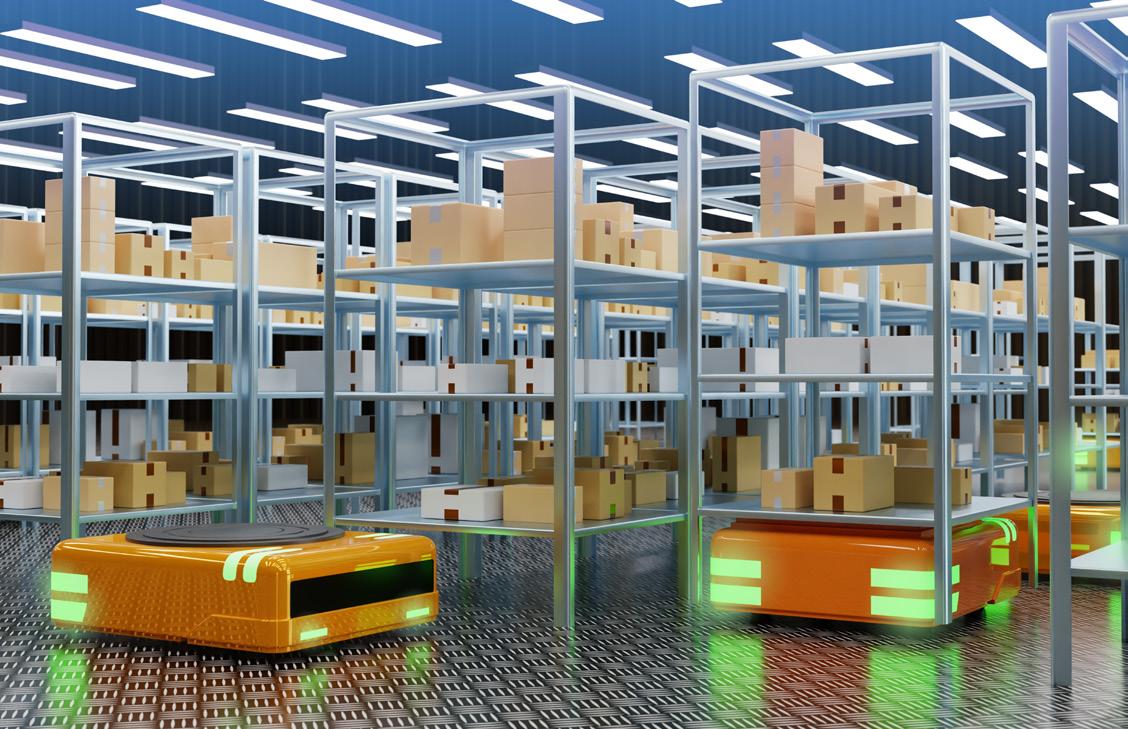

36 MARCH 2024
ROBOTICA
Adiatek 4 a sustainable cleaning: R-Quartz in the greenest shopping center
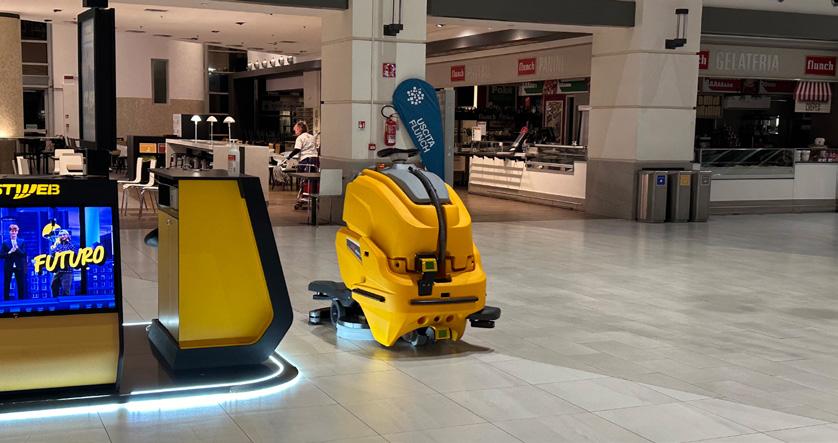
In Genoa there is a shopping centre, the Fiumara Shopping Center, which is particularly committed to sustainability. BREEAM certified, it is a business park that pays attention to its environmental impact and
that of all its activities.
We are proud to tell you that this shopping center chose R-Quartz to clean its floors.
An excellent result achieved thanks to synergies in the field and the sharing of intentions and values. In fact,
behind this choice there is a collaboration among various actors. R-Quartz arrived at Fiumara with Coopge, a facility management and logistics company, which chose it thanks to the consultancy of LigurPerla,
a specialist in professional cleaning, and the inspection by our Adiatek technicians.
The Cooperative, as explained by Fabio Frumento, Coopge area manager and project manager, appreciated the R-Quartz because it is Made in Italy, autonomous and because it makes cleaning operations particularly sustainable!
Coopge aimed for an autonomous cleaning solution. From the beginning, the company has appreciated the possibility of monitoring and standardizing activities, facilitating compliance with defined quality levels. Furthermore, the autonomous machine, by carrying out repetitive tasks, allows staff to dedicate themselves to other value-added tasks and less tiring and more sa-
Adiatek X la pulizia sostenibile: R-Quartz nel centro commerciale più green
A Genova vi è un centro commerciale, il Fiumara Shopping Center, particolarmente impegnato in tema di sostenibilità. Certificato BREEAM, è un parco commerciale attento al suo impatto ambientale e a quello di tutte le sue attività.
Siamo orgogliosi di raccontarvi che, proprio questo centro commerciale, ha scelto R-Quartz per la pulizia dei suoi pavimenti. Un ottimo risultato raggiunto grazie alle sinergie sul campo e alla condivisione di intenti e valori. Infatti, dietro a questa scelta vi è la collaborazione di diversi attori: la R-Quartz è arrivata al Fiumara con Coopge,
società di facility management e logistica, che l’ha scelta grazie alla consulenza di LigurPerla, specialista nella pulizia professionale, e al sopralluogo dei tecnici Adiatek La Cooperativa, come spiegato da Fabio Frumento, Capo area Coopge e responsabile del progetto, ha apprezzato la R-Quartz perché è Made in Italy, autonoma e perché rende le operazioni di pulizia particolarmente sostenibili!
Fin da subito, Coopge puntava a una soluzione di pulizia autonoma, apprezzandone la possibilità di monitorare e standardizzare le attività, facilitando il rispetto di livelli qua-
litativi definiti. Inoltre, la macchina autonoma, svolgendo attività ripetitive, permette al personale di dedicarsi ad altre mansioni dal valore aggiunto e a lavori meno logoranti e più soddisfacenti.
Al centro commerciale ligure abbiamo voluto affiancare il nostro dealer sul campo LigurPerla: con un sopralluogo tecnico diretto abbiamo constatato che la R-Quartz poteva rispondere alle esigenze effettive del cliente!
Perché proprio R-Quartz?
Considerando che il centro commerciale
adiatek.com sponsored content
tisfying work.
At this shopping center we supported our Ligurian dealer LigurPerla. After a direct technical survey, we understood that R-Quartz could meet the customer’s actual needs!
Why did they choose R-Quartz?
Considering that the shopping center (in which the machine operates) measures its environmental impact, the customer greatly appreciated the Eco-green options, i.e. the ecological and sustainable systems designed by Adiatek and installed on the machine: the System Ozone and the 3S System. While the former allows sanitization, guaranteeing respect for the environment and evident economic savings; the second allows you to dose the water precisely, reducing the environmental impact of the cleaning phase.
The low environmental impact is one of the most important values for the
Fiumara shopping center: it has obtained the international BREEAM (Building Research Establishment Environmental Assessment Method) certification which evaluates and certifies the sustainable development of the buildings. Certified properties are evaluated from various aspects, including energy, emissions, water consumption, impact of activities, accessibility.
The Adiatek machine fits perfectly into this eco-sustainable context. Here, every element of the ecosystem (this mall) contributes to creating the most sustainable environment possible! In fact, thanks to the use of R-Quartz, the consumption of water used for cleaning floors has been reduced more than a half.
Our robotic scrubber-dryer, located in the Ligurian shopping centre, cleans a 2500m2 floor with just 75 liters of water. In contrast, the machine previously used cleaned every single floor with 180 liters of water.
(in cui la macchina avrebbe operato) è una realtà molto attenta al proprio impatto ambientale, il cliente ha ampiamente apprezzato gli optional Eco-green, cioè i sistemi ecologici e sostenibili studiati da Adiatek e installati sulla macchina: il Sistema Ozono e il Sistema 3S. Mentre il primo permette di sanificare, garantendo il rispetto dell’ambiente e un evidente risparmio economico; il secondo consente di dosare in modo molto preciso l’acqua, riducendo l’impatto ambientale della fase di pulizia. Il basso impatto ambientale è uno tra i valori più importanti per il centro commerciale Fiumara: questi ha ottenuto la certificazione internazionale BREEAM (Building Research Establishment Environmental As-
Adiatek is extremely proud to have taken part in this project, guaranteeing concrete support to this company which has been
committed to reducing environmental impact for years. Without a doubt, it is a satisfaction to know that our machines objectively

sessment Method) che valuta e attesta lo sviluppo sostenibile degli edifici. Gli immobili certificati vengono valutati sotto diversi aspetti, tra cui: energia, emissioni, consumo idrico, impatto delle attività, accessibilità, etc.
La macchina di Adiatek si inserisce perfettamente in questo contesto eco-sostenibile: qui, ogni elemento dell’ecosistema, cioè del centro commerciale, concorre a creare un ambiente più sostenibile possibile. Infatti, grazie all’utilizzo della R-Quartz è stato ridotto per più della metà il consumo di acqua utilizzata per la pulizia dei pavimenti.
La nostra lavasciuga pavimenti robotizzata, inserita nel centro commerciale ligure, pu-
lisce un piano di 2500m2 con soli 75 litri d’acqua. Al contrario, la macchina utilizzata precedentemente puliva ogni singolo piano con 180 litri d’acqua.
Adiatek è estremamente orgogliosa di aver preso parte a questo progetto, garantendo un supporto concreto a questa Realtà che da anni si impegna per ridurre l’impatto ambientale. Senza dubbio, è una soddisfazione sapere che le nostre macchine si distinguono oggettivamente sul campo, nonché apprezzate per la loro tecnologia sostenibile totalmente Made in Italy.
R-Quartz: la macchina impara da te!
R-Quartz memorizza le operazioni di pulizia riprodotte dall’operatore: non vi è la ne-
sponsored content
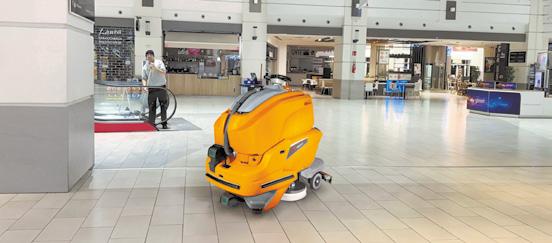
stand out in the field, as well as appreciated for their sustainable technology entirely Made in Italy.
R-Quartz: the machine learns from you!
R-Quartz memorizes the cleaning phase reproduced by the operator. Therefore, there is no need for signs in the environment or specialized personnel.
In fact, now, the operator carries out a first and only cleaning phase on board the machine, which learns and memorizes the path planned to be replicated. The system implemented on R-Quartz allows two possible learning modes: playback and perimeter With the first system, the machine faithfully repro-
duces the work carried out by the operator in the “teaching” phase; with the second, the operator, on board the washer dryer, walks only the perimeter of the area to be treated and, subsequently, the machine will autonomously clean the entire internal area, and plans the best possible path to reduce waste.
R-Quartz technical features:
R-Quartz was designed based on the Quartz 66-80 model, a scrubber with high-level technical features and performance. Adiatek autonomous machine guarantees the possibility of creating work sequences by combining paths with dif-
cessità, dunque, di cartellonistica nell’ambiente o di personale specializzato. Infatti, ora, l’operatore effettua una prima e unica fase di pulizia a bordo della macchina, la quale apprende e memorizza le impostazioni e il percorso da replicare.
Il sistema implementato su R-Quartz permette due modalità di apprendimento possibili: il playback e il perimeter. Con il primo sistema, la macchina riproduce fedelmente il lavoro svolto dall’operatore in fase di “teaching”; con il secondo, l’operatore percorre, a bordo della lavasciuga, solo il perimetro dell’area da trattare e, successivamente, la macchina pulirà in autonomia l’intera area interna, impostando il miglior percorso possibile per ridurre gli sprechi.
ferent modes and with different characteristics.
R-Quartz, equipped with three safety systems that work simultaneously, works in complete autonomy, guaranteeing total safety for people and the surrounding environment.
Thanks to the solution tank capacity of 100l and thanks to the standard Solution Saving System Dispenser (3SD), it is possible to precisely regulate consumption, guaranteeing up to 4 hours of continuous work.
The 24V 330Ah lithium battery pack offers up to 6 hours of working autonomy,
as well as a quick charge in 5 hours. The dashboard is equipped with a 7-inch touch screen with simple and intuitive setup.
Through the telemetry system, the operator remains constantly updated on the machine’s work. He can view the map sequence, as well as the time remaining until the end of the work. Furthermore, again thanks to Telematics, the operator will receive real-time alerts via notifications on the smartphone.
The dashboard is equipped with a 7-inch touch screen with simple and intuitive setup.
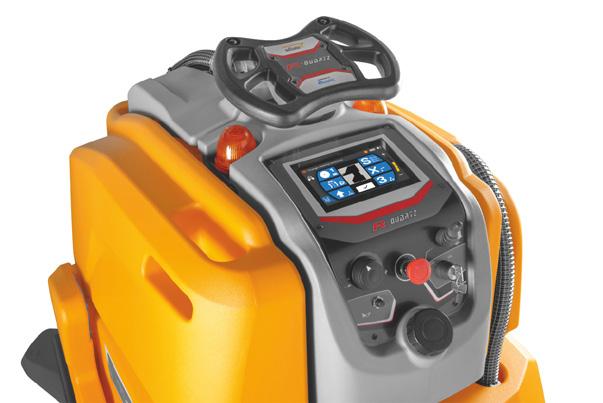
Le caratteristiche di R-Quartz
R-Quartz è stata progettata sulla base del modello Quartz 66-80, una lavasciuga dalle caratteristiche tecniche e dalle prestazioni di alto livello.
La macchina autonoma di Adiatek garantisce la possibilità di creare sequenze di lavoro combinando diversi percorsi, memorizzati in modalità e con caratteristiche differenti tra loro.
R-Quartz, dotata di tre sistemi di sicurezza che lavorano in contemporanea, lavora in completa autonomia, garantendo totale sicurezza per le persone e l’ambiente circostante.
Grazie alla capacità di serbatoio soluzione di 100l e grazie al sistema Solution Saving
System Dispenser (3SD) di serie, è possibile regolare in modo preciso i consumi garantendo fino a 4 ore di lavoro continuativo.
Il pacco batteria al Litio 24V 330Ah offre fino a 6 ore di autonomia di lavoro, nonché una ricarica rapida in 5 ore. Il cruscotto è dotato di un touch screen da 7 pollici dall’impostazione semplice e intuitiva.
Attraverso il sistema di telemetria, l’operatore rimane costantemente aggiornato sull’operato della macchina: questi può visualizzare la sequenza della mappa, nonché il tempo rimanente al termine del lavoro. Inoltre, sempre grazie al Telematics, l’operatore riceverà degli avvisi in tempo reale tramite notifiche sullo smartphone.
adiatek.com




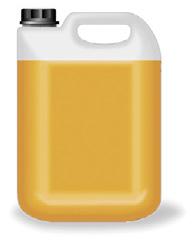


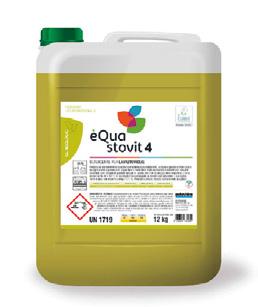

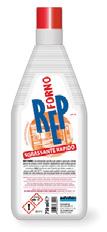




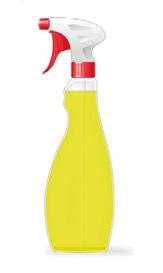












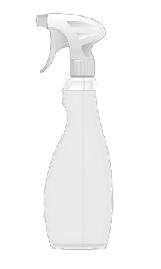
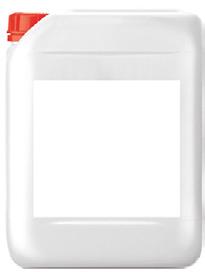
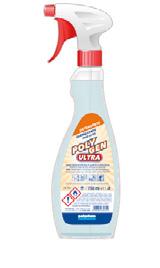
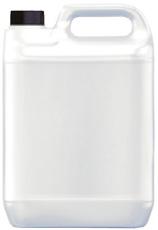
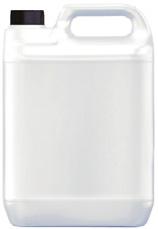

Hotel manager Training to build a key figure
An interview with Bartolomeo D'Amico, president of A.D.A. (the Italian Association of Hotel Managers), which is committed to the training and professional development of this important managerial figure


42 MARCH 2024
Maurizio Pedrini
HORECA
The hotel industry is undoubtedly a sector of strategic importance for the economy and future of a country, but also one that, in the case of Italy, has been waiting for years to receive the proper attention from the institutions, also considering the aspect of the preparation of the professional figures destined to guide and qualitatively manage hotel accommodations. We met with Bartolomeo D'Amico, president of the A.D.A. (Association of Hotel Managers), to address this and other issues at the center of the association's attention and activity.
Can we draw a sketch of the hotel manager, a truly essential figure in hotel management?
The hotel manager is a professional who has been properly trained through a middle-superior school education, or specific professional education. In this delicate learning path to play such an important and delicate role, having worked in the various departments in which the hotel is structured is of great importance. The many experiences gained in the field leads to the building of a prepared and competent professional, potentially capable of reaching the top at the career level. Two paths can be taken to achieve this goal: the
first represented by the Food and Beverage sector, connected to the work in the dining room and kitchen, with the management of suppliers, purchases and so on, and then becoming responsible for the management of the rating or conference events; the second path is instead related to administration, to the reception of customers, with the assumption of the role of Room division manager, that is, the person who manages, with specific supervisory tasks, the sector comprising the reception, concierge, floors, checkroom and laundry services; this function immediately precedes that of hotel manager.
Let's come to talk about the Association you chair: how can we introduce you and what activities are you carrying out?
The Hotel Managers Association is now a lady of 70 years well worn, born in Milan by Masters of Hospitality, who felt the need to come together and share their experiences, in order to find a balance in an industry that was changing. We are currently trying to make available to members a rich offer of professional updating, through the managerial study center “Raffaello Gattuso”, in order to be able to interpret and live to the fullest the change that is profoundly transforming our
WHO IS BARTOLOMEO D’AMICO
Born in Fasano, in the province of Brindisi, for thirteen years D'Amico gained valuable experience in various hotel departments, until he became head of reception - deputy manager at the prestigious Grand Hotel Rosa Marina in Ostuni. For thirty-
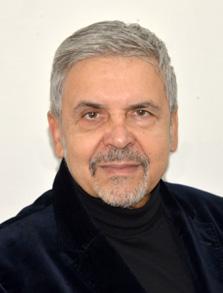
one years he has been at the helm of the Grand Hotel La Masseria Santa Lucia. In the early 1990s he was appointed president of Ada Puglia, then national vice president; for the past year he has been leading the National Association of Hotel Managers.
sector. One of the latest initiatives - which we call Adagio - will allow young graduates from tourism-oriented schools to interface with fellow directors, participate in their meetings and facilitate their entry into the world of work. Ours, ultimately, is a commitment that focuses on young people, looking forward to the future with confidence.
What, in particular, will be the priorities of your presidency?
In addition to the initiative we have talked about, which is particularly close to my heart, we are also taking care of our leisure time: in fact, we have created Adacard, a system that, for the moment, will allow fellow members of the association to move around Italy easily, enjoying many concessions and opportunities, staying, for example, in hotels directed by associates with economic advantages and upgrades. We are working to extend the conventions also to Spain, Portugal, Greece and other European countries.
As we are expanding the conversation to Europe, what can you tell us about the hotel situation in the European context?
From the comparison we often have with our European colleagues, I can only confirm without fear of contradiction that we have all the same problems. Just to name a few: the sudden change in guest habits, technology and employees no longer willing to make the sacrifices made in the past, the older generation struggling to adapt to new demands.
What are the positive aspects and main critical aspects of tourism on our continent that reverberate on the hotel industry?
I can only remark on a few fundamental concepts: tourism is of considerable importance to the Old Continent as a source of economic growth, regional development and employment.

43 MARCH 2024

THE IMPORTANCE OF TRAINING
A.D.A. (Associazione Direttori Albergo) is the Italian body that has been promoting the professional value of the figure of the hotel manager for over sixty years, nationally and internationally. Founded in 1955 by a committee of 14 promoters and officially established on January 25,
Indeed, it represents the third largest economic and employment sector, with the vocation to climb further in the future. Although it has been significantly affected by the economic crisis in past years, it has proven resilient, as evidenced by the increasing number of visitors to the EU over the years. Nevertheless, European tourism faces a number of challenges and increasing competition, particularly from emerging non-European destinations, whose share in the world market is gradually increasing. Because of its cross-cutting nature, tourism is affected by a variety of policies, including transportation, environment, consumer protection and regional development.
How do you assess the health of the hospitality sector in Italy, a world-leading country in tourism?
Italian hotels are going through a period of great change: the pandemic has somewhat accelerated this rapid transformation, strengthening the strongest and bankrupting the weakest, fostering a kind of natural selection that is sure to continue. The challenge is to catch up with technological development, to retain employees by training them. Not only guests need to be retained. I am optimistic by nature, but the objective feedback I receive from the category on a daily basis is also positive, because there is great commitment in
1956 with 26 founding members, today it has more than seven hundred in the country. The professional character of A.D.A. enables it to develop, both within its membership network and in the external context, social relations aimed at enhancing the distinctive
this direction. So, I am hopeful.
Going back to the difficult pandemic experience, how did this change the habits of the clientele?
Synthesizing to the utmost, dwelling on psychological transformations, I could answer that while once the customer was a traveler determined to lose himself in an oasis of relaxation, today he is a wayfarer who wants to live concrete and sustainable experiences. All in conditions of maximum safety, comfort and hygiene.
aspects of civil society and the culture of hospitality, the values of tradition and scientific and technological progress. A.D.A. is committed to the forefront of achieving the highest standards of quality throughout the national hotel industry.
Speaking of cleanliness in hotels: what aspects are most valuable today, in the eyes of the customer?
On this I have no doubt: the guest expects and demands a perfectly clean and sanitized room, but all departments must be equally so, with special attention to the dining and spa areas. Our guests may accept an unfriendly receptionist or a hasty waiter, but they are certainly uncompromising about the cleanliness and hygiene of any department.


44 MARCH 2024
HOTEL MANAGEMENT
IL DIRETTORE D’ALBERGO LA FORMAZIONE DI UNA FIGURA CHIAVE
A colloquio con Bartolomeo D’Amico, presidente dell’Associazione Nazionale Direttori d’Albergo, impegnata sul fronte della formazione e dell’aggiornamento di questa importante figura manageriale
per affrontare questo ed altri temi al centro dell’attenzione e dell’attività associativa.
Quello dell’hotellerie è senz’altro un settore d’importanza strategica per l’economia e il futuro del Paese, che attende però da anni di ottenere la giusta attenzione da parte delle Istituzioni, anche considerando l’aspetto della preparazione delle figure professionali destinate a guidare e gestire qualitativamente le strutture ricettive alberghiere. Abbiamo incontrato Bartolomeo D’Amico, presidente dell’A.D.A. (Associazione Direttori d’Albergo),
Possiamo anzitutto tracciare l’identikit del direttore d’albergo, una figura davvero essenziale per la gestione dell’hotel?
Il Direttore d’albergo è un professionista che si è adeguatamente formato attraverso un’istruzione scolastica di livello medio-superiore, o professionale specifica. In questo delicato percorso di preparazione a svolgere un ruolo così importante e delicato, ha molta importanza l’aver operato nei vari reparti in cui è strutturato l’albergo. Le molteplici esperienze maturate sul campo fanno sì che si crei la figura di un
professionista preparato e competente, potenzialmente in grado di raggiungere i vertici a livello di carriera. Per arrivare a questo obiettivo si possono percorrere due vie: la prima rappresentata dal settore food and beverage, connessa al lavoro in sala e alla cucina, con la gestione dei fornitori, degli acquisti e quant’altro, per poi diventare responsabile della gestione del rating o degli eventi congressuali; la seconda via è invece legata all’amministrazione, al ricevimento dei clienti, con l’assunzione del ruolo di Room division manager, ovvero di colui che gestisce, con specifici compiti di supervisione, il settore comprendente i servizi di ricevimento, portineria, piani, guardaroba e lavanderia;
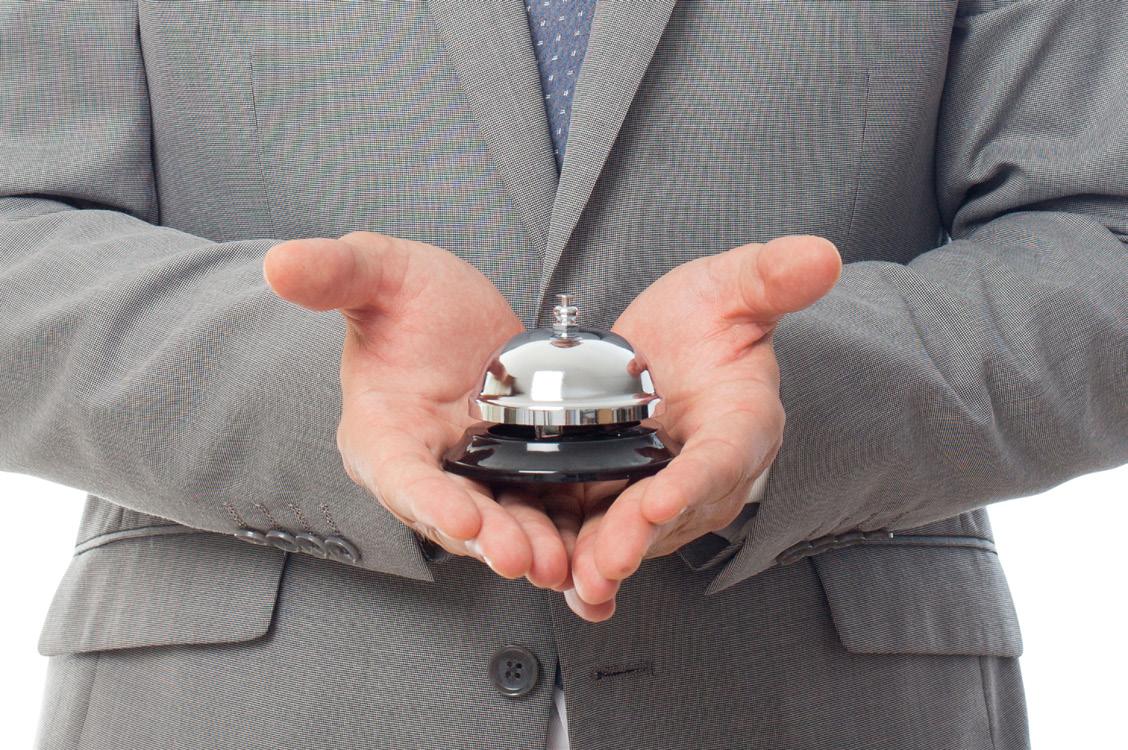

45 MARCH 2024 APRIL GESTIONE ALBERGHIERA
Maurizio Pedrini

tale funzione precede immediatamente quella di direttore d’albergo.
Veniamo a parlare dell’Associazione da lei presieduta: come possiamo presentarla e quali attività state portando avanti?
L’Associazione Direttori d’Albergo è ormai una signora di 70 anni portati bene, nasce a Milano da Maestri dell’accoglienza, che sentirono il bisogno di riunirsi e condividere le loro esperienze, per poter trovare un equilibrio in un settore che stava cambiando. Attualmente stiamo cercando di mettere a disposizione degli associati una ricca offerta di aggiornamento professionale, attraverso il centro studi manageriale Raffaello Gattuso, per poter interpretare e vivere al meglio il cambiamento che sta trasformando profondamente il nostro settore. Una delle ultime iniziative - da noi denominata Adagio, che sta per Ada Giovani - permetterà ai giovani diplomati delle scuole ad indirizzo turistico di interfacciarsi con i colleghi direttori, partecipare ai loro incontri e ne faciliterà l’inserimento nel mondo del lavoro. Il nostro, in definitiva, è un impegno che punta sui giovani, guardando con fiducia al futuro.
Quali saranno, in particolare, le priorità della sua presidenza?
Oltre all’iniziativa di cui abbiamo parlato, che mi sta particolarmente a cuore, ci stiamo anche occupando del nostro tempo libero: abbiamo infatti creato Adacard, un sistema che, per il momento, permetterà ai colleghi membri dell’associazione di muoversi agevolmente in

Italia, godendo di molte agevolazioni e opportunità, pernottando, ad esempio, in alberghi diretti da associati con vantaggi economici e upgrade. Stiamo lavorando per estendere le convenzioni anche in Spagna, Portogallo, Gre -
cia ed altri Paesi europei.
Visto che stiamo allargando la conversazione all’Europa, cosa può dirci della situazione alberghiera in ambito europeo?
CHI È BARTOLOMEO D’AMICO
Nato a Fasano, in provincia di Brindisi, D’Amico fin da ragazzo desidera occuparsi di accoglienza; nel 1974 inizia a frequentare l’Istituto Alberghiero di Brindisi, conseguendo il diploma di Tecnico alle attività Alberghiere. Per tredici anni matura preziose esperienze nei vari reparti d’albergo, fino a diventare capo ricevimento - vice direttore al prestigioso Grand Hotel Rosa Marina di Ostuni. Da trentun anni è alla guida del Grand Hotel

La Masseria Santa Lucia.
All’inizio degli Anni Novanta è stato nominato presidente Ada Puglia, poi vice presidente nazionale; da un anno è alla guida dell’Associazione Nazionale Direttori d’Albergo. Per oltre trent’anni è stato docente nello stesso Istituto Alberghiero brindisino che ha frequentato. Nel 2024 festeggerà i cinquant’anni d’amore per quella che ritiene sia la più bella professione al mondo.
46 MARCH 2024
GESTIONE ALBERGHIERA

L'IMPORTANZA DELLA FORMAZIONE
A.D.A. (Associazione Direttori Albergo) è l’organismo italiano che da oltre sessant’anni promuove il valore professionale della figura del direttore d’albergo, a livello nazionale ed internazionale. Nata nel 1955 da un comitato di 14 promotori e costituita ufficialmente il 25 gennaio 1956 con 26 soci fondatori, oggi ne conta oltre settecento sul territorio nazionale. Il carattere professionale di A.D.A. le consente di sviluppare, sia all’interno della sua rete associativa che nel contesto esterno, relazioni
Dal confronto che abbiamo spesso con quanti svolgono il nostro lavoro in ambito UE, posso solo confermarle senza tema di smentita che i colleghi europei hanno i nostri stessi problemi. Solo per citarne alcuni: il cambiamento repentino delle abitudini degli ospiti, la tecnologia e i collaboratori non più disposti ai sacrifici d’un tempo, la vecchia generazione che stenta ad adeguarsi alle nuove esigenze.
Quali sono gli aspetti positivi e le principali criticità del turismo nel nostro continente che si riverberano sul comparto alberghiero?
Posso solo rimarcare alcuni fondamentali concetti: il turismo è di notevole importanza per il Vecchio Continente in quanto fonte di crescita economica, sviluppo regionale e occupazione. Rappresenta infatti il terzo settore economico e occupazionale, con la vocazione a scalare ulteriori posizioni in prospettiva. Nonostante sia stato significativamente colpito dalla crisi economica negli anni passati, si è dimostrato resiliente, come testimoniato dal crescente numero di visitatori che si recano nell'UE nel corso degli anni. Ciononostante, il turismo europeo si trova a far fronte a una serie di sfide e a una concorrenza sempre maggiore, in particolare da parte di destinazioni non europee emergenti, la cui quota nel mercato mondiale sta gradualmente aumentando. A causa della sua natura trasversale, il turismo subisce gli effetti di varie politiche, comprese quelle dei trasporti, dell'ambiente, della protezione dei consumatori e dello sviluppo regionale.
Come valuta lo stato di salute dell’hotellerie in Italia, un Paese leader nel mondo nel turismo?
sociali tese a valorizzare gli aspetti peculiari della società civile e della cultura dell'ospitalità, i valori della tradizione ed il progresso scientifico e tecnologico. A.D.A. è impegnata in prima linea per il raggiungimento dei più alti standard di qualità in tutto il comparto alberghiero nazionale.
Attraverso il Centro Studi Manageriali “Raffaello Gattuso”, organo fondato nel 1975, l'Associazione promuove l'alta formazione e l’aggiornamento professionale continuo dei suoi soci, con l’obiettivo di potenziare la crescita culturale manageriale italiana
Gli hotel Italiani stanno attraversando un periodo di grandi cambiamenti: la pandemia ha accelerato in qualche modo questa rapida trasformazione, rinforzando i più forti e facendo fallire i più deboli, favorendo una sorta di selezione naturale che è certamente destinata a proseguire. La sfida consiste nel mettersi al passo con i tempi a livello tecnologico, formare i collaboratori fidelizzandoli, proprio come si fa con gli ospiti. Sono ottimista di natura, ma anche gli oggettivi riscontri che ricevo quotidianamente dalla categoria sono positivi, perché vi è un grande impegno in questa direzione. Dunque, nutro buone speranze.
Tornando alla difficile esperienza pandemica, in che modo questa ha cambiato le abitudini della clientela?
Sintetizzando al massimo, soffermandosi sulle
nel settore alberghiero in aderenza ai mutamenti dell’economia globale e alle sempre nuove esigenze formative che ne derivano.
Il Centro Studi dispone inoltre di un osservatorio turistico e organizza convegni sui temi più attinenti la professione, operando anche per conto di Solidus, confederazione che raggruppa sette tra le maggiori associazioni professionali del comparto turistico, con oltre 57.000 professionisti di tutti i settori alberghieri, di cui A.D.A. è fondatrice e ne ha attualmente la Presidenza.
trasformazioni psicologiche, potrei risponderle che, mentre una volta il cliente era un viaggiatore deciso a perdersi in un’oasi di relax, oggi è un viandante che vuole ritrovarsi e vivere esperienze concrete e sostenibili. Il tutto in condizioni di massima sicurezza, comfort e igiene.
A proposito di pulizia negli hotel: quali sono gli aspetti che oggi hanno maggior valore, agli occhi del cliente?
Su questo non ho dubbi: l’ospite si aspetta e pretende una stanza perfettamente pulita e igienizzata, ma anche tutti i reparti lo devono essere di pari passo, con un’attenzione particolare agli ambienti della ristorazione e della Spa. I nostri ospiti possono accettare un receptionist poco simpatico o un cameriere frettoloso, ma sicuramente sono intransigenti sulla pulizia e sull’igiene di qualsiasi reparto.


47 MARCH 2024
Cleaning will never be the same again
A system to optimise processes and a wringer that wrings itself: TTS is ready to revolutionise cleaning with two new highly innovative professional solutions
Lampo and Wiz join the more than 4200 items in the catalogue, the result of experience gained in the field in over thirty years of activity combined with an accurate analysis of the needs of a constantly evolving market. Thanks to TTS innovations, the operator will finally be able to use the same handle to remove cobwebs, dust high surfaces, shine glass, clean floors and will no longer have to endlessly wring out mops to eliminate all excess water.
ONE SYSTEM FOR ALL SURFACES
Lampo is the first immediate fixing and releasing system that allows you to use a single handle with
all your equipment for cleaning surfaces, glass and floors, eliminating wasted time and greatly improving operability. Thanks to the Jack adapter for handles and poles, you can instantly attach dusters, web brushes, scrapers, window washers, squeegees and floor frames, keeping them firmly anchored during use. Not only that, the operator can also attach the tank handle to the frames to clean small areas or remove unexpected dirt.
The Plug device for Magic and Nickita trolleys, on the other hand, allows the frames to be unhooked directly on the trolley, without any hand contact with contaminated surfaces. The use of a single handle frees the trolley from the multitude of obstacles that slow down operation, allowing even the most compact trolley to be fully equipped to create a

complete cleaning station
MAXIMUM WRINGING, WITHOUT EFFORT
Wiz optimises performance by minimising effort: the unique plate wringer wrings out 10 to 20% more than conventional wringers, reducing the drying time of the floor.
It also features an adjust-
ment system that allows four different wringing intensities to be set, varying the mop moisture according to need and keeping it constant with each wringing. The result is therefore no longer dependent on the strength of the operator who simply has to accompany the lever to the end of its stroke, without being for-
Un sistema per ottimizzare i processi e uno strizzatore che strizza da solo: TTS è pronta a rivoluzionare la pulizia con due nuove soluzioni professionali ad alto contenuto innovativo. Lampo e Wiz si uniscono agli oltre 4200 articoli a catalogo, frutto dell’esperienza maturata sul campo in oltre trent’anni di attività unita a un’analisi accurata delle esigenze di un mercato in continua evoluzio-
ne. Grazie alle innovazioni TTS, l’operatore potrà finalmente usare lo stesso manico per rimuovere le ragnatele, spolverare le superfici elevate, far brillare i vetri, pulire i pavimenti e non dovrà più strizzare all’infinito i panni per eliminare tutta l’acqua in eccesso.
Un solo sistema per ogni superficie Lampo è il primo sistema di aggancio e sgancio immediato che permette di usare un solo manico con tutta l’attrezzatura per la pulizia di superfici, vetri e pavimenti, eliminando gli sprechi di tempo e migliorando notevolmente l’operatività. Grazie all’adattatore Jack per manici e aste è possibile agganciare all’istante piumini, scovoli, raschietti, supporti vello, tergivetro e telai pavimento , mantenendoli fermamente ancorati du -
ttsystem.com
La pulizia non sarà più la stessa
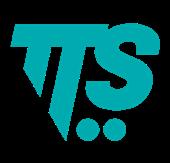
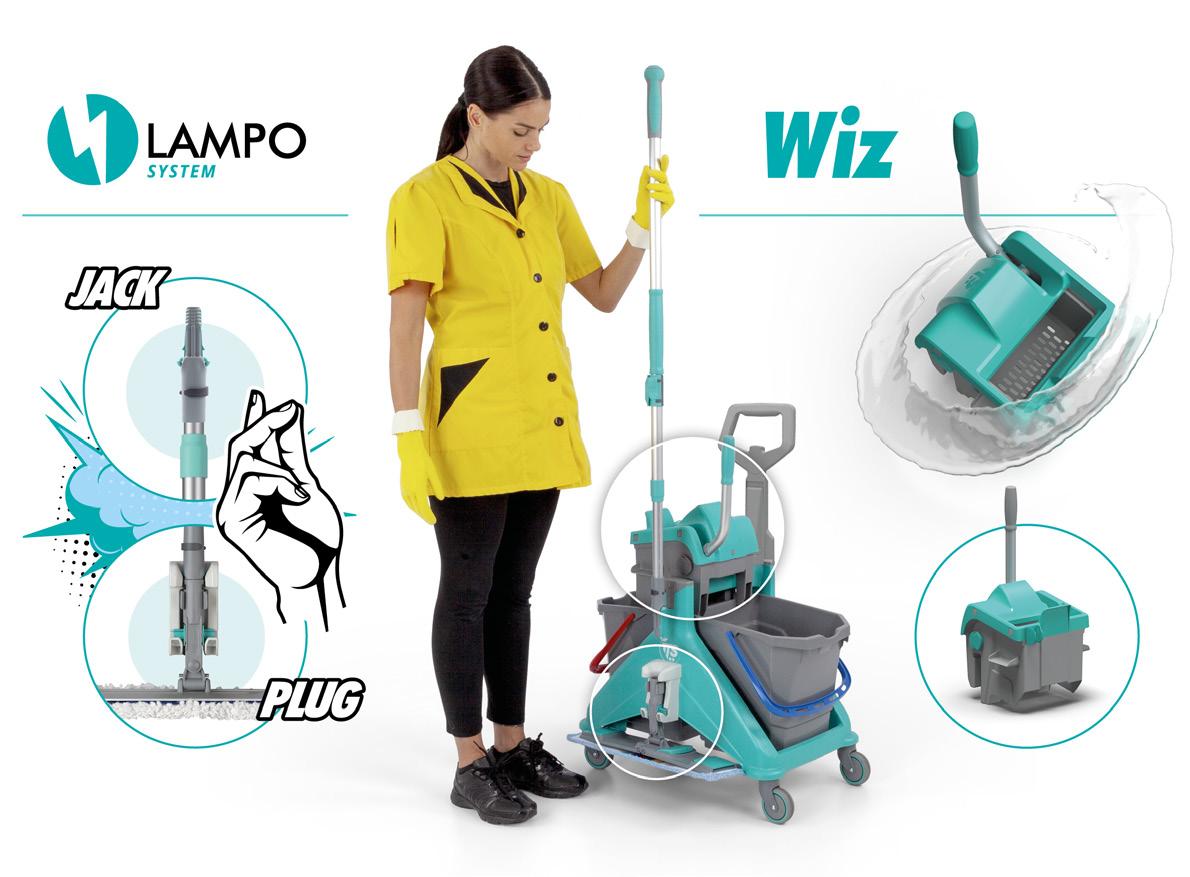
ced to repeat the operation several times.
No matter what wringing in-
tensity is set or which mop is used, Wiz always requires half the effort compa-
rante l’utilizzo. Non solo: l’operatore può anche agganciare il manico serbatoio ai telai per pulire piccoli ambienti o rimuovere lo sporco imprevisto.
L’apposito dispositivo Plug per carrelli Magic e Nickita consente invece di sganciare i telai direttamente sul carrello , senza alcun contatto delle mani con superfici contaminate. L’utilizzo di un unico manico libera il carrello dalla moltitudine di ostacoli che rallentano l’operatività, consentendo di attrezzare al massimo anche quello più compatto per
red to traditional wringers, reducing the risk of injuries and muscle pains: field tests
creare una stazione di pulizia completa
Strizzare al massimo, senza sforzi Wiz massimizza le prestazioni minimizzando gli sforzi: l’esclusivo strizzatore a piastra strizza dal 10 al 20% in più rispetto agli strizzatori tradizionali , riducendo il tempo di asciugatura del pavimento. Si distingue inoltre per il sistema di regolazione che permette di impostare quattro diverse intensità di strizzaggio , variando l’umidità del ricambio in base alle esigenze e mantenendola costante a ogni
show a reduction in effort of 50 to 70 per cent, resulting in less fatigue.
strizzatura. Il risultato non è quindi più legato alla forza dell’operatore che deve semplicemente accompagnare la leva fino a fine corsa, senza essere obbligato a ripetere l’operazione più volte. Qualunque sia l’intensità di strizzaggio impostata o il ricambio utilizzato, Wiz richiede sempre la metà degli sforzi rispetto agli strizzatori tradizionali, riducendo il rischio di infortuni e dolori muscolari: test sul campo evidenziano infatti una riduzione dello sforzo dal 50 al 70% che si traduce in un minor affaticamento.
sponsored content
E-Tissue, the “First-gen” recycled paper as strong yet delicate as pure pulp
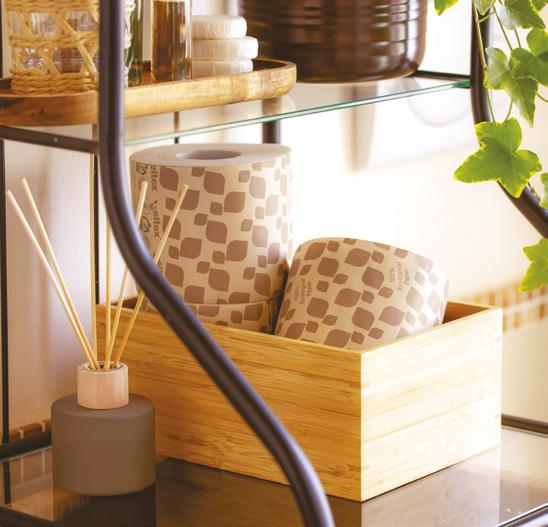
Quality, waste reduction and sustainability are increasingly central principles in the field of professional cleaning. Sharing the same values, Celtex offers to cleaning professionals the E-Tissue line, the “first-
gen” recycled paper which gives new life to pure pulp fibres and kraft offcuts, both recovered in pre-consumer phase. A clear example of circular economy able to combine performance, affordability and environ-
mental commitment. E-Tissue has a delicate shade resulting from its sand-coloured kraft origin, a guarantee of maximum absorbency and resistance, even when wet with a non-invasive smell. E-Tissue line covers the main demands of the Away From Home market, from industrial rolls, to handtowel and single-wrapped toilet paper, features an elegant decoration that furnishes the toilet with style and sophistication. E-Tissue paper is 100% natural, delicate on the skin and PEFC and Ecolabel certified, in full respect of forests and the specific environmental criteria required by the European Union. The special Flutech® technology allows to E-Tissue toilet papers to dissolve in 15 seconds in contact with water in combination with the mechanical movement of the drain,

preventing unpleasant pipe clogs. A guarantee of efficiency for managers and an assurance of service availability for the customers. E-Tissue: performance, pleasantness and affordability, in full respect of the environment.
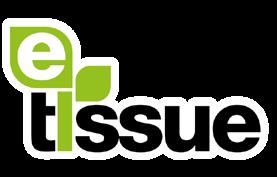
E-Tissue, il riciclato di prima generazione forte e delicato come una pura cellulosa
Qualità, attenzione agli sprechi ed ecosostenibilità sono concetti sempre più importanti nel settore dell’igiene e della pulizia professionale. In condivisione con questi valori, Celtex propone agli operatori del cleaning E-Tissue, la carta riciclata di “prima generazione” che regala nuova vita agli sfridi della pura cellulosa e del kraft, entrambi recuperati in fase di pre-consumo. Un esempio di circolarità capace di coniugare performance, convenienza e impegno ambientale. Una carta
dalla delicata tonalità avana, che conserva le principali caratteristiche della materia prima da cui deriva, a garanzia di massima assorbenza e resistenza , anche ad umido e che non rilascia odori sgradevoli . La gamma E-Tissue copre le principali richieste del mercato, dalle bobine, agli asciugamani alla carta igienica mono fascettata, caratterizzata da un decoro elegante e delicato, che arreda l’area bagno con stile e raffinatezza. La carta è 100% naturale, delicata sulla pelle e certificata PEFC e EU
Ecolabel, nel rispetto delle foreste e dei criteri richiesti dall’Unione Europea. Grazie alla speciale tecnologia Flutech®, inoltre, le carte igieniche E-Tissue si dissolvono in 15 secondi in combinazione al movimento meccanico del wc, prevenendo le sgradevoli occlusioni delle tubature. Una garanzia di efficacia per il gestore del locale e una sicurezza di disponibilità dei servizi per il cliente.
E-Tissue: performance, gradevolezza e convenienza, nel pieno rispetto dell’ambiente.
industrieceltex.com sponsored content








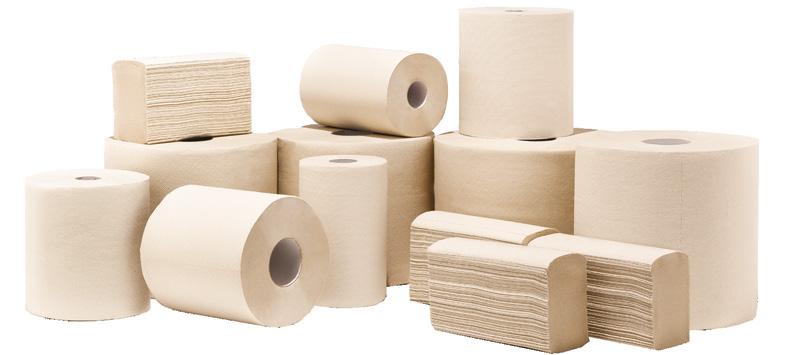
“FIRST-GEN
RECYCLED
VISIT US Booth 10.207
”
PAPER

AN INNOVATIVE “FIRST-HAND” RECYCLED PAPER
E-Tissue recycled paper is a unique product, created through an exclusive manufacturing process that reuses Kraft offcuts and pure pulp fibres that have been recovered from the converting line In a circular economy perspective, the productive cycle even incorporates manufacturing offcuts of E-Tissue itself.
FLUTECH TECHNOLOGY RESULTS IN CLOG-FREE PIPES*
15s
PEFC/18-32-24
Thanks to Flutech technology, E-Tissue toilet paper dissolves in water within 15 seconds once flushed, avoiding frustrating blockages and plumbing costs.
THE E-TISSUE RECYCLING PROCESS

RECOVERY OF PURE CELLULOSE FIBRES
PEFCRecycled CRITERIA EU GPP CAM
*”Flushability” tests carried out as per Regulation AFNOR: NF Q 34-020:1998, in an accredited laboratory. CONVERTING
RECYCLED SOLUTIONS AS
STRONG YET DELICATE AS PURE PULP PAPER

RESISTANT
Strong, even when wet.
PLEASANT SMELLING
Non-invasive smell, even when wet.
ABSORBENT
Outstanding absorbency.
AFFORDABLE
An ideal solution across the Away From Home sector.
SOFT
Pleasant to the touch.
DELICATE ON THE SKIN
Dermatologically tested.
MADE FROM RECOVERED PRE-CONSUMER FIBRES
Combining quality, cost-effectiveness and the commitment of Industrie Celtex to reducing environmental impact, the E-Tissue range strikes the perfect balance between quality performance and environmental care that the Away From Home market demands.
This is achieved through a process that doesn’t generate fibre waste by using and giving new life to materials that would otherwise be thrown away

NEW LIFE FOR FIBRES FIBRE WASTE GENERATED
NATURAL COLOUR ADDED OPTICAL BRIGHTENERS* CO2 EMISSIONS
SELF-GENERATED ELECTRICITY WATER CONSUMPTION
PHOTOVOLTAIC PANELS
* No optical brighteners are intentionally added during our production process.
** Compared to conventional methods employed by Industrie Celtex.
*** Compared to pure pulp equivalent of Industrie Celtex. -20%*** 100% 0 1900 0 100% -75%** 55%
www.industrieceltex.com
Indoor environment and assessment of cleaning effectiveness
The quality of the indoor environment is to a large extent dependent on proper cleaning and maintenance. Research indicates that cleaning can be beneficial in providing a healthy indoor environment
Deborah
L. Franke, Eugene C. Cole, DrPH, Keith E. Leese, PhD, Karin K. Foarde and Michael A. Berry, PhD
In a previous RTI and EPA cooperative study in Denver, the air quality was measured in 16 noncompliant, carpeted, indoor environments both before and during different methods of carpet cleaning. Monitoring was conducted for total volatile organic compounds (TVOCs), respirable particles, and biopollutants. Monitoring before cleaning provided baseline environmental data and instrument evaluations, while monitoring during cleaning provided original data for the assessment of the contribution of carpet cleaning to airborne pollution. Replicate site monitoring was conduct-
ed for each of the five carpet cleaning techniques: dry foam, shampoo, absorbent pad, dry absorbent compound, and steam cleaning. Cleaning was carried out by professionals according to industry standard methods.
The Denver study data suggested that neglected and uncleaned carpet was associated with biopollution affecting the quality of the indoor air. In general, the contribution of carpet cleaning itself to indoor air pollution was negligible. However, in certain sites elevated TVOCs resulted from the use of chemical presprays and spotting solvents on very soiled carpets, and in others,
This article is reprinted with permission from issue 1, volume 5, of The Journal of Cleaning Science, the official peer-review journal of the Cleaning Industry Research Institute (CIRI)
respirable airborne particulate levels resulted from the use of dry absorbent compounds. As a result of the Denver study, EPA, RTI, and the cleaning industry saw a need to conduct a longterm study on cleaning and its effect on indoor environmental quality.
Objective
The primary objective of this study was to better understand the cleaning (pollutant removal) process and its relationship to indoor air quality. While the task of assessing cleaning effectiveness was more difficult in an environment with relatively low levels

55 MARCH 2024
INDOOR AIR QUALITY
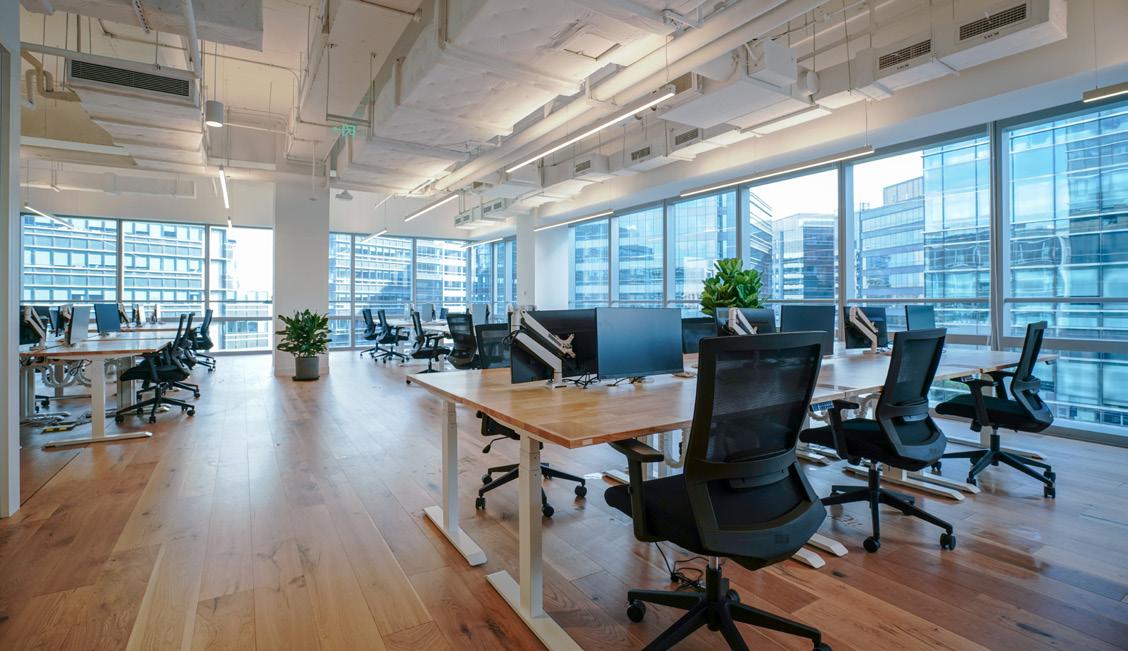
of pollutants, a nonproblem building was sought because it would be representative of most work environments, and because the data would add to the relatively sparse database of “normal” pollutant levels in nonproblem or ‘healthy’ buildings. Specific and related objectives were:
1) To conduct environmental screening monitoring to confirm and characterize the building as a non-problem environment.
2) To develop and implement an economically feasible, improved housekeeping/cleaning program to improve building indoor air quality.
3) To assess the effectiveness of the cleaning program through long-term environmental sampling and comprehensive analyses.
4) To examine the relationships among airborne, non-floor surface, and floor dust bio pollutants.
5) To investigate the correlation of airborne particles (dust and laser particle count data) with surface dust concen-

trations.
6) To investigate the influence of outdoor pollutant levels and climate factors on indoor air quality.
7) To establish guidelines and associated costs for routine building cleaning and pollution prevention.
8) To add data to the relatively sparse database of “normal” pollutant levels in non-problem or “healthy” buildings. Data from this study is intended to provide new information about the ecology of non-problem buildings and the roles of cleaning and maintenance in the prevention of indoor air quality problems.
Project description
In the earlier Denver study, the RTI monitored for bioaerosols, chemicals, and particles before and during carpet cleaning in commercial and residential environments. Noncompliant environments were selected, although problems were found in two of the buildings. In general, the pollutant lev-
els before and during carpet cleaning were related to the extent of routine cleaning in the building. As an extension of that research, a new study was planned to better understand and assess the effectiveness of an economically feasible, standard cleaning program to improve indoor air quality in a building, and to generate an extensive database characterizing a nonproblem or “healthy” building environment. This study represents an early example (which is being utilized with increasing frequency) of government, not-forprofit organizations, and industry collaboration, as industry representatives served on an advisory committee and provided technical guidance in selected areas of key importance to the success of the research. After extensive protocol development by the many collaborators, the year-long environmental monitoring effort was performed at the Frank Porter Graham Child Development Center (FPG) at the University of North Carolina, Chapel Hill, NC.
56 MARCH 2024 INDOOR AIR QUALITY
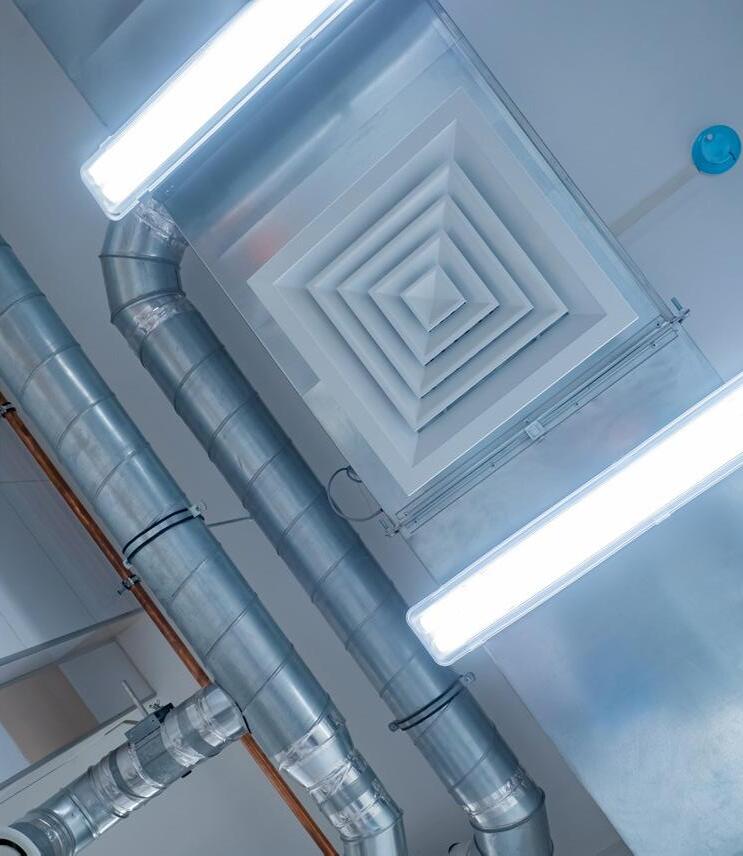
This 20-year-old building has four floors and approximately 2,700 m 2 , 66% of which is carpeted. There is a daycare facility for 62 children, and 214 adults work with the daycare and in the offices and laboratories of the building. Two full-time university housekeeping staff are assigned to the building. The environmental monitoring included bioaerosols sampling, non-floor surface biologicals, floor dust samples for mass and biologicals, aerosol particle counts, aerosol dust mass, volatile organic compounds, and comfort factors such as temperature, relative humidity, carbon monoxide, and carbon dioxide. Initially, the building was inspected, and an extensive environ-
mental screening was conducted to confirm it as a building without indoor air quality problems. Monitoring was performed monthly for the remainder of the study.
During the first four months of monitoring, no changes were made in the routine housekeeping of the building. Then, outside professional companies cleaned the building to include walls, furniture, light fixtures, bathrooms, windows, tile floors, and carpets. At the same time, new equipment and supplies were introduced, and the building housekeeping staff was trained to use the new equipment and to institute and follow a standardized or "improved housekeeping" program
of environmental cleaning. From January to July 1993, monthly environmental monitoring continued as the improved house-keeping procedures were followed. Additionally, special emphasis was placed on environmental management strategies, including source and activity management.
Environmental guidelines included:
• Providing for safety.
• Cleaning for health first and appearance second.
• Maximizing extraction of pollutants from the building envelope.
• Minimizing chemical, particle and moisture residue.
• Minimizing human exposure to pollutants.
• Cleaning to improve the total environment.
• Disposing properly of cleaning wastes.
Summary of major findings
• Airborne dust mass, measured as total suspended particles (TSP), provided the most meaningful particle data and showed a statistically significant reduction with improved cleaning.
• Immediately after deep cleaning, carpet dust mass was reduced, particularly on floors with the highest dust loads.
• Soon after deep cleaning, carpet dust mass loads quickly returned to before cleaning levels, confirming carpet as a sink or collector of particles.
• Airborne dust mass was decreased after deep cleaning and continued lower even though the total mass from dust in carpets soon returned to original levels.
Biopollutant results: correlations
• Airborne levels of bio pollutants correlated with airborne dust mass, and the bacteria correlation is statistically significant.
• Levels of carpet dust bacteria have a statistically significant correlation with airborne bacteria indicating a relationship between the two that demonstrates the need for cleaning

57 MARCH 2024
(pollutant removal) as an environmental management tool for maintaining acceptable air quality.
• Isolated occurrences of elevated levels of indicator fungi (Penicillium, Cladosporium, Aspergillus) and bacteria (gram-negatives, actinomycetes) suggest the need for frequent, effective cleaning to keep the building under control.
• Deep cleaning resulted in reduction of mean levels of:
- airborne bacteria (58%) and fungi (25%).
- nonfloor surface bacteria (58%) and fungi (15%).
- carpet dust bacteria (76%), fungi (99%), and endotoxin (98%).
Overall Results
An organized cleaning program, based on environmental management principles and fundamental environmental protection guidelines, contributed
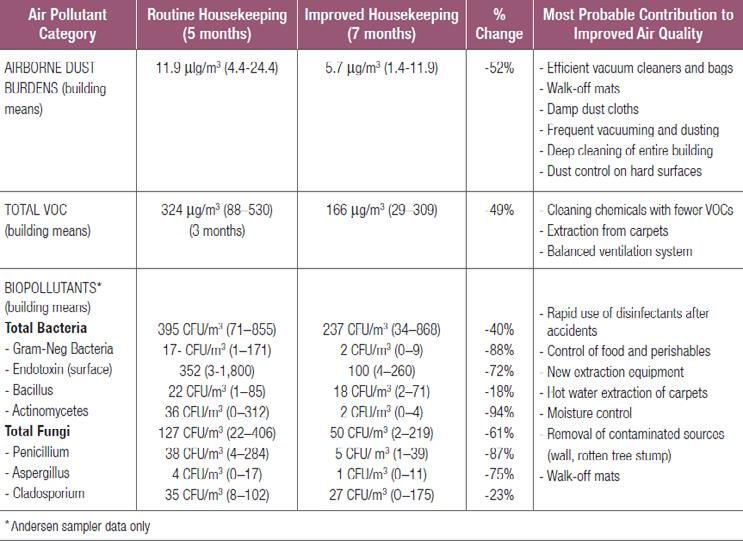
Biopollutant results of data comparison
• A year-long study of a nonproblem building showed that attention to improved housekeeping (in conjunction with proper HVAC operation and maintenance), resulted in sustained reduction of mean levels of:
- airborne bacteria (40%) and fungi (61%).
- nonfloor surface bacteria (29%) and fungi (25%).
- carpet dust bacteria (84%), fungi (93%), and endotoxin (72%).

to indoor air quality through the reduction of total suspended particles (TSP), total volatile organic compounds (TVOCs), and culturable bacteria and fungi. While airborne pollutants increased during deep cleaning, they never reached levels of concern to the researchers, and were shown to decrease rapidly to levels well below the “pre-cleaning” concentrations. The study data suggests that environmental pollution can be significantly controlled through an effective and managed indoor cleaning program.
Routine, nonfloor, surface bacterial and fungal sampling can help identify areas for focused cleaning, as well as provide a useful assessment of a building's changing microbial ecology.
Future IAQ and Pollution Prevention Research
• Use developed air and surface monitoring approaches to characterize and evaluate problem buildings.
• Determine if non-carpeted buildings have significantly different levels of airborne dust and biopollutants than carpeted buildings (data from this study suggests that clean carpets could have a biological “sink” effect).
• Develop methods to evaluate the effectiveness of HVAC cleaning procedures.
• Develop a method to use simplified surface monitoring to characterize air quality (dust and biologicals).
• Develop biopollutants source management criteria, particularly those dealing with moisture control to control mold growth in various building materials.
Notes
1. Berry, M. A. 1993. Protecting the Built Environment: Cleaning for Health. Chapel Hill, NC; Tricomm 21st Press.
2. IICUC, 1991. Carpet Cleaning Standard: S001-1991. Vancouver, WA; International Institute of Carpet and Upholstery Certification.
3. Pope, A. M., Patterson, R. and Burge, H. 1993. Indoor Allergens: Assessing and Controlling Adverse Health Effects. Washington, DC; National Academy Press.
4. Cole, E. and Foarde, K. 1992. “Indoor Air Monitoring in Carpeted Environments, Part II: A Case Study in Quantitative Measurements” The Proceedings of the NATO/CCMS Pilot Study on Indoor Air Quality. Report on the 6th Plenary Workshop. Chapel Hill, NC; May 4, 1992.
58 MARCH 2024 INDOOR AIR QUALITY
Tab 1- Effects of cleaning on indoor air quality
VALUTAZIONE DELL'EFFICACIA DI PULIZIA IN AMBIENTE INDOOR
La salubrità dell'ambiente interno dipende in larga misura da una corretta pulizia e manutenzione. Diversi studi effettuati nel campo della scienza della pulizia indicano che la pulizia ha un ruolo primario nel garantire un ambiente indoor sano
Deborah L. Franke, Eugene C. Cole, DrPH, Keith E. Leese, PhD, Karin K. Foarde and Michael A. Berry, PhD
Questo articolo è stato originariamente pubblicato, e qui riprodotto con autorizzazione, sul numero 1, volume 5, del The Journal of Cleaning Science , la rivista ufficiale di peer-review del Cleaning Industry Research Institute (CIRI)
Uno studio effettuato a Denver (USA), prende in esame la qualità dell'aria misurata in 16 ambienti interni non a norma, dotati di moquette, sia prima che durante diversi metodi di pulizia della stessa. Il monitoraggio è stato condotto per i composti organici volatili totali (TVOC), le particelle respirabili e i bioinquinanti. Il monitoraggio prima della pulizia ha fornito dati ambientali di base e valutazioni strumentali, mentre il monitoraggio durante la pulizia ha fornito dati originali per la valutazione del contributo della pulizia dei tappeti all'inquinamento atmosferico. Il monitoraggio di siti replicati è stato condotto per ciascuna delle cinque tecniche di pulizia della moquette: schiuma secca, shampoo, tampone assorbente, composto assorbente secco e pulizia a vapore. La pulizia è stata effettuata da professionisti del settore.
I dati dello studio di Denver suggeriscono che la moquette trascurata e non pulita influisce negativamente sulla qualità dell'aria interna. In generale, il contributo della pulizia della moquette all'inquinamento dell'aria interna è stato trascurabile. Tuttavia, in alcuni siti, l'uso di prespaziatori chimici e di solventi per smacchiare i tappeti molto sporchi ha portato a livelli elevati di TVOC, mentre in altri i livelli di particolato respirabile nell'aria sono stati
causati dall'uso di composti assorbenti a secco. A seguito dello studio di Denver, ne è stato condotto uno a lungo termine sulla pulizia e sul suo effetto sulla qualità ambientale interna.
Obiettivo
L'obiettivo primario di questo studio è stato quello di comprendere meglio il processo di pulizia e la sua relazione con la qualità dell'aria interna. Sebbene il compito di valutare l'efficacia della pulizia sia più difficile in un ambiente con livelli relativamente bassi di inquinanti, ci si è basati su un edificio non problematico perché rappresentativo della maggior parte degli
associati per la pulizia ordinaria degli edifici.
Il progetto
In generale, i livelli di inquinanti prima e durante la pulizia della moquette erano correlati all'entità della pulizia di routine nell'edificio. Come estensione di questa ricerca, è stato pianificato un nuovo studio per comprendere e valutare meglio l'efficacia di un programma di pulizia standard economicamente fattibile per migliorare la qualità dell'aria interna di un edificio e per generare un ampio database che caratterizzi un ambiente non problematico o "sano". Il monitoraggio ambientale, durato un

ambienti di lavoro. Gli obiettivi specifici e correlati sono stati: sviluppare un programma di pulizia e manutenzione economicamente fattibile per migliorare la qualità dell'aria interna dell’edificio; valutare l'efficacia del programma di pulizia attraverso campionamenti ambientali a lungo termine e analisi complete; indagare la correlazione delle particelle trasportate dall'aria con le concentrazioni di polvere in superficie; studiare l'influenza dei livelli di inquinanti esterni e dei fattori climatici sulla qualità dell'aria interna; stabilire linee guida e costi
anno, è stato effettuato presso il Frank Porter Graham Child Development Center (FPG) dell'Università del North Carolina, a Chapel Hill, NC. Questo edificio di 20 anni ha quattro piani ed è ampio circa 2.700 m 2 , il 66% dei quali è rivestito di moquette.
Il monitoraggio ambientale ha incluso il campionamento di bioaerosol, di sostanze biologiche non presenti sulla superficie del pavimento, di campioni di polvere del pavimento per la massa e le sostanze biologiche, di composti organici volatili e di fattori di comfort come la temperatura,

59 MARCH 2024
INDOOR AIR QUALITY
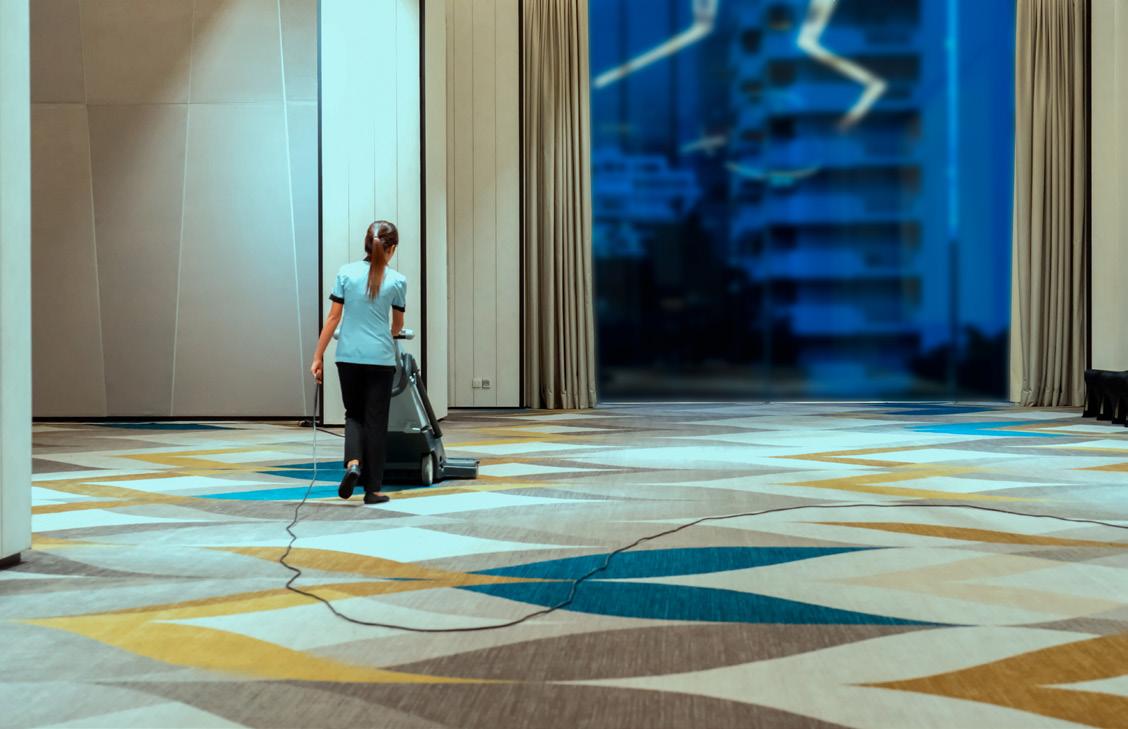
l'umidità relativa, il monossido di carbonio e l'anidride carbonica. Inizialmente, l'edificio è stato ispezionato ed è stato condotto uno screening ambientale approfondito per confermare che si trattava di un edificio senza problemi di qualità dell'aria interna. Il monitoraggio è stato effettuato mensilmente per il resto dello studio. Durante i primi quattro mesi di monitoraggio, non sono state apportate modifiche alla manutenzione ordinaria dell'edificio. In seguito, imprese professionali esterne hanno pulito l'edificio, compresi muri, mobili, apparecchi di illuminazione, bagni, finestre, pavimenti in piastrelle e tappeti. Contemporaneamente, sono state introdotte nuove attrezzature e il personale addetto alle pulizie dell'edificio è stato addestrato a utilizzare le nuove attrezzature e a istituire e seguire un programma di pulizia ambientale standardizzato o "pulizia migliorata". Il monitoraggio ambientale mensile è proseguito con l'applicazione delle procedure di pulizia migliorate. Inoltre, è stata data particolare importanza alle strategie di gestione ambientale, compresa la gestione delle fonti e delle attività.
Le linee guida ambientali comprendevano:
- Pulire per la salute prima che per l’estetica.
- Ridurre al minimo i residui di sostanze chimiche, particelle inquinanti e umidità.
- Ridurre al minimo l'esposizione umana agli

inquinanti.
- Pulizia per migliorare l'ambiente complessivo.
- Smaltire correttamente i rifiuti di pulizia.
Principali risultati
La massa di polvere nell'aria ha mostrato una riduzione statisticamente significativa con il miglioramento della pulizia; subito dopo una pulizia profonda, la massa di polvere dei tappeti si è ridotta, in particolare sui pavimenti con i carichi di polvere più elevati; subito dopo la pulizia profonda, i carichi di polvere della moquette sono tornati rapidamente ai livelli precedenti la pulizia, confermando che la moquette è un collettore di particelle; la massa di polvere trasportata dall'aria è diminuita dopo la pulizia profonda e ha continuato a diminuire, anche se la massa totale di polvere nei tappeti è tornata presto ai livelli originali.
Risultati del confronto dei dati sui bio inquinanti
Uno studio di un anno su un edificio non problematico ha dimostrato che l'attenzione a una migliore pulizia (insieme a un funzionamento e a una manutenzione adeguati del sistema HVAC) ha portato a una riduzione sostenuta dei livelli medi di:
- batteri presenti nell'aria (40%) e funghi (61%).
- batteri delle superfici non a pavimento (29%) e funghi (25%).
- batteri della polvere dei tappeti (84%), funghi (93%) ed endotossine (72%).
La pulizia profonda ha portato alla riduzione dei livelli medi di:
- batteri nell'aria (58%) e funghi (25%).
- batteri delle superfici non a pavimento (58%) e funghi (15%).
- batteri della polvere dei tappeti (76%), funghi (99%) ed endotossine (98%).
Risultati complessivi
Un programma di pulizia organizzato, basato sui principi di gestione ambientale e sulle linee guida fondamentali per la protezione dell'ambiente, ha contribuito alla qualità dell'aria interna attraverso la riduzione delle particelle totali sospese, dei composti organici volatili totali (TVOC) e dei batteri e funghi. Sebbene gli inquinanti presenti nell'aria siano aumentati durante la pulizia profonda, non hanno mai raggiunto livelli preoccupanti per i ricercatori e hanno dimostrato di diminuire rapidamente a livelli ben inferiori alle concentrazioni "pre-pulizia". I dati dello studio suggeriscono che l'inquinamento ambientale può essere controllato in modo significativo attraverso un programma di pulizia degli ambienti interni efficace e gesti-
60 MARCH 2024 INDOOR AIR QUALITY
RUBINO CHEM
MAGICA ESSENZA IGIENIZZANTE
to. Il campionamento di routine dei batteri e dei funghi non presenti sui pavimenti può aiutare a identificare le aree da pulire in modo mirato, oltre a fornire un'utile valutazione dell'ecologia microbica in evoluzione di un edificio.
Obiettivi di ricerca futura
Utilizzare approcci sviluppati per il monitoraggio dell'aria e delle superfici per caratterizzare e valutare gli edifici problematici; sviluppare metodi per valutare l'efficacia delle procedure di pulizia HVAC; sviluppare un metodo per utilizzare un monitoraggio semplificato delle superfici per caratterizzare la qualità dell'aria (polveri e sostanze biologiche); sviluppare criteri di gestione delle fonti di bio inquinanti, in particolare quelli relativi al controllo dell'umidità per controllare la crescita di muffe in vari materiali da costruzione.
Note
toring in Carpeted Environments, Part II: A Case Study in Quantitative Measurements” The Proceedings of the NATO/CCMS Pilot Study on Indoor Air Quality. Report on the 6th Plenary Workshop. Chapel Hill, NC; May 4, 1992.
Magica Essenza Pro-Line di Rubino Chem, è un formulato polifunzionale ad alta concentrazione con spiccata azione igienizzante e a pH neutro utilizzato per detergere, rimuovere germi e batteri con azione meccanica, spolverare, profumare e deodorizzare ambienti e superfici. Il formulato Magica Essenza Pro-Line è stato progettato per rispondere alle necessità degli utilizzatori professionisti. Il marchio registrato Trademark e il formulato hanno mantenuto nel tempo la peculiare alta qualità e identità riconosciuta e apprezzata dai clienti utilizzatori finali. Un’icona che nome e funzioni legano da sempre all’universo del cleaning e dei clienti più esigenti. Disponibile in flaconi da 750ml in 16 fragranze.
rubinochem.it
1. Berry, M. A. 1993. Protecting the Built Environment: Cleaning for Health. Chapel Hill, NC; Tricomm 21st Press.
2. IICUC, 1991. Carpet Cleaning Standard: S0011991. Vancouver, WA; International Institute of Carpet and Upholstery Certification.
3. Pope, A. M., Patterson, R. and Burge, H. 1993. Indoor Allergens: Assessing and Controlling Adverse Health Effects. Washington, DC; National
TTS CLEANING
DESIGNED TO AMAZE YOU
Wiz è l’esclusivo strizzatore a piastra che strizza dal 10 al 20% in più rispetto agli strizzatori tradizionali riducendo il tempo di asciugatura del pavimento. Il sistema di regolazione permette di impostare quattro diverse intensità di strizzaggio, variando l’umidità del ricambio in base alle esigenze e mantenendola costante a ogni strizzatura. Qualunque sia il ricambio utilizzato o l’intensità di strizzaggio impostata, Wiz richiede sempre la metà degli sforzi rispetto agli strizzatori tradizionali: test sul campo evidenziano infatti una riduzione dello sforzo dal 50 al 70% che si traduce in un minor a aticamento. ttsystem.com
Tab 1: effetti della pulizia sulla qualità dell’aria interna







































All references in the cleaning industry, from production to distribution chain Browse the 2024 edition
www.dimensionepulito.it 4CleanPro GLOBALE, PROFESSIONAL cleaning ITALIA 2024 Tutti i riferimenti della filiera della pulizia professionale, dalla produzione alla distribuzione Sfoglia l'edizione del 2024
Green economy where do we stand?
Not postponing but anticipating and accelerating investment in the green transition and renewable energy can not only increase financial stability, but can reduce costs in the medium term and promote made in Italy
edited by Simone Ciapparelli
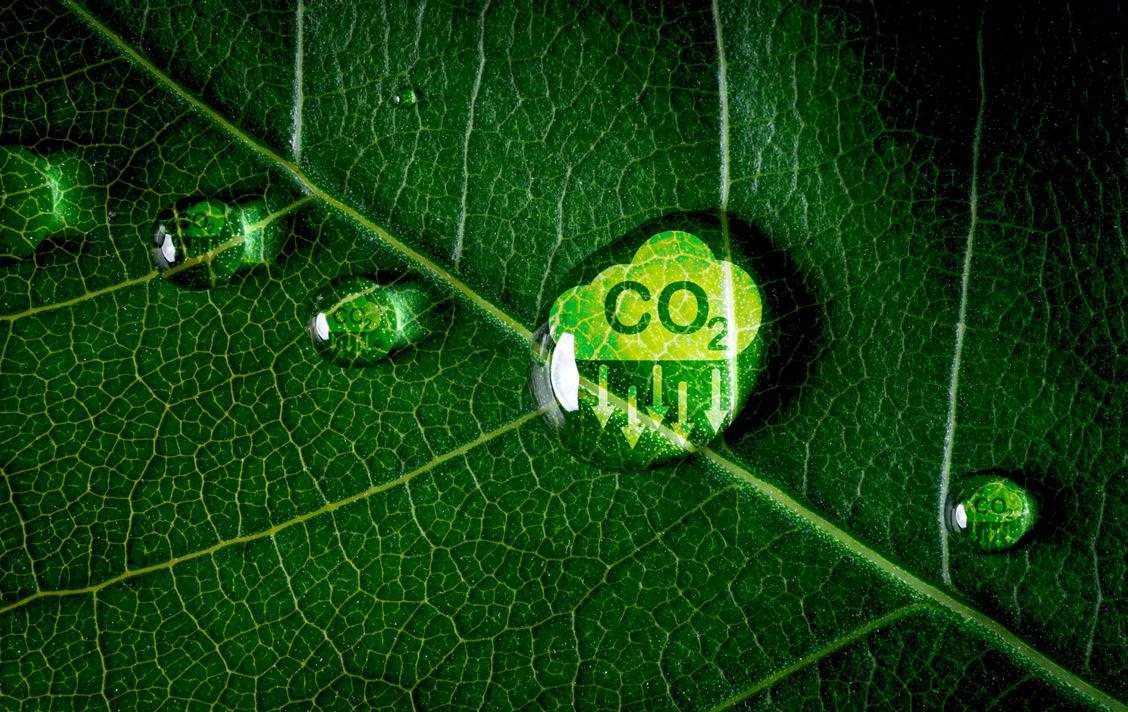

62 MARCH 2024
ENVIRONMENT
The environmental and climate situation on our planet appears to be increasingly critical. In 2022, energy-related greenhouse gas emissions reached a record 36.8 billion tons, bringing the temperature rise ever closer to the 1.5 °C limit set by the Paris Agreement. The latest report by the IPCC (the Intergovernmental Panel on Climate Change) indicates global warming of +1.1 °C above pre-industrial levels. This has led to a surge in extreme weather and climate events in every region. The negative impacts of climate change have caused substantial damage and increasingly irreparable losses to ecosystems and humans. Biodiversity is declining and terrestrial ecosystems are being degraded at an alarming rate, while more than 17 million tons of plastic were released into marine ecosystems in 2021 alone.
The summer months of 2023 were the hottest ever recorded on Earth, with August estimated to have reached +1.5 °C above the pre-industrial average, and the sea surface with the highest temperature ever recorded. With these figures, the United Nations declares that climate collapse has begun. Climate change is an increasingly priority emergency. The looming scenario is a global temperature increase of as much as 2.8 °C by the end of the century. The long-term impacts of the climate crisis will be far greater than those we observe today. Deep, rapid and sustained reductions in global greenhouse gas emissions can limit some of those now irreversible and inevitable changes, such as rising sea levels. This critical situation does not push the most reluctant countries, such as China, India and the Arab countries, to commit as much as would be necessary. Today, the global economy is only 7.2 percent circular; and it is getting worse year by year due to the growth in the rate of extraction and use of materials. In fact, from 9.1 percent in 2018 to 8.6 percent in 2020, and now 7.2 percent. But why is circularity declining? The
first cause of the negative trend in circularity is the excessive increase in material consumption: currently the global economy consumes 100 billion tons of materials each year - a number that has almost doubled since 2000 - marking a stable upward trend. Of these materials, only a portion consists of secondary raw materials, or the fraction of 7.2 percent.
Green economy: Italy in eighth place
To understand Italy's ranking in the EU with respect to certain dimensions of the green economy, it is useful to rely on the Eco-Innovation Index, a composite index that measures the environmental innovation performance of EU member states. In this survey, Italy ranks eighth with 129 points, thus falling into the group of Eco-leaders that sees Finland in first place with 178 points.
Breaking down the overall figure by the five dimensions that make up the Eco-Innovation Index, it can be seen that compared to the EU-27 average, Italy has relative strengths in the area of resource efficiency (Figure 1), while
it has relative weaknesses in relation to eco-innovation output and socio-economic outcomes. In fact, when it comes to resource efficiency, Italy ranks first (along with Luxembourg) with a score of 274 compared to 147 points for the EU average.
In contrast, for the output of eco-innovation and in socio-economic outcomes, Italy occupies the nineteenth and twenty-third positions in the ranking, respectively, with indicator values below the EU average. These two indicators identify very important weaknesses. In particular, eco-innovation output is measured through two sub-indicators, "patents related to eco-innovation" and "academic publications related to eco-innovation," where Italy is particularly penalized by structural issues, such as the low incidence of R&D expenditures on GDP and the underfunding - compared to leading countries in the EU - of the education and university system.
Figure 1: Trends in the "Resource Efficiency" indicator in Italy and the EU27 (2013-2022, source: Unioncamere)


63 MARCH 2024

In the case of socio-economic outcomes, the sub-indicators aim to measure the performance of economic activities that produce environmental protection and resource management goods and services (in terms of exports, employment and value added).
In Italy, while the concepts of eco-innovation and environmental compatibility have become quite pervasive in pre-existing production contexts, in parallel, a true production chain of eco-innovation, i.e., focused on the new products and technologies that have arisen as a result of the development of the green-economy, has not yet been established. In other words, the productive fabric has been quite responsive in grasping the inputs coming from the new green paradigm and, therefore, has regenerated and retrained itself in these years; however, these regeneration processes have

been carried out thanks to imported machinery and technologies. Completing the picture are the size of eco-innovation activity, where our country is fifth in the overall ranking with 173 points-a value well above the EU average, which stops at 102 pointsand eco-innovation input, where Italy scores lower than the EU average (110 points vs. 120) but in the overall ranking is in 10th place, thus above the median.
The relative strength highlighted by Italy is in the "resource efficiency" dimension in which, as mentioned, the country ranks first (along with Luxembourg) in the EU ranking. Italy's performance in this area has always been far above the EU average. There are four sub-indicators that make up the resource efficiency dimension: 1) productivity in the use of raw materials; 2) productivity for energy consumption; 3) productivity of water resources; and 4) productivity of GHG (greenhouse gas) emissions.
Italy's dependence on foreign countries for the supply of raw materials is a well-established aspect, with which
the national industrial fabric has historically confronted itself by finding innovative solutions even in the past. Likewise, Italy has been an importer of electricity for many decades, with energy prices usually higher than in other EU countries. On the one hand, the price factor has prompted our productive fabric to pay much attention to energy efficiency ever since; on the other hand, the demand for imported electricity has recently started to restrain itself slightly thanks to the development of renewable energy. It follows that energy conservation and high productivity in the use of raw materials have always been two drivers of development for the Italian industrial system. Consequently, these two development drivers also drive GHG emissions productivity, as less energy-intensive and highly efficient industrial processes in the use of raw materials tend to reduce the incidence of GHG emissions on the value added produced.
Businesses and green investments
There was a drop in the number of Italian companies planning to make eco-investments in 2022: 23.5 percent, down from 24.3 percent in the previous survey. While the energy crisis of 2022, due to the war in Ukraine, has placed new interest in energy efficiency interventions, the same conflict has contributed to increased uncertainty about the immediate future, prompting businesses to be more cautious about structural investments such as green ones.
In the five-year period 2018-2022, there were 510,830 companies that made eco-investments (or will invest with reference to 2022) or 35.1 percent of the total - or more than 1 in 3 - down from the five-year period of the previous survey (2017- 2021), when there were 531,170, or 37.6 percent of the total. In absolute value, the sector in which the largest number of eco-investor firms is concentrated is the service
64 MARCH 2024
Figure 2: Italian firms planning to make eco-investments (2011-2022, percentage incidences of total firms.
ENVIRONMENT
Source: Unioncamere)
sector, with as many as 348,280 units, 68.2 percent of the total number of eco-investor firms. In any case, the incidence of green firms on the total number of firms in the sector is 33.9 percent, down from the 36.4 percent recorded for the five-year period 20172021 and lower than the national average (35.1 percent), so the margins for growth that can characterize the future development of the sector are still wide.
As for the distribution by geographic macro-areas of eco-investor companies, the percentage incidence of eco-investor companies on the total number of companies in the macro-area is circumscribed in a range of plus or minus two and a half percentage points around the national average, with a maximum value in the Northeast (36.8%) and a minimum in the Center (32.9%) - macro-areas that are confirmed at the two extremes of the survey as in previous surveys. The contraction recorded in the last year by eco-investor firms, therefore, has not changed the ongoing trend on the geographic alignment of the distribution of these firms.
At the regional level, Lombardy again asserts itself as the region with the largest number of eco-investor firms in the five-year period 2018-2022, 88,020
units or 17.2 percent of the national total. As with the survey covering the years between 2017 and 2021, Veneto (47,110 eco-investor firms), Campania (44,530 units), Lazio (44,490 units) and Emilia-Romagna (42,520 units) are confirmed as the most active regions in this respect. These five regions concentrated 52.2 percent of the enterprises that made green investments in the five-year period examined. Regarding the type of green investments made, companies tend to favor those with an impact on production processes. On the other hand, the share of enterprises making investments in green products - that is, those with a better environmental profile, designed with a circular economy and eco-design in mind - has remained almost stable over time, settling at a meager 7 percent. Growing to 24 percent, over the three-year period 2023-2025, is the percentage of companies that plan to make investments involving both the production process and the product. Enterprises that invest in the green transition are also more likely to make investments in digital 4.0 technologies than those that do not make eco-investments. In more detail, in the threeyear period 2023-2025, 67 percent of green firms plan to make investments in digital technologies, compared

with 42 percent of firms that are not green-oriented. However, the slight decrease recorded by green firms compared to the previous period (they were 70 percent) should not be a cause for concern: in fact, the complexity of the current macro-economic framework has pushed firms to be more cautious about future investment plans.
Effects of green investments
Reducing waste or production waste stands out for 63% of companies. This is followed by greater use of renewable energy (47%), with very high percentages in large enterprises (59%) and in the North of Italy (Northwest 56% and Northeast 59%). Water saving affected 39% of companies, with peaks of 47% for companies over 50 employees and those located in the Northwest (49%). Reduction in energy consumptionunderstood as reduction in the energy intensity of production processes - affected 36 percent of enterprises. This effect mainly affected firms located in the Northwest (49 percent), while there were no significant differentiations according to firm size. Reuse of waste and production waste is indicated as an effect of green investments by 27 percent of enterprises. This is followed, with 23 percent, by energy efficiency of company buildings, again with percentages not very differentiated according to company type. All other effects of investments in economic sustainability do not go beyond the 20 percent threshold; these include lengthening product lifetimes (21 percent of companies state this), reducing the use of chemicals by converting to organic farming (20 percent), reducing CO2 emissions (20 percent), increasing the use of recycled and/or renewable raw materials (18 percent), and reducing the use of chemicals by adopting an integrated farming specification (15 percent).
Source: Fondazione Symbola – Unioncamere, GreenItaly, 2023

65 MARCH 2024
GREEN ECONOMY: A CHE PUNTO SIAMO?
Non posticipare ma anticipare e accelerare gli investimenti nella transizione verde e nelle energie rinnovabili non solo può aumentare la stabilità finanziaria del nostro Paese, ma può ridurre i costi a medio termine e rendere il made in Italy a prova di futuro
a cura di Simone Ciapparelli
La situazione ambientale e climatica del nostro pianeta appare sempre più critica. Nel 2022 le emissioni di gas serra collegate all’energia sono arrivate al record di 36,8 miliardi di tonnellate, portando l’aumento di temperatura sempre più vicino al limite di 1,5 °C stabilito dall’Accordo di Parigi. L’ultimo rapporto dell’IPCC (il Gruppo intergovernativo sul cambiamento climatico) indica un riscaldamento globale di +1,1 °C rispetto ai livelli preindustriali. Ciò ha portato a un’impennata in eventi meteorologici e climatici estremi in ogni regione. Nonostante tale situazione, la circolarità è in calo. La prima causa del trend negativo nella circolarità è l’aumento eccessivo del consumo di materiali: attualmente l’economia globale consuma ogni anno 100 miliardi di tonnellate di materiali - numero che è quasi raddoppiato dal 2000 - segnando una tendenza in crescita stabile. Di questi materiali solo una parte consiste in materie prime seconde, ovvero la frazione del 7,2%.
Green economy: Italia ottava
Per capire il posizionamento dell’Italia in UE rispetto ad alcune dimensioni della green economy, è utile basarsi sull’Eco-Innovation Index, un indice composito che misura le prestazioni di innovazione ambientale degli Stati membri dell’UE. In questa rilevazione l’Italia si colloca all’ottavo posto con 129 punti, rientrando quindi nel gruppo degli Eco-leaders che vede al primo posto la Finlandia con 178 punti. Scomponendo il dato complessivo per le cinque dimensioni che compongono l’Eco-Innovation Index, è possibile notare come rispetto alla media UE-27 l’Italia presenti un punto di forza relativo nel campo dell’efficienza delle risorse, mentre ha delle debolezze relative in relazione all’output di eco-innovazione ed ai risultati socio-economici. Infatti, in tema di efficienza delle risorse, l’Italia è al primo posto nel ranking (insieme al Lussemburgo) con un punteggio di 274 rispetto ai 147 punti della media UE. Al contrario, per l’output di eco-innovazione e nei risultati socio-economici l’Italia occupa rispettivamente la diciannovesima e ventitreesima posizione del ranking, con valori degli indicatori inferiori alla media UE. Questi due indicatori individuano dei punti di debo -
lezza molto importanti. In particolare, l’output di eco-innovazione è misurato attraverso due sotto-indicatori, “brevetti relativi all’eco-innovazione” e “pubblicazioni accademiche relative all’eco-innovazione”, dove l’Italia è particolarmente penalizzata da problematiche strutturali, quali la bassa incidenza delle spese in ricerca e sviluppo sul PIL e il sottofinanziamento - rispetto ai Paesi leader in UE - del sistema scolastico ed universitario. Nel caso dei risultati socio-economici, i sotto-indicatori puntano a misurare le prestazioni delle attività economiche che producono beni e servizi di tutela dell’ambiente e di gestione delle risorse (in termini di esportazioni, occupazione e valore aggiunto). Nel nostro Paese, se i concetti di eco-innovazione e compatibilità ambientale sono diventati piuttosto pervasivi nei contesti produttivi preesistenti, parallelamente non si è ancora affermata una vera filiera produttiva dell’eco-innovazione, ossia incentrata sui nuovi prodotti e le nuove tecnologie nate a seguito dello sviluppo della green-economy. In altre parole, il nostro tessuto produttivo è stato abbastanza reattivo nel cogliere gli input provenienti dal nuovo paradigma green e, quindi, si è rigenerato e riqualificato in questi anni; tuttavia questi processi di rigenerazione sono stati portati avanti grazie a macchinari e tecnologie importate.
Il punto di forza relativo evidenziato dall’Italia
è nella dimensione “efficienza delle risorse” in cui, come detto, il Paese è al primo posto (insieme al Lussemburgo) nel ranking UE. L’Italia in questo ambito ha da sempre una performance di molto superiore alla media UE. I sotto-indicatori che compongono la dimensione efficienza delle risorse sono quattro: 1) produttività nell’uso delle materie prime; 2) produttività per i consumi energetici; 3) produttività delle risorse idriche; 4) produttività delle emissioni GHG (gas ad effetto serra).
La dipendenza dell’Italia dai Paesi esteri per l’approvvigionamento di materie prime è un aspetto consolidato, con il quale il tessuto industriale nazionale si è storicamente confrontato individuando soluzioni innovative anche nel passato. Allo stesso modo, l’Italia è da molti decenni un importatore di energia elettrica, con prezzi dell’energia solitamente più elevati rispetto agli altri Paesi dell’UE. Il fattore prezzo ha spinto da una parte il nostro tessuto produttivo a porre da sempre molta attenzio -
Grafico 1: Imprese che ritengono necessario investire in tecnologie che riducono l’impatto ambientale e motivazioni (Fonte: Indagine Centro studi Guglielmo TagliacarneUnioncamere 2022)


66 MARCH 2024
AMBIENTE
ne all’efficientamento energetico, dall’altra la richiesta di energia elettrica importata ha iniziato di recente a contenersi leggermente grazie allo sviluppo delle energie rinnovabili. Ne consegue che il risparmio energetico e l’elevata produttività nell’uso delle materie prime sono da sempre due driver di sviluppo per il sistema industriale italiano. Questi due driver di sviluppo trainano, conseguentemente, anche la produttività delle emissioni di GHG, in quanto processi industriali meno energivori e ad alta efficienza nell’uso delle materie prime tendono a ridurre l’incidenza delle emissioni GHG sul valore aggiunto prodotto.
Imprese e investimenti green Nel 2022 c’è stata una flessione delle imprese italiane che hanno previsto di effettuare eco-investimenti: il 23,5%, in calo rispetto al 24,3% della precedente rilevazione. Se da una parte la crisi energetica del 2022, dovuta alla guerra in Ucraina, ha posto nuovo interesse per gli interventi di efficientamento energetico, dall’altra lo stesso conflitto ha contribuito ad aumentare le incertezze sull’immediato futuro, inducendo nelle imprese una maggiore prudenza su investimenti di tipo strutturale come quelli green. Nel quinquennio 2018-2022, sono state 510.830 le imprese che hanno effettuato eco-investimenti (o che investiranno con riferimento al 2022) pari al 35,1% del totale - ovvero più di 1 su 3 - in calo rispetto al quinquennio della rilevazione precedente (2017- 2021), quando erano 531.170, pari al 37,6% del totale. In valore assoluto, il settore in cui è concentrato il maggior numero di imprese eco-investitrici è quello dei servizi, con ben 348.280 unità, il 68,2% del totale delle imprese eco-investitrici. Ad ogni modo, l’incidenza delle imprese green sul totale delle imprese del comparto è del 33,9%, in contrazione rispetto al 36,4% rilevato per il quinquennio 2017-2021 e inferiore alla media nazionale (35,1%), per cui i margini di crescita che potranno caratterizzare il futuro sviluppo del comparto sono ancora ampi. Per quanto riguarda la distribuzione per macroaree geografiche delle imprese eco-investitrici, l’incidenza percentuale delle imprese eco-investitrici sul totale delle imprese della macro-area è circoscritta in un intervallo di più o meno due punti percentuali e mezzo intorno alla media nazionale, con un valore massimo nel Nord-Est (36,8%) ed un minimo al Centro (32,9%) - macro-aree che si confermano ai due estremi della rilevazione come nelle precedenti indagini. A livello regionale, anche nel quinquennio 2018-2022 la Lombardia si afferma come la regione con il maggior numero di imprese eco-investitrici, 88.020 unità, pari al 17,2% del totale nazionale. Come per la rilevazione che ha interessato gli anni tra il 2017 ed il 2021, si confermano come regioni più attive sotto questo profilo il Veneto (47.110 imprese eco-investitrici), la Campania (44.530 unità), il Lazio (44.490 unità) e l’Emilia-Romagna (42.520 unità). In queste cinque
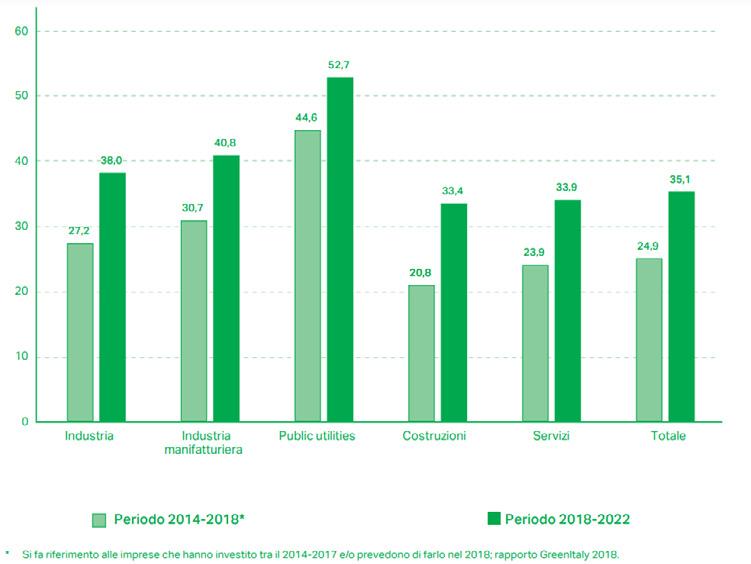
Grafico 2: Imprese che hanno effettuato eco-investimenti in prodotti e tecnologie green sul totale delle imprese, per settore di attività (Fonte: Unioncamere)
regioni è concentrato il 52,2% delle imprese che nel quinquennio esaminato hanno effettuato investimenti green. Relativamente alla tipologia di investimenti green realizzati, le imprese tendono a privilegiare quelli con un impatto sui processi produttivi. La quota di imprese che realizza investimenti in prodotti green - ossia con un migliore profilo ambientale, pensati in un’ottica di economia circolare e di eco-progettazione - è invece rimasta pressoché stabile nel tempo, assestandosi su un esiguo 7%. Cresce al 24%, nel triennio 2023-2025 la percentuale di imprese che prevede di effettuare investimenti che riguardino sia il processo produttivo che il prodotto. Le imprese che investono nella transizione ecologica sono anche più propense ad effettuare investimenti in tecnologie digitali 4.0 rispetto a quelle che non effettuano eco-investimenti. Più nel dettaglio, nel triennio 2023-2025 il 67% delle imprese green prevede di effettuare investimenti in tecnologie digitali, a fronte del 42% delle imprese che non sono green-oriented. La lieve flessione registrata dalle imprese green rispetto al periodo precedente (erano il 70%) non deve tuttavia preoccupare: la complessità del quadro macro-economico attuale ha infatti spinto le imprese ad una maggiore prudenza sui piani di investimento futuri.
Effetti degli investimenti green Risalta la riduzione dei rifiuti o degli scarti di produzione per il 63% delle imprese. Segue un maggiore utilizzo di energie rinnovabili (47%), con percentuali molto elevate nelle grandi imprese (59%) e nel Settentrione d’ Italia (Nord-Ovest 56% e Nord-Est 59%). Il risparmio idrico ha interessato il 39% delle imprese, con punte del 47% per le imprese sopra i 50 addetti e per quelle localizzate nel Nord-Ovest (49%). La riduzione di consumi energetici - intesa come riduzione dell’intensità energetica dei processi produttivi - interessa il 36% delle imprese. Questo effetto ha interessato soprattutto le imprese localizzate nel Nord-Ovest (49%), mentre non si registrano significative differenziazioni in base alla dimensione aziendale. Il riuso dei rifiuti e degli scarti di produzione viene indicato come effetto degli investimenti green dal 27% delle imprese. Segue, con il 23%, l’efficienza energetica degli edifici aziendali, anche qui con percentuali non molto differenziate a seconda della tipologia di impresa. Tutti gli altri effetti degli investimenti in sostenibilità economica non vanno oltre la soglia del 20%; tra questi ricordiamo l’allungamento dei tempi di vita del prodotto (lo dichiara il 21% delle imprese), la riduzione dell’impiego di sostanze chimiche grazie alla conversione al biologico (20%), la riduzione delle emissioni di CO 2 (20%), l’aumento dell’utilizzo di materie prime riciclate e/o rinnovabili (18%) e la riduzione dell’impiego di sostanze chimiche grazie all’adozione di un disciplinare di agricoltura integrata (15%).
Fonte: Fondazione Symbola – Unioncamere, GreenItaly, 2023

67 MARCH 2024
Integrated management of murine populations in Genoa
The goal of the SfRatto Project is to counter the phenomenon of murine presence in the historic centers of large cities through a sustainable control approach, which showed positive results
Giorgio Chiaranz
Naturalist and AIDPI councilor
Genoa, like many Mediterranean port cities, has had to and must live with the problem related to the presence of rats. In particular, more than 50% of the reports of rodent sightings and/or carcasses come from the Historic Center. This area is characterized by a subsoil with sometimes very old sewage systems, into which numerous streams flow. Above ground there is a strong presence of tourists and gastronomic activities (thus food in abundance).
Consistent with the requirements of current regulations, a number of changes to the ordinary pest control protocol have been implemented in recent times, moving increasingly toward an integrated approach (often re-

ferred to as IPM - Integrated Pest Management). The Public Administration and especially the Department of the Environment of the City of Genoa allowed and supported this Pilot Project, called the SfRatto Project, creating a true partnership between the Public and Private sectors. The Project's mapping, management and control methods were carried out according to the scientific method, thus comparing two similar areas (one under treatment and one under "control") in terms of criticality and potential presence of rats. The first official results were presented at the University of Florence, with a presentation entitled: Urban fauna management through habitat modification: preliminary report of a pest man -
agement project on Rattus norvegicus in Genoa (NW Italy). The data obtained, which are still being analyzed, will soon be the subject of a dedicated Scientific Publication.
Permanent baiting vs. Integrated Pest Management
Permanent Baiting is unfortunately still the most common practice among pest controllers today and consists of using, inside special bait dispensers, commercial rodenticide formulations even in those places where there is no evidence of rodent infestation, but where there is even a potential risk of infestation. Thus, this is a misuse of products designed for use in places with established infestations, facil-
68 MARCH 2024
PEST CONTROL
itated by the introduction of paraffin-embedded blocks on the market, which allow for greater preservation of the baits and thus make it easier to go the permanent use route. Although the labels provide for exclusive use by Professionals ("trained professionals") and state the 35-day time limit as a sufficient period for a rodenticide treatment to be effective, it may nevertheless happen that this interval is not sufficient. The new label indications for "trained professionals" do not exclude in advance permanent use, except under certain conditions that must include all those actions that we could summarize in IPM - Integrated Pest management.
Operational steps: techniques and products used
In order to give greater organicity and
effectiveness to the interventions and to create a reliable and reproducible management model in a large part of urban contexts (especially historical ones), a medium-to-long term intervention plan was drawn up, structured on the basis of innovative strategies, new technologies and a new maintenance plan for the Historic Center such that the structural criticalities linked to the presence of rodents could be resolved in a short time. Simultaneously with the implementation of the Pilot Project, the Genoa Urban Sanitation Company in charge of waste management promoted and created a series of waste drop-off sites throughout the historic center called "Ecopoints." Ecopoints are hermetically sealed areas (usually funds or former commercial establishments), accessible only by badge, regularly sanitized and main-
tained, with the primary purpose of removing all categories of waste from the roadway and with the not secondary effect of making the vast majority of potential food sources unavailable to rodents.
The operational steps were:
1. Timely mapping of critical maintenance issues using GIS software.
2. Installation of manhole tilting systems (Mechanical System "Ecologik®") in order to further reduce rodent sightings and make foraging increasingly difficult.
3. Control of Ecopoints by Mini Seismic Wave and Ultrasonic Technology System, so as to drive rodents away from the preferred food source (wet and undifferentiated waste).
4. Progressive replacement of all rodenticide bait dispensers with higher capacity and stronger models.
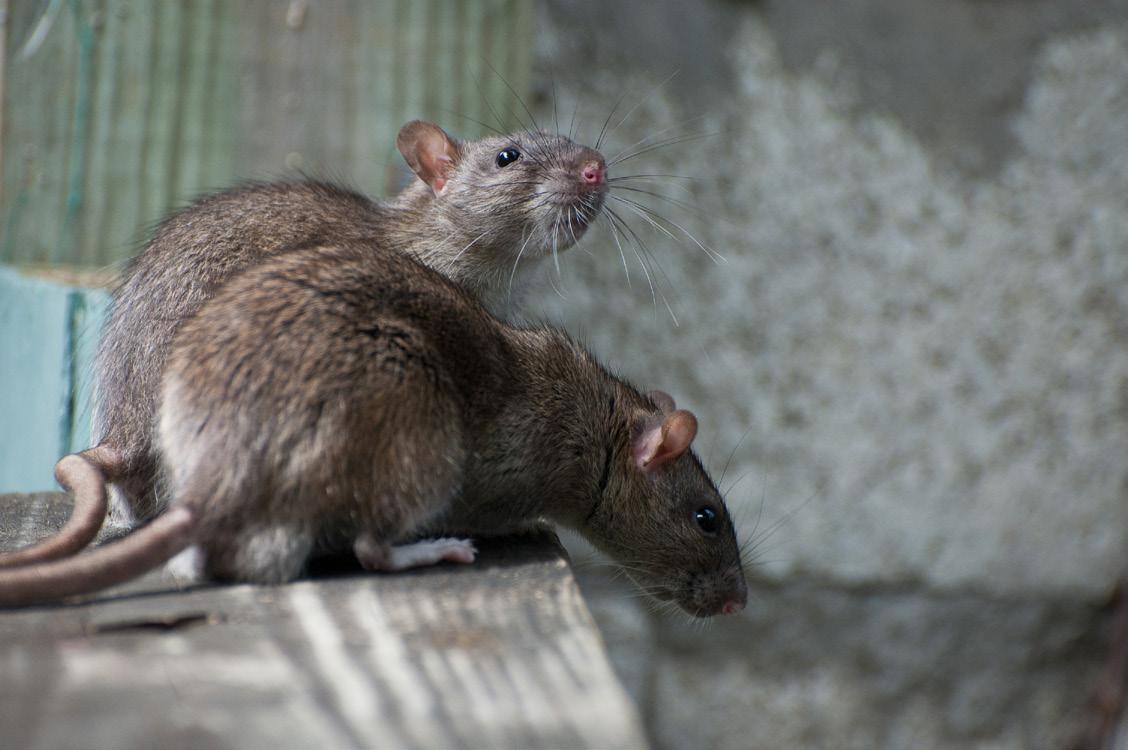

69 MARCH 2024

5. Remediation of critical issues detected, in order to make the habitat inhospitable, through the creation of an operational team for maintenance and physical removal of habitat vacated by removed or eliminated colonies; collaboration with condominium administrations and private individuals; contact with local police for funds or properties that are difficult to determine.
6. Maintaining the standard and monitoring operations.
7. Evaluation of effectiveness by identifying a control area, similar to the experimental area, but not spatially contiguous.
Defining interventions
Following the mapping of critical issues and risk assessments, potential areas of intervention were identified.
A different weight that directly affects

the murine infestation risk assessment, was identified for each criticality surveyed, calculated based on the history of reports received by the Animal Bureau and the scientific bibliography available in the literature. Following the identifi-
cation of critical surfaces, starting from the perimeter areas of the ecopoints, physical interventions were carried out in addition to "classic" deratization interventions, which included burrow closure activities (also repeated over time). Approximately 150 overhead systems for manholes were also installed for the purpose of preventing rats from leaving manholes. The paths between manholes, especially in summer when these are almost all devoid of water, are often used as an alternative route to undisturbed access to different areas of the historic center.
Data collection
As of 01/01/2022, it was possible to begin collecting data useful for evaluating the effectiveness of the SfRatto project by comparing trends in rodenticide bait consumption in both areas (treated and control), both before and after the interventions carried out. The minimum period needed to be able to ensure an initial judgment was estimated at 12 months, as it was necessary to obtain a minimum relative database comparable with those in the
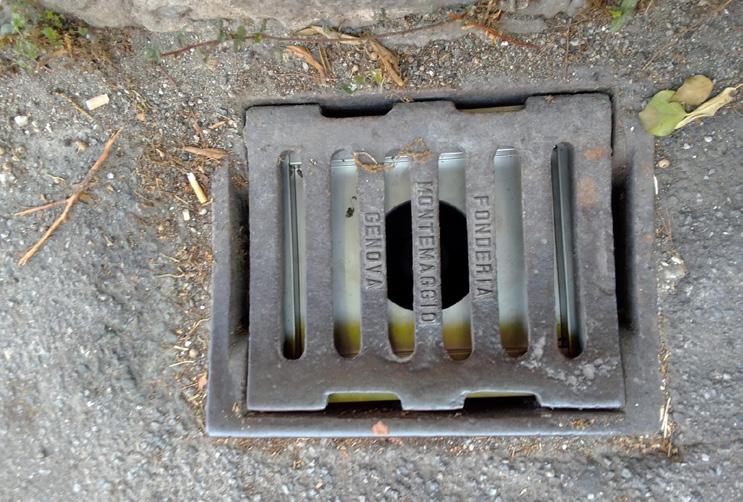
70 MARCH 2024
PEST CONTROL
Map of susceptibility to murine presence
Manhole with Ecologik system
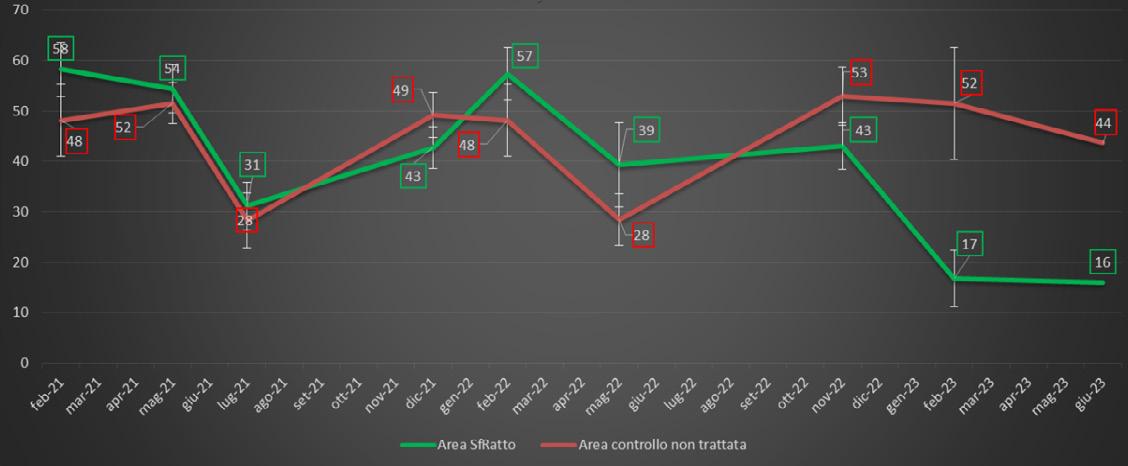
control area.
The success of the project, which can be extended and replicated in all historical centers with similar conformations, is mainly related to the summation of the factors listed above, moving from an "old" logic of using rodenticide baits, by Permanent baiting, to the application of innovative principles of integrated Rat proofing.
After 2 years of monitoring and numerous monitoring interventions carried out, the consumption of rodenticide bait
can be represented in the graph below. It is evident that the average consumption of rodenticide bait, goes from an almost mirror-like trend pre-SfRatto while it is significantly different in the 2 areas tested, with a trend toward a drastic reduction in the experimental area and a stable maintenance in the control area. Ongoing testing in these months seems to confirm the trend.
Findings
In light of what has been described, the following observations can be made:
- no damage attributable to rodents has been detected in the vicinity of the Ecopoints, and there are much fewer signs of the presence of rats (drop -
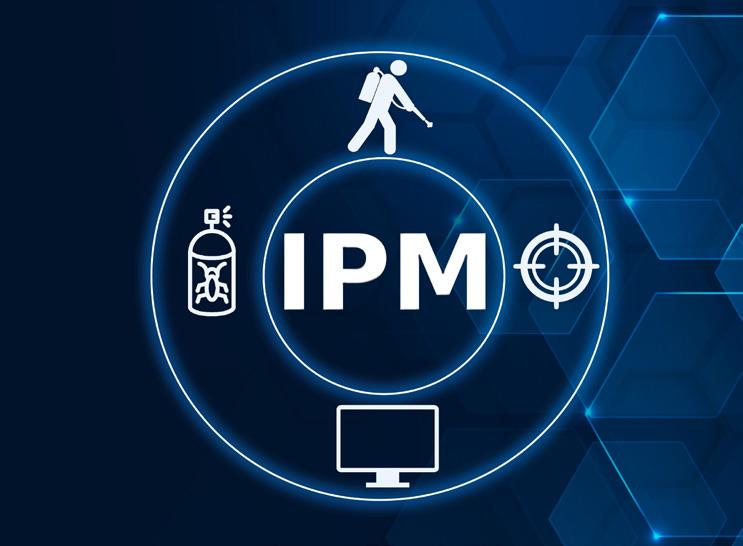
pings, climbing holes, etc...);
- the perception of effectiveness in the citizenry is positive; this observation was also found during the inspections, through direct and indirect citizen contacts (reports and meetings with neighborhood committees organized by the Department);
- reports of sightings and presence in the experimental area have (to date) been nullified;
- the consumption of rodenticide bait in the experimental area tends to zero, with benefits to both the environment and the economy (drastically reduced maintenance costs).
Through the results obtained, it has been planned by the City of Genoa to extend the SfRatto project to other areas of the historic center as well as other Integrated Pest management actions in the rest of the city, including:
- maintenance and strengthening of the small maintenance team;
- rodenticide bait dispensers, box model, monitored at increased frequency (bimonthly) at least for the first year;
- Continuation of contacts and relationships with entities;
- installation of tilting devices in the immediate vicinity of ecopoints, avoiding flood-prone areas.

71 MARCH 2024
Bait consumption (monthly average in grams), Pilot area/untreated area comparison
GESTIONE INTEGRATA DELLE POPOLAZIONI
MURINE A GENOVA
L’obiettivo del Progetto SfRatto consiste nel contrastare il fenomeno della presenza murina nei centri storici delle grandi città tramite un approccio di controllo sostenibile.
I primi, positivi risultati sono stati recentemente presentati
Giorgio Chiaranz
Naturalista e consigliere AIDPI
Genova, come molte città portuali del Mediterraneo, ha dovuto e deve convivere con il problema legato alla presenza dei ratti. In particolar modo, più del 50% delle segnalazioni relative ad avvistamenti e/o carcasse di roditore proviene dal Centro Storico. Tale area è caratterizzata da un sottosuolo con impianti di scarico talvolta molto vecchi, nel quale confluiscono numerosi rivi coperti e dove vi è una forte presenza di turisti e attività gastronomiche (quindi cibo in abbondanza). Per tale motivo, compatibilmente con quanto previsto dalla vigente normativa, nel corso degli ultimi tempi sono state messe in pratica alcune modifiche all’ordinario protocollo di derattizzazione, andando sempre di più verso un approccio integrato (spesso indicato con la denominazione IPM - Integrated Pest Management). La Pubblica Amministrazione ed in particolar modo l’Assessorato all’Ambiente del Comune di Genova hanno permesso e supportato il presente Progetto pilota, denominato Progetto SfRatto, dando vita ad una vera e propria partnership tra Pubblico e Privato. Le modalità di mappatura, gestione e controllo del Progetto sono state effettuate secondo metodo scientifico, quindi confrontando due zone similari (una oggetto di trattamento e una di “controllo”) per criticità e potenziale presenza di ratti. I primi risultati ufficiali sono stati presentati presso l’Università di Firenze, con una presentazione dal titolo: Urban fauna management through habitat modification: preliminary report of a pest management project on Rattus norvegicus in Genoa (NW Italy). I dati ottenuti, tutt’oggi in corso di analisi, saranno prossimamente oggetto di Pubblicazione scientifica dedicata.
Permanent baiting vs. Integrated Pest Management
Il Permanent Baiting è purtroppo ancora oggi la pratica più diffusa tra i disinfestatori e consiste nell’impiegare, all’interno di appositi erogatori di esca, formulati commerciali rodenticidi anche in quei luoghi in cui non vi sia evidenza
di infestazione da roditori, ma nei quali vi sia anche solo un rischio potenziale di infestazione. Si tratta quindi di un uso improprio di prodotti concepiti per l’impiego in luoghi con infestazioni conclamate, favorito dall’introduzione sul mercato dei blocchetti paraffinati che consentono una maggiore preservazione delle esche e rendono in questo modo più semplice la strada dell’uso permanente. Sebbene le etichette prevedano l’uso esclusivo da parte di Professionisti (“trained professional”) e riportino il termine dei 35 giorni di tempo, quale periodo sufficiente affinché un trattamento rodenticida sia efficace, può tuttavia capitare che questo intervallo non sia sufficiente. Le nuove indicazioni delle etichette per “trained professional” non escludono a priori l’uso permanente, se non a determinate condizioni che devono comprendere tutte quelle azioni che potremmo riassumere in IPM – Integrated Pest management, proprie anche della Norma UNI EN 16636:2015 e la Prassi di Riferimento UNI/PdR 86:2020 "Linee guida per l'applicazione della UNI EN 16636”, tra cui: l’impiego di alternative fisiche a quelle chimiche, la valutazione periodica delle condizioni ambientali che
possono favorire la presenza dei roditori, l’impiego di tecniche specifiche per la conformazione urbana e ambientale, il rischio potenziale di infestazio
Step operativi: tecniche e prodotti utilizzati Al fine di dare una maggiore organicità ed efficacia degli interventi e per creare un modello di gestione affidabile e riproducibile in buona parte dei contesti urbani (specialmente storici) è stato elaborato un piano di intervento a medio-lungo termine, strutturato in base a strategie innovative, nuove tecnologie e un nuovo piano di manutenzione del Centro Storico tale da poter risolvere in breve tempo le criticità strutturali legate alla presenza di roditori. Contemporaneamente alla messa in opera del Progetto pilota, l’Azienda di igiene urbana genovese incaricata della gestione dei rifiuti, ha promosso e creato in tutto il Centro Storico una serie di siti per il conferimento di rifiuti, denominati “Ecopunti”. Gli Ecopunti sono
Mappa di suscettibilità alla presenza murina


72 MARCH 2024
GESTIONE RODITORI

Definizione interventi
aree chiuse ermeticamente (di norma fondi o ex esercizi commerciali), accessibili solamente mediante badge, regolarmente igienizzate e manutenute, con il fine primario di rimuovere tutte le categorie di rifiuto dalla sede stradale e con il non secondario effetto di rendere indisponibile ai roditori la grande maggioranza delle potenziali fonti di cibo.
Gli step operativi sono stati:
1. Mappatura puntuale delle criticità manutentive mediante software GIS.
2. Installazione di sistemi basculanti per tombini (Sistema Meccanico “Ecologik®”) al fine di ridurre ulteriormente gli avvistamenti di roditori e rendere la ricerca del cibo sempre più difficoltosa.
3. Controllo degli Ecopunti mediante Sistema tecnologico a mini onde sismiche e ultrasuoni, in modo da allontanare i roditori dalla fonte di cibo privilegiata (rifiuti umidi e indifferenziati).
4. Progressiva sostituzione di tutti gli erogatori di esca rodenticida con modelli a maggior capienza e resistenza.
5. Risanamento delle criticità rilevate, al fine di rendere l’habitat inospitale, attraverso la creazione di una squadra operativa per la manutenzione e per la rimozione fisica dell’habitat lasciato libero dalle colonie allontanate o eliminate; collaborazione con le amministrazioni condominiali e i privati; contatto con la Polizia Locale per fondi o proprietà di difficile determinazione.
6. Mantenimento dello standard e monitoraggio delle operazioni.
7. Valutazione dell’efficacia attraverso l’individuazione di un’area di controllo, in analogia all’area sperimentale, ma non contigua spazialmente.
A seguito della mappatura delle criticità e delle valutazioni del rischio sono state individuate le potenziali aree di intervento. Per ogni criticità censita è stato individuato un “peso”, caratteristica che influisce direttamente sulla valutazione del rischio infestazione murina, calcolato in base allo storico delle segnalazioni ricevute dall’Ufficio Animali e dalla bibliografia scientifica disponibile in letteratura. A seguito dell’individuazione delle superfici critiche, partendo dalle aree a perimetro degli ecopunti, sono state eseguiti oltre a interventi di derattizzazione “classica” anche degli interventi fisici che hanno previsto attività di chiusura tane (anche ripetute nel tempo).
Sono stati installati inoltre circa 150 sistemi basculanti per caditoie allo scopo di non permettere l’uscita dei ratti dai tombini. I percorsi tra un tombino e l’altro, specialmente in estate quando questi sono pressoché tutti privi di acqua, sono spesso utilizzati come via alternativa per raggiungere indisturbati diverse aree del centro storico.
Raccolta dati
A partire dal 01/01/2022 è stato possibile iniziare la raccolta dei dati utili per la valutazione dell’efficacia del progetto SfRatto, mettendo a confronto l’andamento del consumo di esche rodenticide in entrambe le aree (trattata e di controllo), sia prima sia dopo gli interventi effettuati. Il periodo minimo necessario per poter garantire un primo giudizio era stato stimato in 12 mesi, poiché era necessario ottenere una minima base dati relativi confrontabili con quelli dell’area di controllo. Il successo del progetto, estensibile e replicabile in tutti i centri storici con conformazioni similari, è legato principalmente alla sommatoria dei fattori sopra elencati, passando da una logica “vecchia” di utilizzo delle esche rodenticide, mediante Permanent
baiting, all’applicazione di principi innovativi di Rat proofing integrato. Dopo 2 anni di controllo e numerosi interventi di monitoraggio effettuati, il consumo di esca rodenticida può essere rappresentato nel grafico. Risulta evidente come la media dei consumi di esca rodenticida, passi da un andamento quasi speculare pre-SfRatto mentre risulti sensibilmente differente nelle 2 zone oggetto di test, con una tendenza a una drastica riduzione nell’area sperimentale e un mantenimento stabile nell’area di controllo. Le verifiche in corso in questi mesi sembrano confermare il trend.
Conclusioni
Alla luce di quanto descritto si possono fare le seguenti osservazioni: non sono stati rilevati danneggiamenti riconducibili ai roditori nelle vicinanze degli Ecopunti e sono diminuiti i segni di presenza dei ratti; la percezione dell’efficacia nella cittadinanza risulta positiva; le segnalazioni di avvistamento e presenza nell’area sperimentale si sono (ad oggi) annullate; il consumo di esca rodenticida nell’area sperimentale tende a zero, con benefici sia nei confronti dell’ambiente che economici (costi delle manutenzioni drasticamente ridotti).
Attraverso i risultati ottenuti, è stata programmata da parte del Comune di Genova l’estensione del progetto SfRatto anche ad altre zone del Centro Storico nonché altre azioni di Integrated Pest management nel resto della città, tra cui: mantenimento e rafforzamento della squadra per le piccole manutenzioni; erogatori di esca rodenticida, modello a scatola, monitorati a cadenza maggiorata (bimestrale) almeno per la prima annualità; continuazione dei contatti e dei rapporti con Enti; installazione di dispositivi basculanti nelle immediate vicinanze degli ecopunti, evitando le zone a rischio inondazione.

73 MARCH 2024
Consumo di esche (media mensile in grammi)
Confronto Area pilota/Area non trattata
World Employment and Social Outlook: trends of 2024
Despite the economic slowdown, global growth in 2023 was modestly higher than anticipated. Both the unemployment rate and the jobs gap have declined below pre-pandemic values
a cura di Giacomo Torrenzi
Because of geopolitical tensions and broadening inflation, the macroeconomic environment deteriorated significantly over 2023. Large emerging economies such as China, Türkiye and Brazil slowed down considerably, causing adverse impact on global industrial activity, investment and trade. Growth in advanced economies was nearly halved. Given the significant and highly persistent deviation of inflation from targets, central banks are expected to maintain a tight stance on monetary conditions, at least until the end of 2024. Consequently, the post-pandemic economic and social recovery remains incomplete and new vulnerabilities are eroding progress in social justice. Despite the economic slowdown, glob -
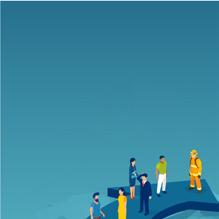




al growth in 2023 was modestly higher than anticipated, and labour markets showed surprising resilience. On the back of strong jobs growth, both the




unemployment rate and the jobs gap have declined below pre-pandemic values. The global unemployment rate in 2023 was 5.1 per cent, a modest im-

74 MARCH 2024
LABOUR MARKET

provement on 2022. The global jobs gap also saw improvements in 2023, but, at close to 435 million, remained elevated. Moreover, in 2023, labour market participation rates had largely recovered from their pandemic lows, especially among lower-middle-income and high-income countries, although with large differences across labour market groups, which have contributed to labour market imbalances, notably in advanced economies. Average hours remain below their 2019 pre-pandemic levels, weighing on the overall available labour input and causing labour market imbalances, especially in key sectors in advanced and some emerging economies. Although the imbalances eased somewhat in 2023, concerns are rising that these labour market imbalances are structural, rather than cyclical, in nature.
Despite lower unemployment and positive employment growth, real wages declined in the majority of G20 countries as wage increases failed to keep pace with inflation.
Global investment rates have recovered significantly since the historic low during the global financial crisis and continued to do so throughout the pandemic. Rising financing costs and a rise in the level of uncertainty have not prevented a return to higher
investment activity, especially among European countries.
After a short growth spurt as countries recovered from the pandemic, aggregate labour productivity growth quickly returned to the low pace observed over the previous decade.
This slowdown happened despite the apparent acceleration of technological progress, especially that of digital technologies. In this regard, the rise in investment in many advanced and some developing countries does not seem to have lifted productivity growth, presumably because of strong investment growth in low-productivity services and construction.
During periods of slow productivity growth, real disposable income and real wages are often vulnerable to sudden price shocks. As only a few firms have seen their profits accelerate, most workers have been unable to ask for stronger increases in their earnings, and so they and their households are facing an accelerating erosion of their real disposable income. Moreover, given the large sectoral heterogeneity of earnings, a further widening of within-country income inequality has ensued. Macro-policy makers might welcome the absence of a wage–price spiral, but, in an environment of already lacklustre growth and where
earnings were lost during the pandemic, such an erosion of real disposable income bodes ill for aggregate demand and a more sustained economic recovery. More importantly, when demand falters, productivity growth suffers as firms fail to generate enough revenue to invest in and adjust to the latest technological developments.
Labour and skills shortages
Concerns about labour and skills shortages have remained high on the agenda of policymakers, at least in advanced economies and some emerging economies. Despite a quick recovery in aggregate labour force participation rates, sectors with essential workers have expressed difficulties in attracting people to take up the rising demand for care, transportation and retail work. There have also been persistent shortages in other sectors such as manufacturing, construction and ICT. Part of the challenge with respect to shortages of essential workers has to do with the poor working conditions in these sectors. Slowing productivity makes it difficult for employers in these sectors to offer higher wages. In addition, restructured demand across sectors and supportive fiscal policy have created a significant overhang in vacancies, in specific sectors, that are difficult to fill. Such sectoral mismatch has been often compounded by low geographical mobility because workers have suffered from a lack of affordable housing. Although these shortages seem to have eased with tighter macroeconomic policies, labour market imbalances have persisted.
The recovery in labour force participation rates to pre-pandemic levels has been uneven and has not benefited all labour market groups the same way. Female participation rates have recovered faster than expected but the gender participation gap remains large, especially in emerging and developing countries. Most concerning is the situation for young people. Although youth

75 MARCH 2024
labour force participation has recovered above trend, a disproportionately large proportion of youth who dropped out of the labour market are not pursuing any form of training and continue to face significant obstacles to returning to work. The rate of those not in training, education or employment (NEET) remains high across income levels and particularly among young women, causing significant challenges for individuals’ long-term labour market attachment.
Although people have returned to the labour market, they tend not to be working the same numbers of hours as before the pandemic. Across countries of all income levels, average hours worked have expanded less than total
hours worked; there are acute labour shortages in some – contact-intensive – sectors. These are partly related to ongoing longer-term health-related problems that have built up over the past three years. The numbers of sick days have increased significantly from pre-pandemic levels, indicating ongoing COVID-19-related effects on people’s health.
As the economy continues to slow down, part of these labour shortages will be absorbed by firms issuing fewer vacancies. Nevertheless, as productivity growth remains weak, labour shortages are likely to persist. In countries where the population is ageing, employers will face increasing difficulties in filling their vacancies despite the slowing growth. Older workers tend to switch jobs less frequently; hence an older population means there will be fewer of the job hoppers who constitute many of the candidates for open
vacancies. Improvements in working conditions and rising productivity could help address some of these labour market imbalances, as could more equitable distribution of job opportunities across countries that have severe excess labour.
Technological progress is testing labour market resilience
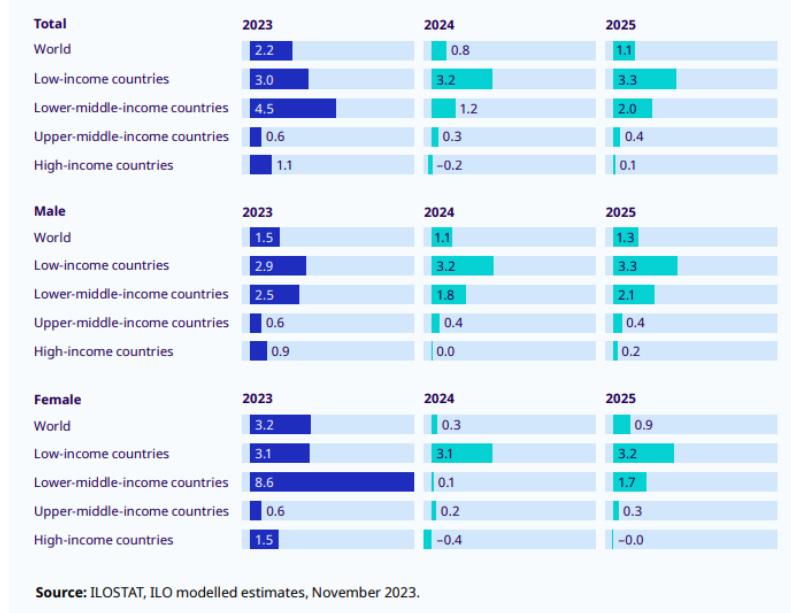
Labour market adjustment will be further tested by accelerating technological progress. The year 2023 saw the arrival of yet another wave of digital innovations involving generative artificial intelligence (AI). Despite this apparent technological progress, living standards and productivity growth have not improved, a further indication of slow labour market adjustment. Lack of skills and the entry barriers for newcomers created by large digital monopolies have been significant obstacles to faster technological adoption, in particular in low-productive sectors and developing countries. Geographical inequalities are likely to worsen because a small number of conglomerates continue to attract most of the investment in the digital sector. Many countries, including developing ones, have adopted policies to encourage the adoption of AI. However, in the current climate of geopolitical tensions, technological transfer seems to be facing intensifying barriers, which will hamper leapfrogging strategies in developing countries to harness the benefits of these digital technol-

76 MARCH 2024
LABOUR MARKET
Tab. 1: employment growth, 2023–25, by sex and country income groups (percentages)
ogies. Broad-based skills initiatives require significant domestic fiscal resources, but these have been eroded by the pandemic, including in advanced economies. Countries longing for a faster digital transformation that will benefit society at large will need new policy approaches, including a more proactive approach to technological development, for instance through mission-oriented innovation policy and the mobilization of resources through sovereign wealth funds.
Outlook remains cloudy
In the near future, the labour market outlook is set to deteriorate, albeit only moderately. Global unemployment rates will notch up slightly over the forecast horizon, primarily because of increased joblessness in advanced economies. Unemployment is expected to rise modestly in 2024: as labour force participation rates decline and employment growth slows, global unemployment will rise by 2 million, pushing the global unemployment rate from 5.1 per cent in 2023 to 5.2 per cent in 2024. The global jobs gap, though improving, remained elevated in 2023, at close to 435 million. The erosion of real wages and living standards by high and persistent inflation rates and rising costs of housing is unlikely to be compensated quickly. Youth unemployment continues to present a challenge to faster structural and labour market adjustment, especially in countries with high NEET rates. The gap here opened by the pandemic needs to be closed quickly through targeted skills initiatives to prevent further erosion of job resilience. Informality rates are not expected to improve any further; around 58 per cent of the global employment will remain informally employed in 2024. Similarly, working poverty is likely to persist. Major challenges need to be addressed swiftly to accelerate movement towards achieving the UN sustainabil-
ity goals. The current environment of geopolitical tensions bodes ill for rapid and effective international coordination to address major economic, ecological and social challenges. Governments need to strengthen their domestic economy through initiatives to raise productivity growth and living standards.
Labour market trends in Europe
The settling of headline indicators suggests that the labour market in Europe has stabilized. Employment is continuing to expand in line with growth in the working-age population (corresponding to a stable employment-to-population ratio of around 55 per cent). The unemployment rate decreased to 5.7 per cent in 2023, from a recent high of 7 per cent in 2020. The labour force participation rate is also at around the same level as in pre-pandemic and long-term trends, around 58.5 per cent (compared with 58.3 per cent on average between 2010 and 2019). These trends are consistent with findings from other monitors, particularly of the European labour market, such as the European Labour Market Barometer. Heterogeneity prevails in the region; the different trends in Eastern Europe reflect the regional impact of the Russian invasion of Ukraine. Employment is growing in all subregions except Eastern Europe, whose total employment has followed a downward trend since 2022. This trend is expected to continue well into 2025. There have been a range of labour market disruptions in Ukraine, resulting from economic disruption, business closures, population exodus and internal displacement, which have all contributed to decreases in total employment, job quality and job creation and an increase in informality.
Youth unemployment in Europe
Roughly half of European countries witnessed declines in youth unemployment in the 12 months up to June
2023. Throughout 2023, the labour market situation of youth in Europe steadily improved. In June 2023, the youth unemployment rate in the European Union stood at just over 14 per cent, a fall of 0.3 percentage points from the same time the year before. Improvements between June 2022 and June 2023 were mixed: approximately half of the Member States saw declines whereas the others saw increases (Eurostat 2023a). Part of the reduction also owed to labour shortages observed in a number of countries from 2020 to 2023, which resulted in increased employment among young people (ILO 2023f). The different economic cycles and recoveries observed among countries in the European Union corresponded to different changes in the labour market.
Among the changes that took place in the European Union, some of the largest declines in the youth unemployment rate over the past few years have been in Southern Europe.
Between June 2022 and June 2023, youth unemployment fell most markedly in Greece, where the rate of unemployed youth declined by more than 8 percentage points. There were strong reductions in other Southern European countries too: in Cyprus by 2.1 percentage points, in Italy by 1.2 percentage points, in Portugal by 0.8 percentage points and in Spain by 1.8 percentage points. Despite these gains, youth unemployment remains elevated in many of these countries, at rates of more than 20 per cent in Italy, Greece and Spain. In European Union countries, part of the improvement in youth unemployment has owed to the reinforced European Youth Guarantee, which acted as an automatic stabilizer supporting youth employment during the COVID-19 pandemic (Rinne et al. 2022).
Source: World Employment and Social Outlook: Trends 2024. Geneva: International Labour Office, 2024. © ILO.

77 MARCH 2024
PROSPETTIVE OCCUPAZIONALI 2024 NEL MONDO
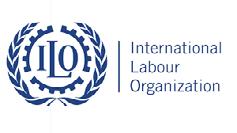
Nonostante il rallentamento dell'economia, la crescita globale nel 2023 è stata leggermente superiore alle previsioni. Sia il tasso di disoccupazione che il divario occupazionale sono scesi al di sotto dei valori pre-pandemia
a cura di Giacomo Torrenzi
Acausa delle tensioni geopolitiche e dell'aumento dell'inflazione, il contesto macroeconomico si è notevolmente deteriorato nel corso del 2023. Le grandi economie emergenti, come Cina, Turchia e Brasile, hanno subito un notevole rallentamento, con un impatto negativo sull'attività industriale, sugli investimenti e sul commercio a livello globale. La crescita delle economie avanzate si è quasi dimezzata. Data la deviazione significativa e molto persistente dell'inflazione dagli obiettivi, si prevede che le banche centrali mantengano un atteggiamento rigido sulle condizioni monetarie, almeno fino alla fine del 2024. Di conseguenza, la ripresa economica e sociale post-pandemia rimane incompleta e nuove vulnerabilità stanno erodendo i progressi nella giustizia sociale.
Nonostante il rallentamento dell'economia, nel 2023 la crescita globale è stata leggermente superiore alle previsioni e i mercati del lavoro hanno mostrato una sorprendente capacità di recupero. Grazie alla forte crescita dei posti di lavoro, sia il tasso di disoccupazione che il divario occupazionale sono scesi al di sotto dei valori pre-pandemia. Il tasso di disoccupazione globale nel 2023 è stato del 5,1%, con un modesto miglioramento rispetto al 2022. Anche il divario occupazionale globale è migliorato nel 2023, ma, con quasi 435 milioni di persone, è rimasto elevato. Inoltre, nel 2023, i tassi di partecipazione al mercato del lavoro si sono ampiamente ripresi dai minimi pandemici, soprattutto tra i Paesi a reddito medio-basso e alto, anche se con grandi differenze tra i gruppi del mercato del lavoro, che hanno contribuito agli squilibri del mercato del lavoro, in particolare nelle economie avanzate. Le ore medie rimangono al di sotto dei livelli pre-pandemia del 2019, pesando sull'input di lavoro complessivamente disponibile e causando squilibri del mercato del lavoro, soprattutto nei settori chiave delle economie avanzate e di alcune economie emergenti. Sebbene gli squilibri si siano leggermente attenuati nel 2023, aumentano i timori che questi squilibri del mercato del la-

voro siano di natura strutturale, piuttosto che ciclica.
Nonostante il calo della disoccupazione e la crescita positiva dell'occupazione, i salari reali sono diminuiti nella maggior parte dei Paesi del G20, poiché gli aumenti salariali non sono riusciti a tenere il passo dell'inflazione. I tassi di investimento globali hanno recuperato in modo significativo dal minimo storico raggiunto durante la crisi finanziaria globale e hanno continuato a farlo durante la pandemia. L'aumento dei costi di finanziamento e l'incremento del livello di incertezza non hanno impedito il ritorno a una maggiore attività di investimento, soprattutto nei Paesi europei. Dopo un breve periodo di crescita, quando i Paesi si sono ripresi dalla pandemia, la crescita della produttività aggregata del lavoro è tornata rapidamente al basso ritmo osservato nel decennio precedente. Questo rallentamento è avvenuto nonostante l'apparente accelerazione del progresso tecnologico, soprattutto quello delle tecnologie digitali. A questo proposito, l'aumento degli investimenti in molti Paesi avanzati e in alcuni Paesi in via di sviluppo non sembra aver sostenuto la crescita della pro -
duttività, presumibilmente a causa della forte crescita degli investimenti nei servizi a bassa produttività e nelle costruzioni. Durante i periodi di lenta crescita della produttività, il reddito disponibile reale e i salari reali sono spesso vulnerabili agli shock improvvisi dei prezzi. Poiché solo poche imprese hanno visto accelerare i propri profitti, la maggior parte dei lavoratori non è stata in grado di chiedere aumenti più consistenti dei propri guadagni, per cui essi e le loro famiglie si trovano ad affrontare un'erosione sempre più rapida del proprio reddito reale disponibile. Inoltre, data la grande eterogeneità settoriale delle retribuzioni, si è assistito a un ulteriore ampliamento della disuguaglianza di reddito all'interno del Paese. I responsabili delle politiche macroeconomiche potrebbero accogliere con favore l'assenza di una spirale salari-prezzi, ma, in un contesto di crescita già scarsa e in cui i guadagni sono andati persi durante la pandemia, una tale erosione del reddito reale disponibile non è di buon auspicio per la domanda aggregata e per una ripresa economica più sostenuta. Inoltre, quando la domanda vacilla, la crescita della produttività ne risente, poiché le imprese non
78 MARCH 2024
LAVORO
riescono a generare entrate sufficienti per investire e adeguarsi agli ultimi sviluppi tecnologici.
Carenza di manodopera e di competenze
Le preoccupazioni per la carenza di manodopera e di competenze sono rimaste in cima all'agenda dei responsabili politici, almeno nelle economie avanzate e in alcune economie emergenti. Nonostante la rapida ripresa dei tassi aggregati di partecipazione alla forza lavoro, i settori in cui sono presenti lavoratori essenziali hanno espresso difficoltà ad attrarre persone per soddisfare la crescente domanda di assistenza, trasporti e lavoro al dettaglio. Si sono registrate carenze persistenti anche in altri settori, come quello manifatturiero e delle costruzioni. Parte della sfida relativa alla carenza di lavoratori ha a che fare con il rallentamento della produttività che rende difficile per i datori di lavoro di questi settori offrire salari più alti. Inoltre, la ristrutturazione della domanda tra i vari settori e la politica fiscale di sostegno hanno creato un significativo eccesso di posti di lavoro vacanti, in settori specifici, difficili da coprire. Questo disallineamento settoriale è stato spesso aggravato da una scarsa mobilità geografica, perché i lavoratori hanno sofferto della mancanza di alloggi a prezzi accessibili. Sebbene queste carenze sembrino essersi attenuate con politiche macroeconomiche più severe, gli squilibri del mercato del lavoro sono persistiti.
La ripresa dei tassi di partecipazione alla forza lavoro ai livelli pre-pandemia è stata disomogenea e non ha beneficiato allo stesso modo tutti i gruppi del mercato del lavoro. I tassi di partecipazione femminile si sono ripresi più velocemente del previsto, ma il divario di partecipazione tra i sessi rimane ampio, soprattutto nei Paesi emergenti e in via di sviluppo. La situazione più preoccupante è quella dei giovani. Sebbene la partecipazione dei giovani alla forza lavoro abbia registrato una ripresa superiore al trend, una percentuale sproporzionatamente elevata di giovani che hanno abbandonato il mercato del lavoro non sta seguendo alcuna forma di formazione e continua ad affrontare ostacoli significativi al ritorno al lavoro. Il tasso di coloro che non frequentano corsi di formazione, non studiano e non lavorano (NEET) rimane elevato a tutti i livelli di reddito e in particolare tra le giovani donne, causando sfide significative per il coinvolgimento a lungo termine degli individui nel mercato del lavoro. Sebbene le persone siano tornate sul mercato del lavoro, tendono a non lavorare lo stesso numero di ore di prima della pandemia. In tutti i Paesi di tutti i livelli di reddito, le ore medie lavorate sono aumentate meno delle ore totali lavorate; in alcuni settori - ad alta intensità di contatto - si registra una forte carenza di manodopera. Queste carenze sono in parte legate ai problemi di salute a lungo termine che si sono accumulati negli ultimi tre anni. Il nume -
ro di giorni di malattia è aumentato in modo significativo rispetto ai livelli pre-pandemici, indicando gli effetti che il COVID-19 sta avendo sulla salute delle persone. Con il continuo rallentamento dell'economia, parte di queste carenze di manodopera sarà assorbita dalle aziende che offrono meno posti di lavoro. Tuttavia, poiché la crescita della produttività rimane debole, è probabile che la carenza di manodopera persista. Nei Paesi in cui la popolazione invecchia, i datori di lavoro avranno sempre più difficoltà a coprire i posti vacanti nonostante il rallentamento della crescita. I lavoratori più anziani tendono a cambiare lavoro meno frequentemente; di conseguenza, una popolazione più anziana significa che ci saranno meno persone che cambiano lavoro e che costituiscono molti dei candidati per i posti vacanti. Il miglioramento delle condizioni di lavoro e l'aumento della produttività potrebbero contribuire a risolvere alcuni di questi squilibri del mercato del lavoro, così come una distribuzione più equa delle opportunità di lavoro nei Paesi che presentano un forte eccesso di manodopera.
Progresso tecnologico e mercato del lavoro
L'adeguamento del mercato del lavoro sarà ulteriormente messo alla prova dall'accelerazione del progresso tecnologico. Il 2023 ha visto l'arrivo di un'altra ondata di innovazioni digitali che coinvolgono l'intelligenza artificiale generativa (IA). Nonostante l'apparente progresso tecnologico, il tenore di vita e la crescita della produttività non sono migliorati, un'ulteriore indicazione della lentezza dell'adeguamento del mercato del lavoro. La mancanza di competenze e le barriere all'ingresso per i nuovi arrivati create dai grandi monopoli digitali sono stati ostacoli significativi a una più rapida adozione delle tecnologie, in particolare nei settori a bassa produttività e nei Paesi in via di sviluppo. Le disuguaglianze geografiche sono destinate a peggiorare perché un piccolo numero di conglomerati continua ad attrarre la maggior parte degli investimenti nel settore digitale. Molti Paesi, compresi quelli in via di sviluppo, hanno adottato politiche per incoraggiare l'adozione dell'IA. Tuttavia, nell'attuale clima di tensioni geopolitiche, il trasferimento tecnologico sembra incontrare sempre più ostacoli, che impediranno alle strategie di salto di qualità dei Paesi in via di sviluppo di sfruttare i benefici di queste tecnologie digitali. Iniziative di qualificazione ad ampio raggio richiedono significative risorse fiscali nazionali, che però sono state erose dalla pandemia, anche nelle economie avanzate. I Paesi che desiderano una trasformazione digitale più rapida e vantaggiosa per la società in generale avranno bisogno di nuovi approcci politici, tra cui un approccio più proattivo allo sviluppo tecnologico, ad esempio attraverso una politica dell'innovazione orientata alla missione e la mobilitazione di risorse attraverso i fondi sovrani.
Le prospettive rimangono fosche Nel prossimo futuro, le prospettive del mercato del lavoro sono destinate a peggiorare, anche se solo moderatamente. I tassi di disoccupazione globali aumenteranno leggermente nell'orizzonte di previsione, soprattutto a causa dell'aumento della disoccupazione nelle economie avanzate. Si prevede un modesto aumento della disoccupazione nel 2024: con il calo del tasso di partecipazione alla forza lavoro e il rallentamento della crescita dell'occupazione, la disoccupazione globale aumenterà di 2 milioni di unità, portando il tasso di disoccupazione globale dal 5,1% nel 2023 al 5,2% nel 2024. È improbabile che l'erosione dei salari reali e del tenore di vita causata da tassi di inflazione elevati e persistenti e dall'aumento dei costi degli alloggi possa essere compensata rapidamente. La disoccupazione giovanile continua a rappresentare una sfida per un più rapido adeguamento strutturale e del mercato del lavoro, soprattutto nei Paesi con alti tassi di NEET. Il divario aperto dalla pandemia deve essere colmato rapidamente attraverso iniziative di qualificazione mirate, per evitare un'ulteriore erosione della capacità di ripresa del lavoro. I tassi di lavoro informale non dovrebbero migliorare ulteriormente: nel 2024 circa il 58% dell'occupazione globale rimarrà informale. Allo stesso modo, è probabile che la povertà lavorativa persista. Le principali sfide devono essere affrontate rapidamente per accelerare i progressi verso il raggiungimento degli obiettivi di sostenibilità delle Nazioni Unite. L'attuale contesto di tensioni geopolitiche non favorisce un coordinamento internazionale rapido ed efficace per affrontare le principali sfide economiche, ecologiche e sociali. I governi devono rafforzare l'economia nazionale attraverso iniziative volte ad aumentare la produttività e il tenore di vita.
Tendenze del mercato del lavoro in Europa
L'assestamento degli indicatori principali suggerisce che il mercato del lavoro in Europa si è stabilizzato. L'occupazione continua a espandersi in linea con la crescita della popolazione in età lavorativa (corrispondente a un rapporto stabile tra occupazione e popolazione di circa il 55%). Il tasso di disoccupazione è sceso al 5,7% nel 2023, da un recente massimo del 7% nel 2020. Anche il tasso di partecipazione alla forza lavoro si attesta all'incirca allo stesso livello dei trend pre-pandemici e di lungo periodo, intorno al 58,5% (rispetto al 58,3% in media tra il 2010 e il 2019). Queste tendenze sono coerenti con i risultati di altri monitoraggi, come lo European Labour Market Barometer. In Europa prevale l'eterogeneità; le diverse tendenze nell'Europa orientale riflettono l'impatto dell'invasione russa dell'Ucraina. L'occupazione è in crescita in tutte le sottoregioni ad eccezione dell'Europa orientale, la cui occupazione totale ha seguito una tendenza al ribasso dal 2022. Si prevede che questa tendenza

79 MARCH 2024
continui anche nel 2025. In Ucraina si sono verificate una serie di perturbazioni del mercato del lavoro, dovute a disfunzioni economiche, chiusura di aziende, esodo della popolazione e sfollamento interno, che hanno contribuito alla diminuzione dell'occupazione totale, della qualità e della creazione di posti di lavoro e all'aumento del lavoro informale.
La disoccupazione giovanile in Europa
Circa la metà dei Paesi europei ha registrato un calo della disoccupazione giovanile nei 12 mesi fino a giugno 2023. Per tutto il 2023, la situazione del mercato del lavoro giovanile in Europa è
Tab. 1: crescita dell'occupazione, 2023-25, per sesso e gruppi di reddito nazionali (percentuali)
migliorata costantemente. A giugno 2023, il tasso di disoccupazione giovanile nell'Unione Europea era di poco superiore al 14%, con un calo di 0,3 punti percentuali rispetto allo stesso periodo dell'anno precedente. I miglioramenti tra giugno 2022 e giugno 2023 sono stati eterogenei: circa la metà degli Stati membri ha registrato un calo, mentre gli altri hanno registrato un aumento (Eurostat 2023a). Parte della riduzione è dovuta anche alla carenza di manodopera osservata in diversi Paesi tra il 2020 e il 2023, che ha portato a un aumento dell'occupazione giovanile (ILO 2023). I diversi cicli e recuperi economici osservati tra i Paesi dell'Unione Europea hanno corrisposto a diversi cambiamenti nel mercato del lavoro.
Tra i cambiamenti avvenuti nell'Unione Europea, alcuni dei maggiori cali del tasso di disoccupazione giovanile negli ultimi anni si sono verificati nell'Europa meridionale.
Tra giugno 2022 e giugno 2023, la disoccupa-
zione giovanile è diminuita in modo più marcato in Grecia, dove il tasso di giovani disoccupati è diminuito di oltre 8 punti percentuali. Anche in altri Paesi dell'Europa meridionale si sono registrate forti riduzioni: a Cipro di 2,1 punti percentuali, in Italia di 1,2 punti percentuali, in Portogallo di 0,8 punti percentuali e in Spagna di 1,8 punti percentuali. Nonostante questi guadagni, la disoccupazione giovanile rimane elevata in molti di questi Paesi, con tassi superiori al 20% in Italia, Grecia e Spagna. Nei Paesi dell'Unione Europea, parte del miglioramento della disoccupazione giovanile è dovuto al rafforzamento della Garanzia Giovani Europea, che ha agito come stabilizzatore automatico a sostegno dell'occupazione giovanile durante la pandemia COVID-19 (Rinne et al. 2022).
Fonte: World Employment and Social Outlook: Trends 2024. Geneva: International Labour Office, 2024. © ILO.
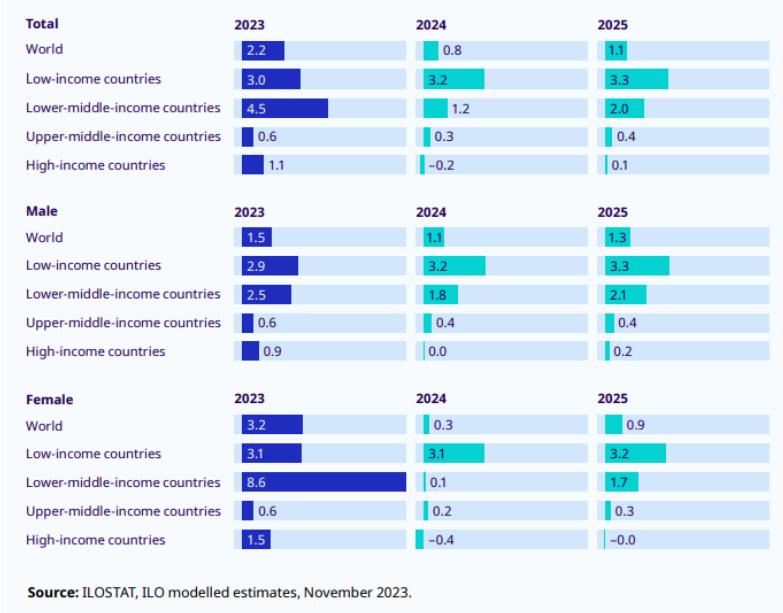

80 MARCH 2024
LAVORO
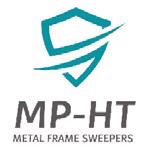
Transition towards electric excellence
The electrification process is becoming increasingly widespread among those who design and produce professional cleaning machines. The preference to use full electric solutions is a common interest across public and private sectors among industries of logistics, retail. MP-HT, an Italian company specialized in the design and production of sweepers for industrial and urban sectors, is constantly working on ambitious projects for the renewal of industrial sweepers. The objective is clearly stated: replacing technologies that use fossil fuels, combustion engines
to electric powered motor.
But not only that: MP-HT is working to replace hydraulic systems with electrical ones to ensure higher energy efficiency, better control and management of the machines and reduce maintenance costs.
A transition towards more sustainable production and consumption, that minimizes the CO2 and noise emissions improving the well-being and safety in the workplace. The new MP-HT projects that combine electrification and digitalization systems applied in the new generation sweepers, offer higher work performance, cutting
costs, improving efficiency and performance, and reducing emissions.
It is to present these new technologies and collect cu-
stomer feedback that MP-HT will participate in the INTERCLEAN fair, in Amsterdam from 14th to 17th May, in pavilion 7 stand 425.

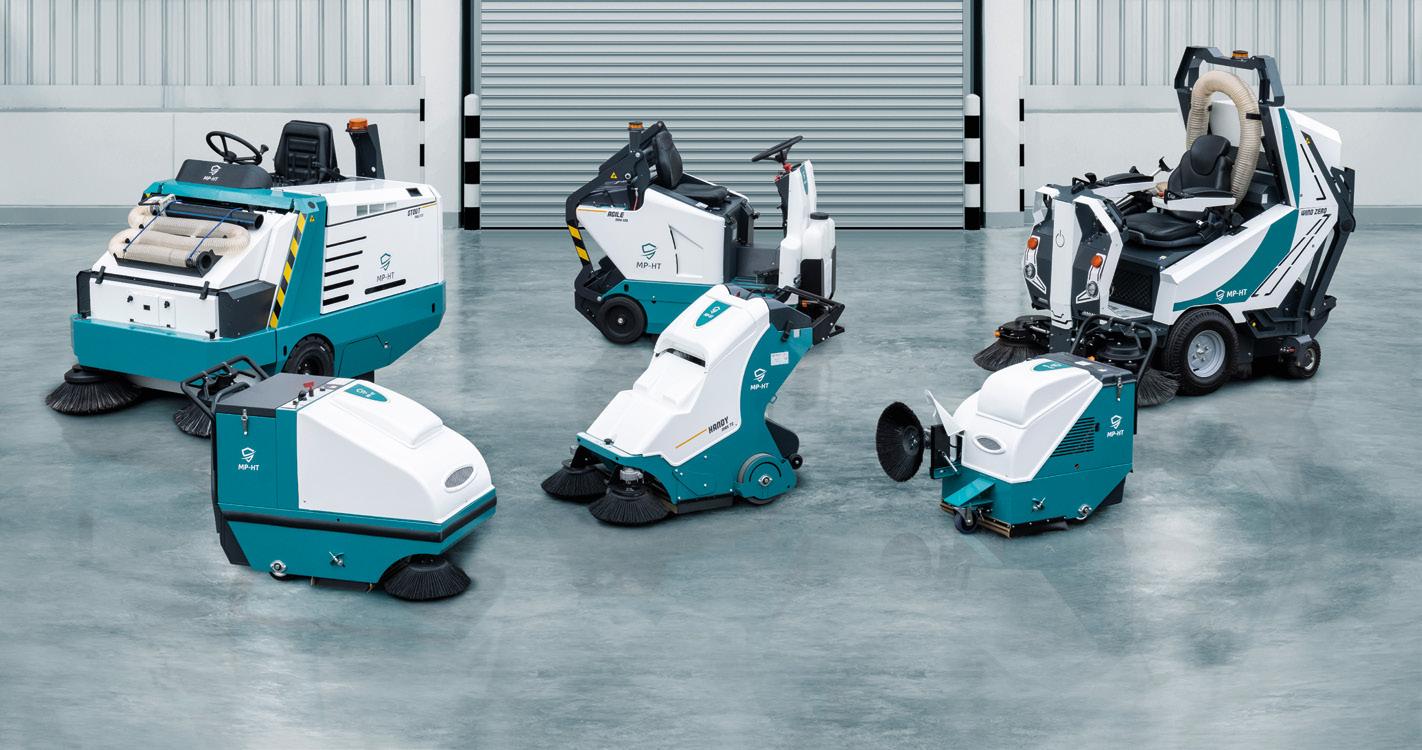


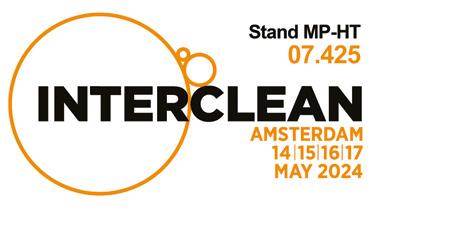
mp-ht.it sponsored content
RELIABLE SWEEPERS, MADE TO LAST. www.mp-ht.it MP-HT S.r.l. | Via Tamburin, 19 35010 Limena (Padua) - Italy | +39 049 796 8360
4cleanpro.com
4Clean Pro always present at the customer's side
4Clean Pro has been present in the world of professional industrial cleaning for almost 15 years. Inside, a group of people with twenty years of experience constantly follows the development of cleaning techniques in the world of hygiene and is constantly dedicated to the search for technologi-
cal innovations aimed at responding to an increasingly demanding and constantly evolving market.
4Clean Pro products are appreciated above all for the quality of the construction and the components used. Stainless steel is the material that is mainly used to make
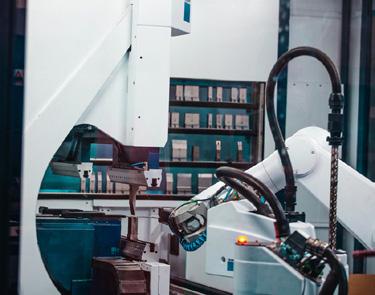
the frames. Production thus acquires added value and is able to achieve full efficiency even in the most difficult environments such as the industrial, food, hospital and many other sectors. The machine models are of various sizes and different te-
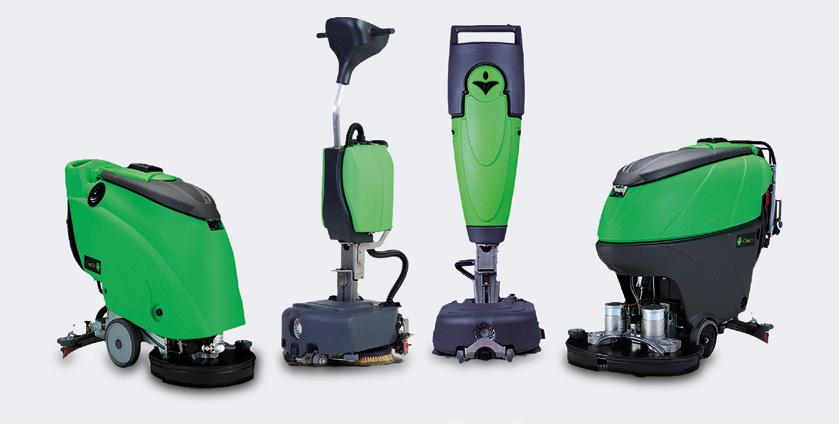
chnical characteristics and easily adapt to every type of need and environment. The internal structure of the company guarantees professionalism and direct contact with the customer for both technical and commercial questions and is thus able to provide answers quickly if necessary. Furthermore, 4Clean Pro has maintenance services and original spare parts that can also be purchased through the online shop on the site. It is the company's concern to maintain a collaborative relationship over time beyond the initial purchase phase and to remain a point of reference always present at the customer's side.
4Clean Pro sempre presente al fianco del cliente
4Clean Pro è presente ormai da quasi 15 anni nel mondo della pulizia industriale professionale. Al suo interno un gruppo di persone con esperienza ventennale segue costantemente lo sviluppo delle tecniche di pulizia nel mondo dell’igiene e si dedica costantemente alla ricerca di innovazioni tecnologiche mirate a rispondere ad un mercato sempre più esigente ed in continua evoluzione. I prodotti di 4Clean Pro sono apprezzati soprattutto per la qualità della costruzione e dei componenti utilizzati. L’acciaio inox è
il materiale che viene principalmente impiegato per la realizzazione dei telai. La produzione acquista così un valore aggiunto ed è in grado di raggiungere una piena efficienza anche negli ambienti più difficili come il settore industriale, alimentare, ospedaliero e molti altri ancora.
I modelli di macchine sono di varie dimensioni e differenti caratteristiche tecniche e si adattano facilmente ad ogni tipo di necessità e ambiente. La struttura interna dell’azienda garantisce professionalità e contatto
diretto con il cliente sia per questioni tecniche che commerciali ed è in grado così di fornire risposte in tempi brevi in caso di necessità. 4Clean Pro inoltre dispone di servizi di manutenzione e ricambi originali acquistabili anche attraverso lo shop online presente sul sito.
È premura dell’azienda mantenere un rapporto di collaborazione nel tempo oltre la fase iniziale dell’acquisto e rimanere un punto di riferimento sempre presente al fianco del cliente.
sponsored content

Bettari - Concentrated detergents:
“Twist” line. Less water, less plastic... more savings!

Attention and sensitivity towards environmental issues are increasing worldwide: just think about the goals of the 2030 Agenda for Sustainable Development, the action program signed by the 193 member countries of the UN. This evolution is inevitably influencing the professional cleaning market where there is growing interest and demand for more environmentally friendly cleaning
Bettari – Detergenti concentrati: linea “Twist”. Meno acqua, meno plastica…maggior risparmio! bettari.it
solutions.
Concentrated detergents are an intelligent solution to this more and more frequent demand: they meet the requirements of environmental sustainability and at the same time are advantageous from an economic and practical point of view. In this regard, Bettari Detergenti offers TWIST concentrated detergents to meet various needs: different fragrances for cleaning
and sanitizing floors, windows and glasses, bathrooms and surfaces in general. How? Through a higher concentration of active ingredients compared to standard products, becoming the preferred solution for many operators, even more in international markets where transportation costs are significant. Why are we talking about economic savings?
The decreasing weight and
volume of concentrated products leads to lower transport costs and storage/picking costs, as well as a reduction in packaging disposal costs.
Why is the environmental impact reduced?
The presence of a low percentage of water in concentrated detergents allows us to save water resources, reduce packaging (bottles, canisters, etc.) and decrease CO2 emissions associated with transports.

In tutto il mondo l’attenzione e la sensibilità verso le tematiche ambientali stanno aumentando: basti pensare agli obiettivi dell’Agenda 2030 per lo Sviluppo Sostenibile, ovvero il programma d’azione sottoscritto dai 193 Paesi membri dell’ONU. Questa evoluzione sta inevitabilmente influenzando anche il mercato del cleaning professionale, dove sta crescendo l’interesse e la richiesta di soluzioni di pulizia più rispettose dell’ambiente.
Una risposta intelligente a questa sempre più frequente richiesta sono i detergenti concentrati: essi soddisfano i requisiti di
sostenibilità ambientale e allo stesso tempo sono vantaggiosi da un punto di vista economico e pratico.
A tal proposito Bettari Detergenti offre la linea di detergenti concentrati “TWIST” per rispondere a diverse necessità: diverse fragranze per la pulizia e l’igienizzazione di pavimenti, vetri, bagno, superfici. Come? Attraverso la maggiore concentrazione di principio attivo rispetto ai prodotti standard, diventando la soluzione preferita di numerosi operatori, ancor di più nei mercati internazionali dove l’incidenza dei costi di trasporto è molto rilevante.
Perché si parla di risparmio economico?
La diminuzione del peso e del volume dei prodotti concentrati si traduce in minori costi di trasporto e di stoccaggio/picking, oltre che in una riduzione dei costi di smaltimento degli imballaggi.
Perché l’impatto ambientale è ridotto?
La riduzione della percentuale di acqua presente nei detergenti concentrati consente di risparmiare risorse idriche, ridurre gli imballaggi (flaconi taniche, estensibili, etc.) e diminuire le emissioni di CO2 correlate ai trasporti!
sponsored content

Falpi achieves a new milestone: the ECOVADIS Silver Top Certification for Corporate Sustainability
In February, Falpi obtained the ECOVADIS Silver Top certification: a prestigious recognition certifying the ongoing commitment to pursuing a virtuous path of corporate sustainability.
ECOVADIS, one of the most important international platforms for rating corporate sustainability, evaluated Falpi based on 21 aspects grounded in international CSR (Corporate Social Responsibility) standards, grouped into 4 key parameters: environment, labor and human rights protection, fair business practices, and sustainable procurement.
The first parameter, Environment, reflects Falpi's focus on reducing the environmental impact of its activities. FALPI ranks within the top 14% of best-rated companies assessed by ECOVADIS in the Textile Production sector, positioning itself as a leader in environmental sustainability.
Labor Practices and Human Rights constitute the second parameter, emphasizing Falpi's commitment to ensuring a safe, fair, and human rights-respecting work environment for all its employees. Falpi has always been dedicated to promot-
ing diversity, inclusion, and respect for fundamental labor rights in all its activities.
In this regard, FALPI ranks within the top 1% of best-rated companies assessed by ECOVADIS in the Textile Production sector, highlighting its excellence in labor practices and human rights. Ethics, the third parameter under evaluation, represents another fundamental pillar for Falpi, which adopts ethical policies and procedures guiding its decisions and actions, ensuring transparency, integrity, and legal compliance in all its activities. Lastly, the fourth parameter,
Falpi raggiunge un nuovo traguardo: l'attestazione ECOVADIS
Silver Top per la Sostenibilità Aziendale
Falpi ha ottenuto in febbraio l'attestazione
ECOVADIS Silver Top: un riconoscimento prestigioso che certifica il costante impegno nel perseguire un virtuoso percorso di sostenibilità aziendale.
ECOVADIS, una delle più importanti piattaforme internazionali di rating della sostenibilità aziendale, ha valutato Falpi in base a 21 aspetti basati su standard RSI internazionali (Responsabilità Sociale d'Impresa) riuniti in 4 parametri chiave: ambiente, tutela dei lavoratori e diritti umani, prassi aziendali eque e approvvigionamento sostenibile. Il primo, l'Ambiente, riflette l'attenzione di Falpi nel ridurre l'impatto ambientale delle sue attività. Falpi si trova nel 14% delle migliori aziende valutate da ECOVADIS nel set-
tore Produzione Tessili, posizionandosi tra i leader nel campo della sostenibilità ambientale. Le Pratiche Lavorative e i Diritti Umani costituiscono il secondo parametro, sottolineando l'impegno di Falpi per garantire un ambiente di lavoro sicuro, equo e rispettoso dei diritti umani per tutti i suoi dipendenti. Falpi si impegna da sempre a promuovere la diversità, l'inclusione e il rispetto dei diritti fondamentali dei lavoratori in tutte le sue attività. In questo ambito, Falpi si trova nel 1% delle migliori aziende valutate da ECOVADIS nel settore Produzione Tessili, evidenziando così la sua eccellenza nelle pratiche lavorative e nei diritti umani.
L'Etica, il terzo parametro in valutazione, rappresenta un altro pilastro fondamentale
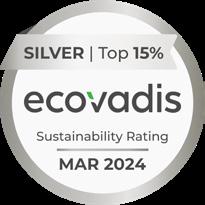
Sustainable Procurement, reflects Falpi's commitment to collaborating with suppliers who share its sustainability values and social responsibility. The company actively promotes sustainable supply chain practices, working with partners who adopt ethical and environmentally responsible practices.
“We are interested in using the rating issued by ECOVADIS - Andrea Loro Piana, CEO Falpi - as a reference point, as a starting point for continuous improvement in the sustainability of our actions.
per Falpi che adotta politiche e procedure etiche che guidano le sue decisioni e le sue azioni, garantendo trasparenza, integrità e conformità legale in tutte le sue attività. Infine, il quarto parametro, gli Acquisti Sostenibili, riflette l'impegno di Falpi nel collaborare con fornitori che condividono i suoi valori di sostenibilità e responsabilità sociale. L'azienda promuove attivamente la catena di approvvigionamento sostenibile, lavorando con partner che adottano pratiche etiche e ambientalmente responsabili.
“Siamo interessati ad utilizzare il rating rilasciato da Ecovadis - dichiara Andrea Loro Piana, AD Falpi - come punto di riferimento, come base di partenza per un miglioramento continuo nella sostenibilità delle nostre azioni”.
falpi.com
sponsored content
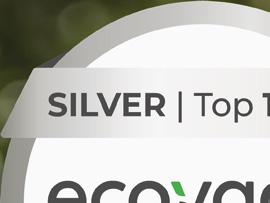
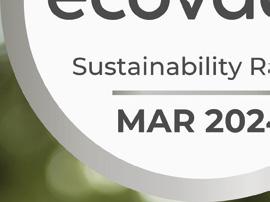






VISIT FALPI 01.407
hygenia.it sponsored content
Hygenia, solutions for a safer and cleaner future
In the realm of technological hygiene solutions, Hygenia emerges as a distinguished leader, offering cutting-edge products tailored to various sectors. With a history of innovation spanning de-
cades, Hygenia has solidified its position as a premier manufacturer of advanced hygiene solutions.
This range of products is the result of the work of Hygenia Lab, a dedicated

research and development center distinguished for its excellence in pioneering hygiene solutions. Among its projects is Hygenia Area Control, a system integrated into the dispenser that continuously monitors the quality of the sanitary environment. Through real-time monitoring of a series of parameters, it sends alerts to operators when cleanliness standards are not met, enabling prompt intervention to maintain a safe environment.
And then there's Hygenio, which has transformed a traditional mop into a sophisticated detection system, utilizing sensors and specialized algorithms to provide real-time analysis of cleaning effectiveness. This contributes to maintaining hygienically safe environ-

ments, safeguarding the health of patients and operators alike.
With a focus on research and development, Hygenia continues to push the boundaries of technological innovation in the hygiene sector, promoting progress and establishing new industry standards.
In a world increasingly focused on health and hygiene, Hygenia leads the way, providing reliable solutions for a safer and cleaner future.
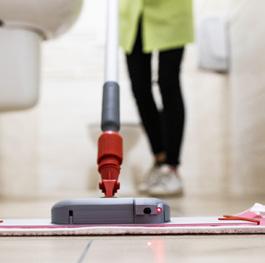
Hygenia, soluzioni per un futuro più sicuro e più pulito
Nel panorama delle soluzioni tecnologiche per l'igiene, Hygenia emerge come un leader distinto, offrendo prodotti all'avanguardia su misura per vari settori. Con una storia di innovazione che si estende per decenni, Hygenia ha consolidato la sua posizione come produttore di punta di soluzioni igieniche avanzate.
Questa gamma di prodotti rappresenta il frutto del lavoro della società Hygenia Lab, un centro dedicato alla ricerca e sviluppo che si distingue per l'eccellenza nell'ideazione di soluzioni igieniche all'avanguardia.
Tra i suoi progetti: Hygenia Area Control, un sistema incluso nel dispenser che monitora costantemente la qualità dell'ambiente sanitario. Attraverso il monitoraggio in tempo reale di una serie di parametri, invia avvisi agli operatori quando gli standard di pulizia non vengono rispettati, consentendo un intervento tempestivo per mantenere la sicurezza dell'ambiente.
E Hygenio, che ha trasformato un Mop tradizionale in un sofisticato sistema di rilevamento, che utilizza sensori e algoritmi specializzati per fornire analisi in tempo reale
sull'efficacia della pulizia. Questo contribuisce a mantenere gli ambienti sanitari igienicamente sicuri, proteggendo la salute di pazienti e operatori.
Con un focus sulla ricerca e sviluppo, Hygenia continua a spingere i limiti dell'innovazione tecnologica nel settore dell'igiene, promuovendo il progresso e stabilendo nuovi standard di settore. In un mondo sempre più attento alla salute e all'igiene, Hygenia si pone all'avanguardia, fornendo soluzioni affidabili per un futuro più sicuro e più pulito.
Essecinque. Attention to customer’s requests and constant research
Essecinque has been manufacturing cleaning products in cotton and other textile fibers since 2005 and over the years it has built established partnerships with manufacturers of related equipment. The catalogue is wide and varied, it includes mops, flat mops (with hook and loop fastening system, pockets or flaps), cloths, handles, trolleys, windows equipment. The attention to customer’s requests and the constant research for new solutions make Essecinque a flexible company, even for particular needs.
Furthermore, private label items are realizable, in order to guarantee a personalized product with the customer’s own logo.
Introducing some of Essecinque products
Professional non woven mop, twisted thread – colored band
This mop is perfect for cleaning every type of floor and environment, for a practical and effective cleaning experience. Non woven fabric has a high absorbent capacity. In the twisted thread version it is more resistant
to washing. The mop can be of various weights and it is possible its customization, thanks to the customer private label sewn onto the product.
The central band is available in different colours: in this way the product is classified according to the specific use.
Looped-end flat mop, cotton and microfiber
This flat mop allows a perfect cleaning experience thanks to the particular interweaving between Microfiber and Cotton. Microfiber
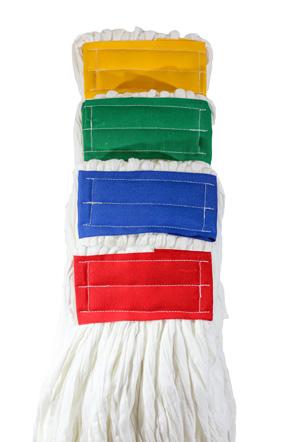
effectively removes dirt and dust, at the same time the cotton allows the product to maintain the right humidity, keeping the mop wet for longer and allowing it to clean several meters of surface.
The hook and loop fastening system ensures a perfect fit to the frame, reaching every corner, and the user can easily replace the mop in order to wash it.
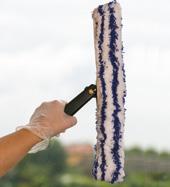
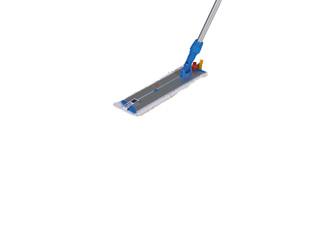



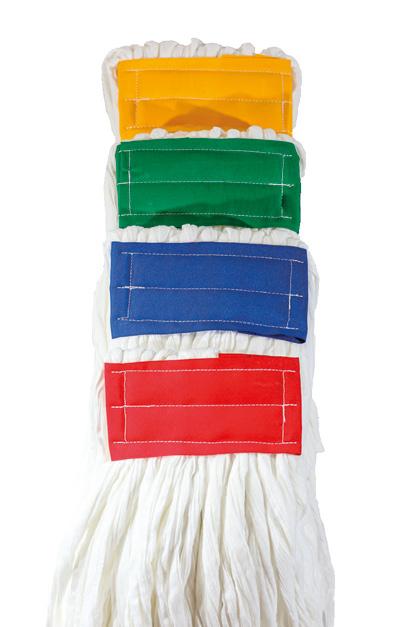


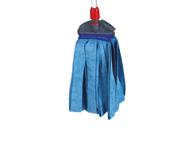
essecinque.net sponsored content
Quality and reliability made in Ghibli & Wirbel

Ghibli & Wirbel SpA is an Italian worldwide leading manufacturing company specialised in the development and production of professional cleaning machines. With more than fifty five years of history, it is a leading player in the Euro-
pean cleaning business. All products are developed and produced in their entirety within the manufacturing plant located in Northern Italy.
A wide range of products for cleaning indoor environments: vacuum cleaners,
spray-extraction cleaners, steam generators, single discs, sweepers and scrubber dryers characterized by sturdiness, efficiency and ease of use.
The company embraces all the Italian manufacturing traditional values, passion for
work and for the renowned “Made in Italy”. It operates in order to reach quality, technological and design innovation, and to guarantee reliability at a production and commercial level.
Constant investment in Research and Development enables Ghibli & Wirbel to conceive and manufacture products every year that stand out for quality and reliability.
The company’s focus is on its own customers. The prompt response to the always growing market requirements and the best customer satisfaction are the main goals. Qualified technical assistance, capable backoffice services, technical and commercial trainings are fundamental features for a continuous support and update to customers, authorized distributors and dealers.
Qualità e affidabilità firmate Ghibli & Wirbel
Ghibli & Wirbel S.p.A. è un’importante realtà industriale italiana specializzata nello sviluppo e nella produzione di macchine per la pulizia professionale. Grazie a più di 55 anni di esperienza, rappresenta oggi uno dei principali attori del settore del cleaning in Europa.
Tutti i prodotti sono completamente sviluppati e realizzati presso l'impianto produttivo del nord Italia.
Un’ampia gamma di macchine per la pulizia interna: aspiratori, lavamoquette, generatori di vapore, monospazzole,
spazzatrici e lavasciuga pavimenti caratterizzate da robustezza, efficienza e semplicità d’utilizzo.
L’azienda incorpora al meglio tutti i valori dell’imprenditoria italiana, la passione per il lavoro e la qualità del Made in Italy. Da sempre opera in una logica di innovazione tecnologica e di design, di serietà e coerenza a livello produttivo e commerciale. I costanti investimenti in Ricerca e Sviluppo permettono a Ghibli & Wirbel di progettare e realizzare ogni anno prodotti che si distinguono per qualità ed
affidabilità.
L’azienda mette al primo posto l’attenzione nei confronti dei propri clienti attraverso la pronta risposta alle sempre crescenti esigenze del mercato e il raggiungimento della migliore customer satisfaction. L’assistenza tecnica qualificata, i servizi di backoffice competenti, i corsi di formazione tecnica e commerciale, inoltre, sono caratteristiche fondamentali per un supporto continuo e un aggiornamento costante per clienti, distributori e rivenditori autorizzati.
ghibliwirbel.com
sponsored content
ROYAL 15
THE COMPACT SCRUBBER DRYER WITH AN INNOVATIVE AND TRULY UNIQUE DESIGN!
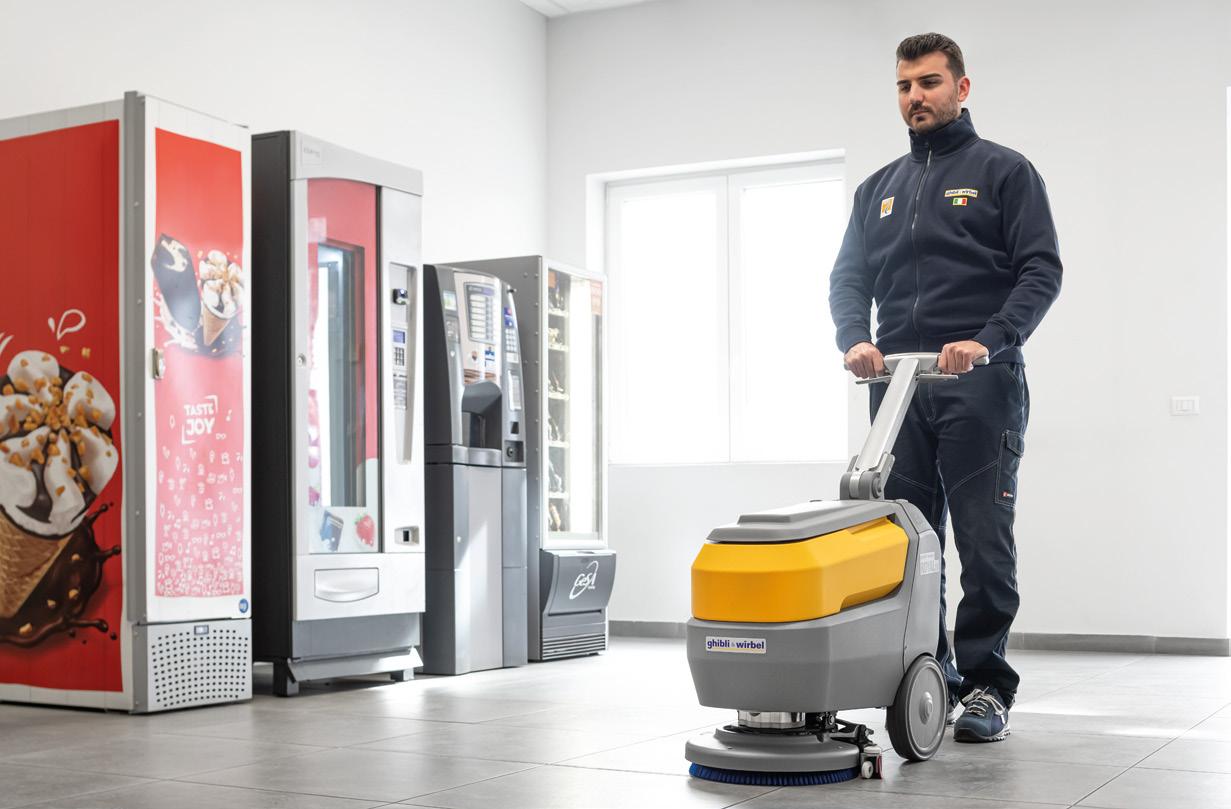
Royal 15 is the compact walk-behind scrubber dryer ideal for cleaning small and medium-sized surfaces such as stores, laboratories, offices and restaurants and which, thanks to its 15-liter capacity and 385 mm cleaning width, guarantees an output of up to 1.540 m2/h.
The meticulously thought-out design is tailored to make this machine extremely compact and easy to handle, while at the same time providing top-notch professional performance to ensure excellent cleaning results, even in the tightest spaces.

This scrubber dryer is the ideal machine for working on all types of floors, even the most difficult ones (such as concrete, bolted, non-slip surfaces), ensuring excellent cleaning results.
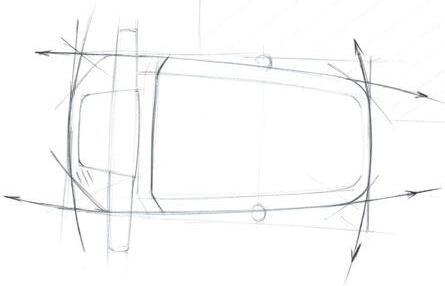
Ghibli & Wirbel S.p.A. Via Circonvallazione, 5 27020 Dorno PV - Italia P. +39 0382 848811 - F.+39 0382 84668 M. info@ghibliwirbel.com RIELLO INDUSTRIES GROUP 100% MADE IN ITALY WWW.GHIBLIWIRBEL.COM
ICA. Constant innovation and focus on the environment
Operating on the national and international market for 40 years, ICA is a paper converting company specialised in Away-from-Home products. Committed to constantly expanding wide range of products in a perspective of constant innovation and focus on the environment to offer products
that are more and more performing, hygienic, and sustainable.
ICA presents the compact collection with dispensers: the ideal solution for washrooms where space is limited. Our 2-ply compact towel is soft, absorbent and above all practical with its 5 x 5 cm folds that make it
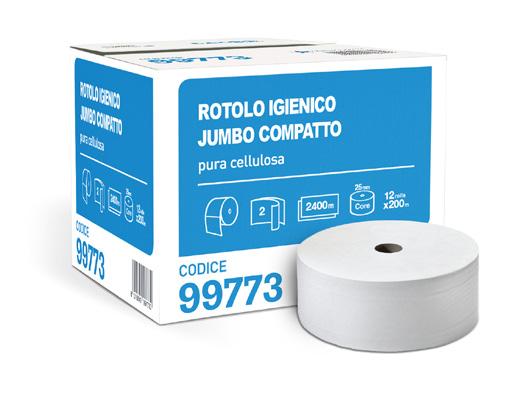
the narrowest in its class. Its dispenser is only 8 cm deep so it is the ideal solution for bathrooms and work areas where space is limited and where the installation of a traditional dispenser would undermine the functionality and liveability of the environment. The 5-fold design also promotes hygiene by
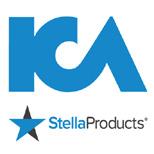
offering a single sheet dispensing, where users only touch the sheet they take. Our two-ply pure pulp compact toilet paper is suitable for demanding high traffic washrooms. Its small core (only 2,5 cm diameter), its compactness and its double-capacity dispenser reduce run-outs and refills.

ICA. Innovazione continua e attenzione per l’ambiente
Presente da 40 anni sul mercato nazionale e internazionale, ICA è un’azienda di trasformazione carta tissue, specializzata nella produzione di prodotti Away-from-Home. L’impegno è rivolto al costante ampliamento della vasta gamma in un’ottica di continua innovazione e di particolare attenzione per l’ambiente per offrire ai clienti prodotti sempre più performanti, igienici e sostenibili.
ICA presenta i compatti con dispenser: la
soluzione ideale per servizi igienici e toilette dagli spazi ridotti. Il compact towel è morbido, assorbente e soprattutto pratico con le sue 5 pieghe da 5 cm che lo rendono il più stretto della categoria. Il suo dispenser è profondo solo 8 cm ed è la soluzione ideale per tutti i servizi igienici e le aree di lavoro in cui lo spazio è limitato e in cui l’installazione di un dispenser tradizionale andrebbe a minare la funzionalità e la vivibilità dell’ambiente. Il design a cinque pieghe
promuove anche l’igiene tramite l’erogazione singola grazie alla quale si tocca solo il foglietto che si usa. L’igienica compatta, in pura cellulosa a due veli, è particolarmente adatta per le aree bagno ad alta affluenza. L’anima di dimensioni ridotte (solo 2,5 cm), la compattezza del rotolo e il dispenser dedicato a doppia capacità comportano un minor rischio di esaurimento della carta, riducendo la frequenza di ricarica e manutenzione.
icatissue.com
sponsored content

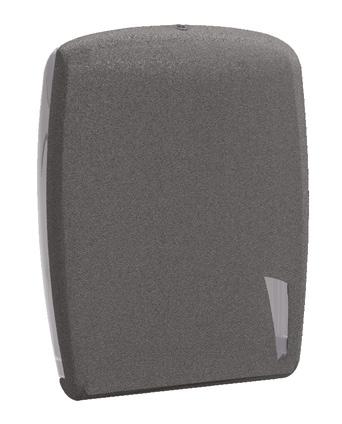

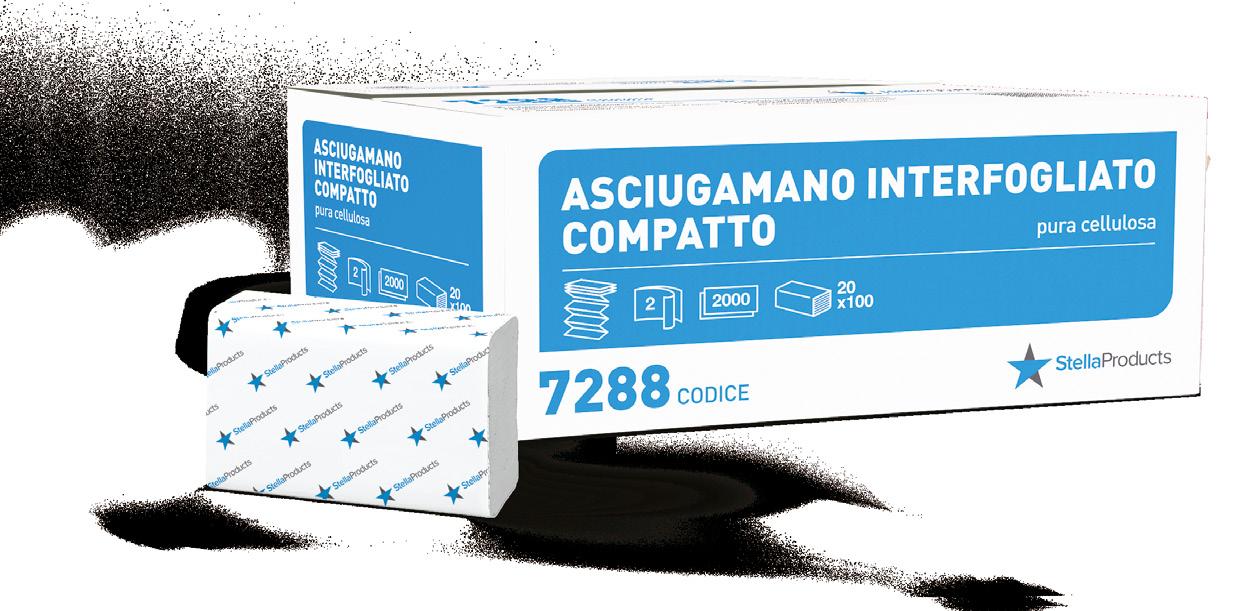
Mr Shield PRO TECH: made in Italy solutions for healthy and safe environments
Indupharma, a leading company in the cleaning and pest control market, presents the most effective answer for hygiene and care of environments: Mr Shield PRO TECH, the first complete line of cleaning, sanitizing, disinfecting and pest control products aimed at professional, industrial and Ho.Re. Ca. cleaning specialists. Thanks to the industrial and research capacity of Indupharma, which with the purchase of Italchimes in 2022 took up the challenge of entering the professional cleaning sector, Mr. Shield PRO TECH offers solutions that guarantee high-quality results.
Mr Shield PRO TECH is a groundbreaking innovation, formulated and designed entirely in Italy, by professionals for professionals. Indeed, its wide range of products stems from an in-depth knowledge of the cleaning and pest control market, as well as an awareness of the specific problems and practical needs of professional cleaners.
"Mr Shield PRO TECH is an ambitious project, which originated from a high aspiration shared by our whole company: to guarantee people's well-being
every day through healthy and safe environments"
comments Debora Cazzaro, Indupharma General Sales Manager. "This is why, we developed the first complete line of professional solutions for hygiene and pest control that, starting from the real needs of the users, aims at simplifying their daily work, offering the best specific answer to each problem."
The eight product lines that make up the Mr Shield PRO TECH range meet all the needs of the professional cleaning industry: from detergents for everyday use to those formulated for specific problems; from disinfectants, bactericides and virucides, to pest control and rodenticides, to the Garden line and a wide range of accessories and UV lamps.

Mr Shield PRO TECH: soluzioni made in Italy per ambienti sani e sicuri
Indupharma, azienda leader nel mercato della detergenza e della disinfestazione, presenta la risposta più efficace per l’igiene e la cura degli ambienti: Mr Shield PRO TECH, la prima linea completa di prodotti detergenti, igienizzanti, disinfettanti e disinfestanti che si rivolge agli specialisti del settore pulizie professionali, industriali e Ho.Re.Ca. Risultato della capacità produttiva e di ricerca di Indupharma, che con l’acquisto di Italchimes nel 2022 ha raccolto la sfida di entrare nel settore dei detergenti professionali, Mr. Shield PRO TECH offre soluzioni che garantiscono risultati di alta qualità. Mr Shield PRO TECH è una novità dirompente, formulata e progettata
interamente in Italia, dai professionisti per i professionisti. La sua ampia gamma di prodotti nasce infatti da una profonda conoscenza del mercato della detergenza e della disinfestazione, oltre che dalla consapevolezza delle problematiche specifiche e delle esigenze pratiche dei professionisti del settore delle pulizie professionali.
“Mr Shield PRO TECH è un progetto ambizioso, che parte da un’aspirazione alta e condivisa da tutta la nostra azienda: garantire ogni giorno il benessere delle persone attraverso ambienti sani e sicuri” commenta Debora Cazzaro, General Sales Manager Indupharma. “Per questo motivo abbiamo sviluppato la prima linea comple-
ta di soluzioni professionali per l’igiene e la disinfestazione che, partendo dalle reali necessità degli utilizzatori, punta a semplificare il loro lavoro quotidiano, offrendo ad ogni problema la migliore risposta specifica”.
Le otto linee di prodotti che compongono la gamma Mr Shield PRO TECH rispondono a tutte le necessità del settore delle pulizie professionali e della sanificazione: dai detergenti per uso quotidiano a quelli formulati per problematiche specifiche; dai prodotti disinfettanti, battericidi e virucidi, ai disinfestanti e rodenticidi, fino alla linea Garden e un’ampia gamma di accessori e lampade UV.
indupharma.eu
sponsored content
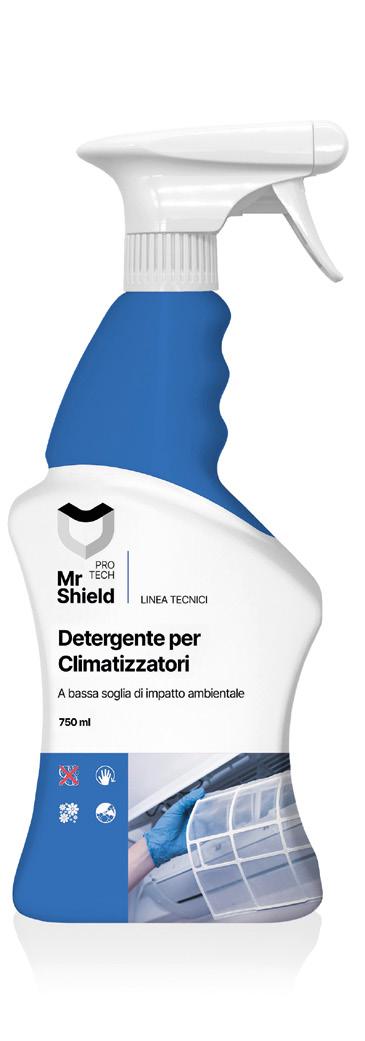

Discover
Sustainable Cleaning Solutions: IPC by Tennant Company’s Commitment to Environmental Innovation
IPC by Tennant Company is working to reinvent the way the world cleans by embedding sustainability across our business while continuing to focus on developing innovative solutions that solve our customers’ biggest challenges. We offer numerous cleaning solutions to help our customers achieve their sustainability goals. Including electrically powered equipment, wa-












zero, we plan to make deep emissions cuts across our operations and value chain, including emissions from the use of our products.
We’ve obtained certifications and labels to help customers identify these sustainable products to incorporate them into their cleaning programs and support their company’s sustainability goals.
Certifications include ISO



















ducts. Product labels include the EU Ecolabel, which recognizes products with reduced environmental impact throughout their life cycle while maintaining high-performance standards. Additionally, our registered trademark, Black is Green™, identifies the usage and the amount of recycled plastic in our vacuums and cleaning tools products. The amount of recycled plastic used for IPC cleaning tools varies from 15% to 100%.




We are also excited to announce the upcoming launch of our latest innovation: to meet the demand for sustainable recycled products in lighter shades, we will introduce light grey recycled plastic options in our Brix School, Brix PT, and PT range. This addresses the market’s need for eco-friendly materials in brighter hues, suitable for spaces where darker colours may not be suitable.
On the product side we
are introducing EKOS: the new smart, safe and environmentally friendly instant saturation system recently launched on the market. Its precision-designed nozzles minimize detergent waste by saturating only necessary cloths when needed, eliminating unnecessary expenses, and reducing environmental impact. EKOS embodies a sustainable approach to cleaning, offering companies a cost-effective solution and minimizing en vironmental impact.




Sustainability web page: https://www.ipcworldwide. com/sustainability/



L’impegno di IPC by Tennant Company per una pulizia sostenibile e innovativa
IPC by Tennant Company si impegna a rendere la pulizia sostenibile e innovativa, offrendo soluzioni eco-compatibili come attrezzature elettriche, prodotti a basso consumo d’acqua e riciclati. Per aiutare i nostri clienti a identificare que -
sti prodotti sostenibili, abbiamo ottenuto certificazioni come ISO 14067 e REMADE in Italy®. Il nostro marchio Black is Green™ indica l’uso di plastica riciclata nei nostri prodotti. Presto lanceremo plastica rigenerata colorata.
Abbiamo introdotto anche EKOS: un sistema di saturazione istantanea intelligente ed ecologico che minimizza lo spreco di detergenti e riduce le spese, promuovendo una pulizia sostenibile e efficiente.



ipcworldwide.com
sponsored content
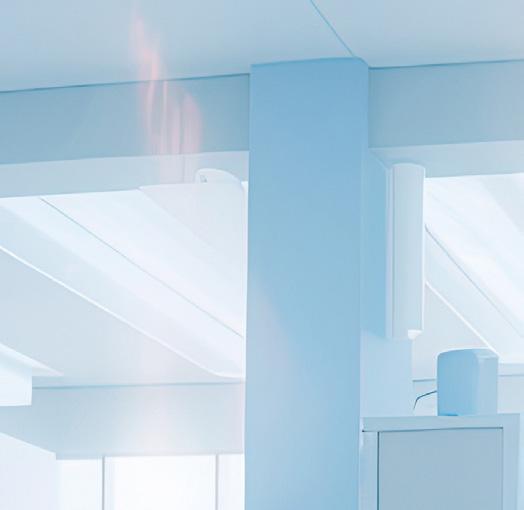

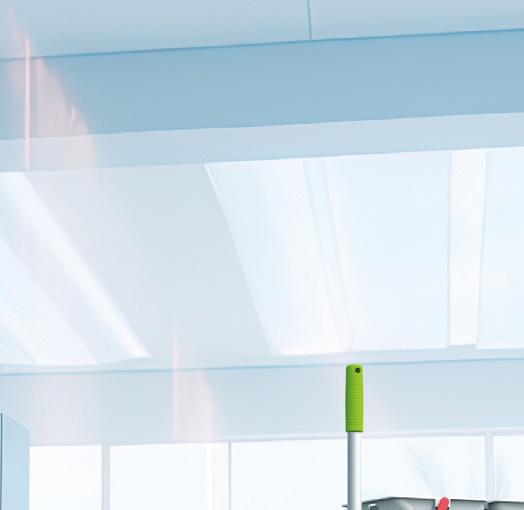
EFFICIENZA SOSTENIBILE

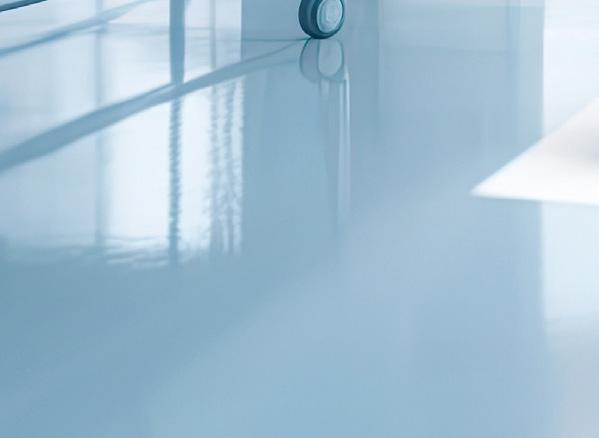

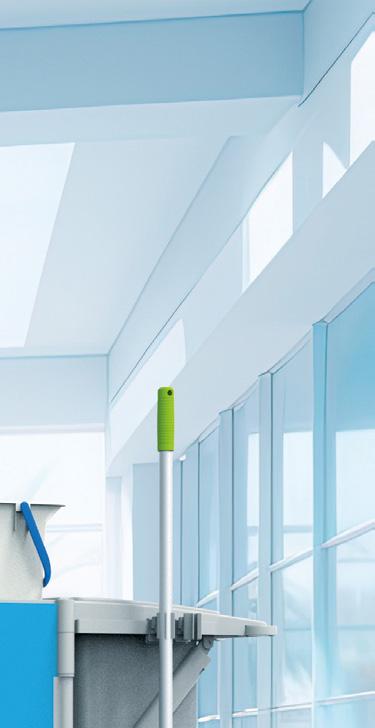
IPC by Tennant Company continua a ricercare materiali innovativi che soddisfino i criteri di sostenibilità e mantengano elevati standard di qualità. Presentiamo il rinnovato carrello della gamma PT, appositamente progettato per la pulizia sanitaria.




























Realizzato con materiali riciclati, questo carrello grigio "seta" è elegante, pratico e dotato di porte con serrature per garantire massima sicurezza e discrezione. Offre tutte le funzionalità necessarie per una pulizia efficiente e risponde alle esigenze CAM.








DIMENSIONE PULITO | 03/2024
Scopri la linea completa di carrelli e accessori: www.ipcworldwide.com/it/prodotti/carrelli/#brix IPC Tools SpA, Via dell'Artigianato II, 1 35010 Villa del Conte (PD) S w 135010VilladelConte (PD) pAViadell'ArtigianatoII1135010Villa IPC T l S A Vi d ll'A
Effectiveness and Safety in Disinfection
Even in professional area, there is sometimes confusion between ordinary and extraordinary cleaning and disinfection. According to the definition of the Italian Ministry of Health, disinfection is the treatment aimed at reducing the microbial load of environments, surfaces, and materials, which must be carried out with professional disinfectants or products authorized by the Ministry as “Presidio Medico Chirurgico”.
ORMA, with over 40 years of experience in the Pest Control and Environmental Hygiene sector, is committed to providing innovative solutions to ensure safe environments in every professional sector.
For this reason, among the
numerous products available in the catalog, ORMA has created Sanitizer, a line of solutions certified as “Presidio Medico Chirurgico”. Based on Quaternary Ammonium Salts, the line provides a full control on bactericidal, fungicidal, and virucidal infestation.
The Sanitizer line is available in three aerosol can forms, designed to suit many various usage needs.
The 500 ml can offer practical and versatile use, intended for surface disinfection.
The 250 ml can, equipped with a metered valve, is perfect for use with timed automatic diffusers, ensuring an accurate distribution of the product, ideal for air disinfection.
Last but not least, the 150
Efficacia e sicurezza nella disinfezione
Anche in ambito professionale, a volte si fa confusione tra pulizia - ordinaria e straordinaria - e disinfezione. Secondo la definizione del Ministero della Salute, la disinfezione è il trattamento fatto per abbattere la carica microbica di ambienti, superfici e materiali che va effettuata con disinfettati professionali ad azione biocidi o prodotti autorizzati dal Ministero come Presidi Medici Chirurgici. ORMA, da oltre 40 anni nel settore del Pest Control e dell’Igiene Ambientale, si impegna a fornire soluzioni innovative per garantire ambienti sicuri in ogni settore professionale. Per questo, tra i numerosi prodotti presenti in catalogo, ORMA ha creato la Linea Saniti-
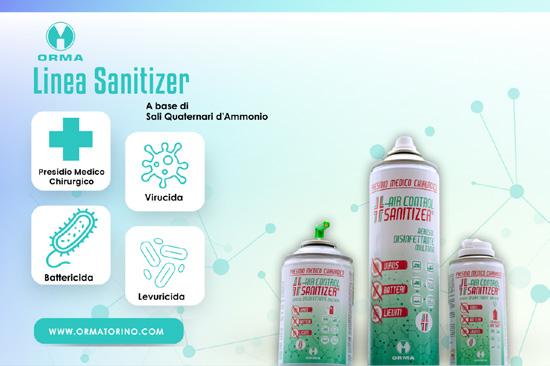
ml can disposable use (oneshot) ensures a quick and targeted action for the situations requiring an immediate intervention for an area up to 75 cubic meters.
The Sanitizer Line can be used in civilian (warehouses, schools, cinemas, shops, hotels and accommodations, gyms, kitchens, restaurants,
zer, un Presidio Medico Chirurgico a base di Sali Quaternari d'Ammonio, progettato per garantire un'efficacia battericida, levuricida e virucida.
La linea Sanitizer è disponibile in tre formati di bombole aerosol, pensati per adattarsi alle diverse esigenze di impiego.
La bombola da 500 ml offre un utilizzo pratico e versatile, pensato per la disinfezione delle superfici. Quella da 250 ml, dotata di valvola dosata, è perfetta per l'impiego con diffusori automatici temporizzati, garantendo una distribuzione uniforme del prodotto, ideale per la disinfezione dell’aria. Infine, la bombola da 150 ml con valvola a svuota-
cafeterias, restrooms, etc.), domestic, and healthcare settings, in public buildings, in industry (including food industry), inside transportation vehicles, and in ventilation systems.
ORMA's technical sales team is available to support customers choosing the best solutions for their needs.
mento totale (one-shot) assicura un'azione rapida e mirata per situazioni che richiedono interventi immediati per un’area fino 75 metri cubi.
La Linea Sanitizer può essere utilizzata in ambito civile (magazzini, scuole, cinema, negozi, alberghi e strutture ricettive, palestre, cucine, ristoranti, mense, servizi igienici), domestico e sanitario, in edifici pubblici, nell'industria (anche in quella alimentare), all’interno dei mezzi di trasporto e negli impianti di areazione. Il team tecnico commerciale di ORMA è a disposizione per supportare i clienti nella scelta delle migliori soluzioni per le proprie esigenze.
ormatorino.com
sponsored content

PAPERDI. High-quality products to protect the consumer and the environment
'Green Economy' means orienting our actions towards behaviour that allows maximum respect for the environment, in all sectors; a respected environment guarantees 'ethical soil' and contributes more than any other activity to the quality of life.
Paperdi has always been convinced of the importance of the qualitative and environmental aspects of the market in which it operates, so much so that it was one of the first companies in
Italy to launch its own line of ecological products with the Ecogreen brand, made of 100% recycled paper and destined for all community and industrial operators. The production cycle with reduced environmental impact has enabled Paperdi to obtain the Ecolabel certification.
The success of Ecogreen's ecological disposable paper products and the constant growth in market demand have allowed the company to increase the range of its ecological line, which includes reels, jumbo rolls, interleaved towels, roll towels and medical sheets. The satisfactory and growing inclusion of Ecogreen products in the professional sector is the best proof
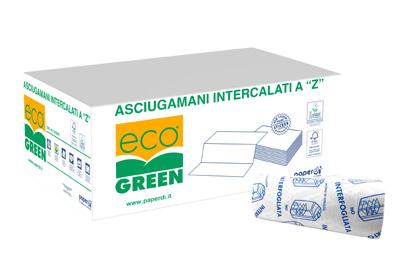

that environmental policies and strategies are positively received by the market. The protection of the environment and the low enviromental impact of the products in range finds maximum expression in the All in papaer project, with the change of all the packaging of Z-folded hand towels from plastic to paper.
Paperdi AZ.118/3000 made of 100% recycled Tissue,
Ecolabel and FSC certified, recyclable and compostable paper packaging is the green product par excellence: zero environmental impact, high quality. A product that facilitates the dispenser refilling process and helps the operator to do his job quickly, using a single container to dispose of waste. A high quality product that protects the consumer and the environment.
PAPERDI. Prodotti di alta qualità a tutela del consumatore e dell’ambiente
Green Economy” significa orientare la nostra azione a comportamenti che consentano il massimo rispetto dell’ambiente, in tutti i settori; un ambiente rispettato garantisce un “suolo etico” e contribuisce più di qualsiasi altra attività alla qualità della vita. Paperdi è da sempre convinta dell’importanza che rivestono gli aspetti qualitativi e ambientali del mercato in cui opera, tanto che è stata tra le prime aziende in Italia a lanciare una propria linea di prodotti ecologici a marchio Ecogreen, realizzati in carta riciclata al 100% e destinati a tutti gli operatori del settore comunità e industria. Il ciclo produttivo a ridotto impatto ambientale, ha
permesso a Paperdi di ottenere il marchio di qualità ecologica Ecolabel. L’affermazione dei prodotti monouso in carta ecologica Ecogreen e la costante crescita di richiesta del mercato hanno consentito all’azienda di incrementare la gamma della linea ecologica che comprende bobine, jumbo roll, asciugamani intercalati, asciugamani a rotolo e lenzuoli medici. Il soddisfacente e crescente inserimento dei prodotti Ecogreen nel settore professionale è la migliore testimonianza che le politiche e le strategie ambientali sono positivamente accolte dal mercato. La salvaguardia dell’ambiente e il low enviromental impact dei prodotti in gamma trova
massima espressione nel progetto All in paper, con la conversione di tutti i packaging degli asciugamani piegati a Z dalla plastica alla carta.
L’articolo Paperdi AZ.118/3000 realizzato con Tissue riciclato 100%, certificato Ecolabel ed FSC, packaging in carta riciclabile e compostabile è il prodotto green per eccellenza: zero impatto ambientale, alta qualità. Un prodotto che facilita il processo di ricarica del dispenser e aiuta l’operatore a svolgere il proprio lavoro velocemente, utilizzando un unico contenitore per smaltire i rifiuti. Un prodotto di alta qualità a tutela del consumatore e dell’ambiente.
paperdi.it sponsored content

Paredes, a story that began 80 years ago
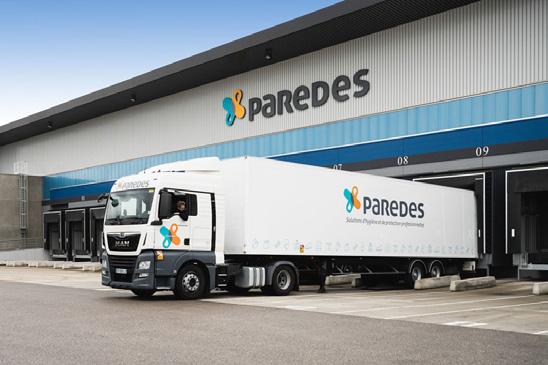
Paredes’ transformation began in 2017 with a new management, ably led by Francois Thuilleur, who launched an ambitious restructuration plan. Their growth since then has been constant and is set to continue with their new development plan Cap N°1, whose goal is to become one of the top three of the European market.
Paredes has celebrated 80 years of service to the pro-
fessional hygiene market having grown from a family business to a Group of €220 million turnover, 650 collaborators, 2 production sites and 16 commercial and logistic sites spread between France and Italy. Their history contains important milestones such as the invention of the first single-use, paper roll for hygienic purposes and the first auto cut dispenser for hand towels.
La trasformazione di Paredes è iniziata nel 2017 con un nuovo management, abilmente guidato da Francois Thuilleur, che ha avviato un ambizioso piano di ristrutturazione. Da allora la crescita è stata costante ed è destinata a continuare grazie al piano di sviluppo Cap N°1, il cui obiettivo è quello di far diventare Paredes una delle prime tre aziende del mercato europeo. L’azienda ha da poco festeggiato 80 anni di servizio nel mercato dell'igiene professionale, passando da una dimensione familiare a un Gruppo con 220 milioni di euro di fatturato, 650 collaboratori, 2 siti produttivi e 16 siti commerciali e logisti-
The modernisation of their commercial activities include the development of their e-shop that, paired with experts divided by client sector to consult on the most appropriate solutions for their clientele, is garnering considerable success. Paredes has always been an active spokesperson for social and environmental issues since the launch of its Eco Attitude in 1995. These solid foundations have been built upon with the adhesion to the UN Global Compact in 2017, a Platinum EcoVadis Sustainability Rating, Social Accountability and Carbon Footprint certification for its products, to name but a few of its CSR initiati-
ves.
This development has launched Paredes to the position of modern front-runner on the European hygiene market. In fact, its development over the next few years will reach further afield; the Group is currently opening up the Swiss, German and Benelux markets. Paredes has come a long way since its birth and their client-centric approach is greatly appreciated and looks set to confirm its growth in the years to come.
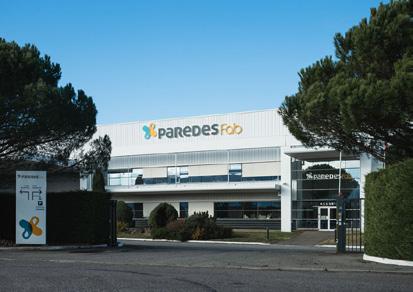
ci distribuiti tra Francia e Italia. La sua storia contiene importanti pietre miliari come l'invenzione del primo rotolo di carta monouso per scopi igienici e il primo dispenser a taglio automatico per asciugamani. Uno sviluppo che comprende la creazione dell'e-shop che, con la presenza di esperti suddivisi per settore di clientela per consigliare le soluzioni più adatte alla clientela, sta riscuotendo un notevole successo. Da non dimenticare che Paredes è sempre stato portavoce attivo di tematiche sociali e ambientali, fin dal lancio della sua Eco Attitude nel 1995. Queste solide fondamenta
sono state costruite con l'adesione al Global Compact delle Nazioni Unite nel 2017, un rating di sostenibilità EcoVadis di platino, la certificazione di responsabilità sociale e di impronta di carbonio per i suoi prodotti, per citare solo alcune delle sue iniziative di CSR. Percorso che ha portato Paredes nella posizione di leader del mercato europeo dell'igiene: il Gruppo sta attualmente aprendo i mercati svizzero, tedesco e del Benelux. Paredes ha fatto molta strada dalla sua nascita e il suo approccio incentrato sul cliente è molto apprezzato e sembra destinato a confermare la sua crescita negli anni a venire.
paredes.fr | paredes.it sponsored content
Paredes, una storia che ha inizio 80 anni fa
Sustainability is a concrete commitment for RCM
In a world where climate change has become an undeniable reality, it is essential that everyone plays its part to protect the environment. Responsible management of water use is one of the most important parts, especially now with such dry winters that bring to an increasing shortage of water resources. In the working environment, it is fundamental to adopt practices that reduce the waste of water and other materials. A sustainable approach to cleaning and maintenance processes is essential in order to reduce the environmental impact and to contribute to protect natural resources.
RCM, a leading company in the field of professional
cleaning machines, has been committed for years to producing innovative solutions that guarantee an efficient cleaning, which really reduces the environmental impact and generates profit for the companies at the same time. Among the technologies adopted by RCM to achieve this goal, the one that stands out is the AQUA SAVER system.
AQUA SAVER is a system that allows you to optimize water use during cleaning operations, reducing waste to a minimum while ensuring a flawless result. This system is integrated into most RCM scrubbers, both walk-behind and ride-on, and allows you to adjust water usage according to your specific cleaning needs. Thanks to the AQUA SAVER system, it is possible to significantly reduce the water and detergent usage during cleaning operations, thus increasing working autonomy and reducing operational costs. Moreover, this system contributes to limiting the environmental impact. At a time when environmental sustainability has become a global priority, it is important that companies adopt innovative and
Per RCM la sostenibilità è un impegno concreto
In un mondo in cui il cambiamento climatico è diventato una realtà innegabile, è fondamentale che ogni singolo individuo faccia la sua parte per contribuire a preservare l'ambiente. La gestione responsabile dell'uso dell'acqua è uno degli aspetti più importanti, soprattutto considerando che inverni sempre più secchi stanno portando a una crescente carenza di risorse idriche. Nel contesto lavorativo, è fondamentale adottare pratiche che riducano gli sprechi di acqua e di altri materiali. Avere un approccio sostenibile nei processi di pulizia e manutenzione è essenziale per ridurre l'impatto ambientale e contribuire a preservare le risorse naturali.
RCM, azienda leader nel settore delle mac-
chine per la pulizia professionale, si impegna da anni a produrre soluzioni innovative che garantiscano una pulizia efficace, che riduca realmente l’impatto ambientale e che al contempo generi profitto per le imprese. Tra le tecnologie adottate da RCM per raggiungere questo obiettivo, spicca il sistema AQUA SAVER
AQUA SAVER è un sistema che permette di ottimizzare l'uso dell'acqua durante le operazioni di pulizia, riducendo al minimo gli sprechi e garantendo un risultato impeccabile. Questo sistema è integrato su gran parte delle lavapavimenti RCM, sia quelle uomo a terra che quelle uomo a bordo, e consente di regolare l'utilizzo dell'acqua in base alle esigenze specifiche di pulizia.
sustainable solutions such as AQUA SAVER in order to actively contribute to environmental protection. Every action matters, and investing in technologies that aims to reduce water and energy waste is a concrete step towards a more sustainable and environmentally friendly future.
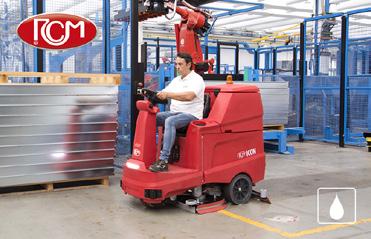
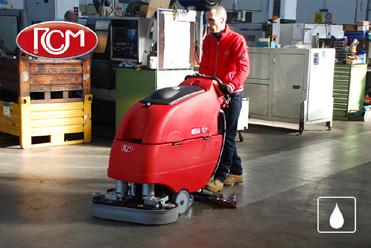
Grazie al sistema AQUA SAVER, è possibile ridurre significativamente il consumo di acqua e di detergente durante le operazioni di pulizia, aumentando così l'autonomia di lavoro e riducendo i costi operativi. Inoltre, questo sistema contribuisce a limitare l'impatto ambientale.
In un periodo in cui la sostenibilità ambientale è diventata una priorità globale, è importante che le imprese adottino soluzioni innovative e sostenibili come AQUA SAVER per contribuire attivamente alla tutela dell'ambiente. Ogni gesto conta, e investire in tecnologie che riducano gli sprechi di acqua e di energia è un passo concreto verso un futuro più sostenibile e rispettoso dell'ambiente.
rcm.it
sponsored content
rubinochem.it
sponsored content
Protection 24H. Protection for up to 24 hours on all surfaces
Rubino Chem is an italian company specialized in the design and production of cleaning and disinfecting solutions for both professional and domestic use. With over 60 years of experience, it operates successfully at both national and international levels. Rubino chem ongoing Research and Development efforts enable it to offer innovative products formulated with high-quality raw materials that meet market needs while being environmentally conscious.
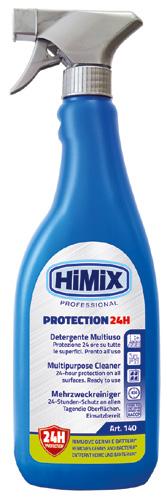
The main requirements for a cleaning product are effectiveness and care for surfaces and individuals;
hence, Rubino Chem has decided to complement its Olé Ressenza line with the HiMiX Professional line, specifically designed for professional cleaning. The new product Protection 24H, proves to be a reliable ally in maintaining high hygiene standards effortlessly and over time.
Protection 24H is a multi-purpose cleaner based on quaternary ammonium salts. Its ready-to-use formula evaporates quickly, leaves no residue, and requires no rinsing. Thanks to its special composition, it effectively removes germs and bacteria with simple mechanical action, providing protection

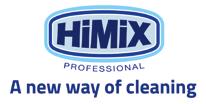
for up to 24 hours on all surfaces, even after touch after touch. The product is certified for use in environments compliant with H.A.C.C.P. standards and can be used across a wide range of sectors, including transportation, the food industry, and the small to large-scale catering sector.
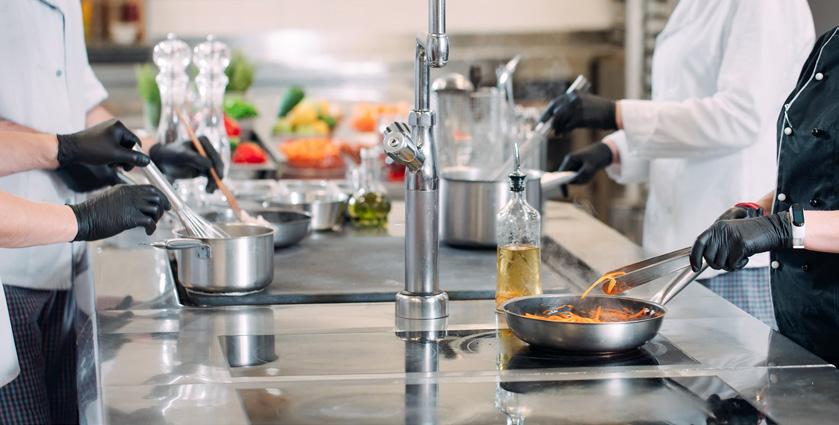
Protection 24H. Protezione fino a 24 ore su tutte le superfici
Rubino Chem è un'azienda italiana specializzata nella progettazione e produzione di soluzioni detergenti e disinfettanti per la pulizia professionale e domestica. Opera con successo a livello nazionale e internazionale, vantando oltre 60 anni di esperienza nel settore. La costante attività di Ricerca e Sviluppo consente di offrire prodotti innovativi, formulati con materie prime di alta qualità che soddisfino le esigenze del mercato e con un occhio di riguardo per l'ambiente.
Le principali caratteristiche richieste a un
prodotto di pulizia sono efficacia e cura delle superfici e della persona; per questo Rubino Chem ha deciso di affiancare alla sua linea Olé Ressenza, la linea HiMiX Professional line, pensata appositamente per la pulizia professionale. Il nuovo prodotto, Protection 24H, si dimostra un alleato affidabile per mantenere alti gli standard igienici in modo facile e duraturo nel tempo. Protection 24H è un detergente multiuso a base di sali d'ammonio quaternario. La sua formula pronta all'uso evapora rapidamente, non lascia aloni e non richiede risciac-
quo. Grazie alla sua speciale composizione, è in grado di rimuovere efficacemente germi e batteri con una semplice azione meccanica, garantendo una protezione fino a 24 ore su tutte le superfici, anche dopo numerose manipolazioni. Il prodotto è certificato per l'utilizzo in ambienti conformi agli standard H.A.C.C.P. e può essere impiegato in una vasta gamma di settori, tra cui il trasporto di persone o merci, l'industria alimentare e il settore della piccola e grande ristorazione.
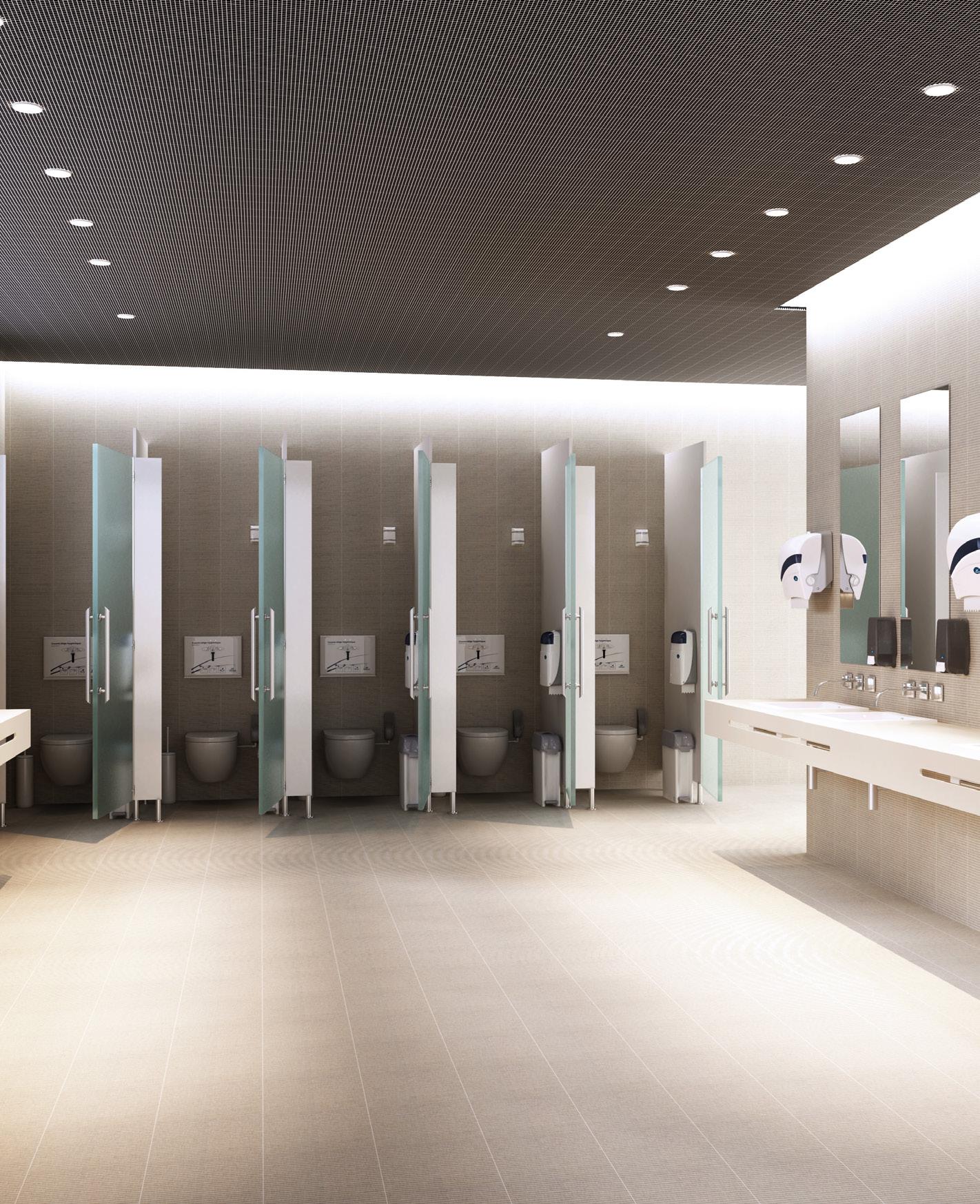
Soluzioni d’igiene e di protezione professionale

Abbiamo creduto per primi nella certificazione Ecolabel perché i nostri standard ne rispettavano già i principi.
I nostri prodotti sono la soluzione migliore per l’ambiente…. ….migliore per te.

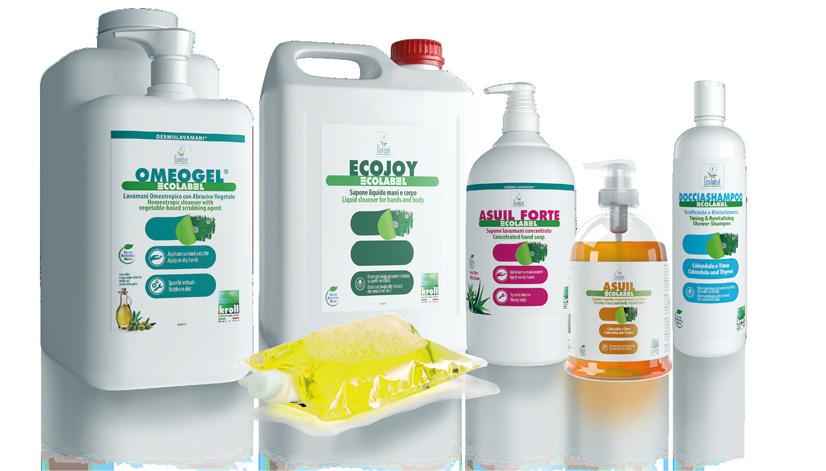

® S.r.l. Via Mazzon, 21 • 30020 Quarto d’Altino (VE) Italy Ph. +39.0422.823794 • kroll@kroll-amkro.com kroll-amkro.com francesconardocomunicativo.com
Innovazione, ecosostenibilità e benessere
EU Ecolabel: IT/030/001











































































 Nicola Fabbri, Senior consultant ERGO Srl
Nicola Fabbri, Senior consultant ERGO Srl


































































































































































































































































































